|
Home
Book Topics Arvhive 2
Book Topics Archive 1

Marcom Award
2007-2008-2009
2010-2011-2012
2013-2014

Videographer Award
2007-2008-2009
2010-2013-2015
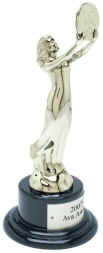
AVA Award Winner
2007-2008-2009
2010-2011-2012
2013-2014-2015
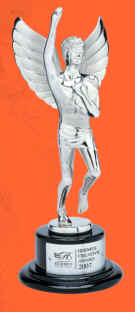
2008-2009-2010
2011-2012-2013
2014
Hermes Creative
Award Winner

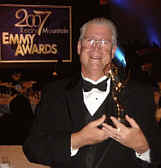
Ed
Sharpe / CouryGraph Productions
Glendale Daily Planet / KKAT-IPTV 2007 EMMY®Award Winner
2007
Rocky Mountain Region Emmy® Award Winner for Breaking News/ Continuing
Coverage
FIRST
IN GLENDALE!

Berkeley Film Festival
Grand Festival
Pioneer In
Television Award
2011

Remi Award Winner
Worldfest Houston
2009 - 2010 -2011

2009 EMPixx Awards
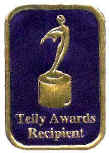
Telly Awards 2006-2007-2008-2009-2010
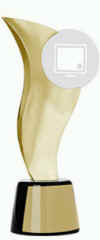
2008 & 2009
Communicator Awards
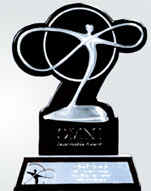
Omni Intermedia Awards
2007-2008-2009

Millennum Awards
2006-2007-2008

Marcom Award
2007-2008-2009
2010-2011-2012
2013-2014
 
W3 Media Awards
2008/2009
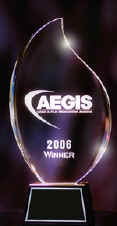
2007/2008/2009 Aegis
Finalists and Winners

Accolade Award Winner
2007-2008-20010

Arizona Assn. of Black Journalists Diversity Winner
2008/2009
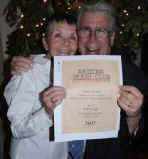
Arizona Press Club Winner
Ed Sharpe,
The Glendale Daily Planet:
Use of Online Media
"Cesar E. Chavez 2007"
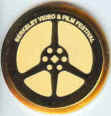
Berekeley Film Festival
2006-2007-2008-
2009-2010-2012
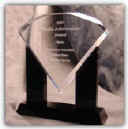
Media Achievement Awards

2008/09 Finalists and Winners - DV Awards


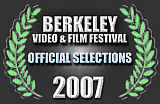
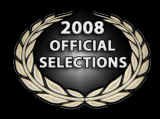
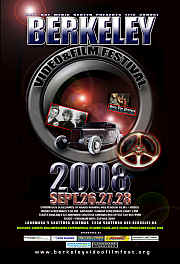

CouryGraph
Productions



CALIFORNIA
HISTORICAL RADIO SOCIETY
IS PLEASED TO HONOR
EDWARD
A. SHARPE
WITH THE
CHARLES D. 'DOC' HERROLD
AWARD FOR
OUTSTANDING ACHIEVEMENT IN
THE PRESERVATION AND DOCUMENTATION OF
EARLY RADIO.
BY
THE BOARD OF DIRECTORS, 1992:


| |
|
AUTHORS
AT THE TEAGUE
Jerry
Foster at Authors @ the Teague
By
Bette Sharpe Glendale Daily Planet
"It
ain’t braggin’ if you’ve done it!"
Jerry
Foster at his Authors @the Teague book signing
on Saturday, March 8, 2014.
The
name Jerry Foster is a familiar name and face to
those who lived in the Valley in the 1980s.
Foster was one of the first pilots to
regularly report the news, traffic and weather
while also piloting a gyro plane or helicopter.
His skills as a helicopter pilot allowed
him to work closely with law enforcement with
search-and-rescue missions.
His involvement in several rescues made
him part of the story, giving him lots of
positive attention from viewers but also a lot
of critics.
News
ratings were good and management knew a ratings
maker when they saw one.
Traditional journalist saw a challenge to
traditional news reporting.
While the FAA did not care for Mr.
Foster’s high-flying style and set out to
ground him. Elementary
school kids wanted him to visit their school,
because he would land in his helicopter!
Pilots
have their swagger and anyone who makes it to
sixty and beyond knows it was not always easy
and not without getting a few bumps and scraps
along the way. Jerry Foster admitted he is a
“hot dog”. In
his memoir, “Earthbound Misfit: Jerry
Foster”, with Dee Dees, he shares his story,
bumps, scrapes and all.
Judging
by the audience at Velma Teague on Saturday, he
is loved and admired, still, by many. Some of
the attendees saw Jerry when he came to their
schools in the 80's!
“He
just does things with a helicopter that a man in
his right mind just wouldn't do.
But
he does it so well he’s perfectly safe.”
Senator
Barry Goldwater – 1988.
---
“Earthbound Misfit: by Jerry Foster”, with
Dee Dees is available at Amazon.com or at local
book signings
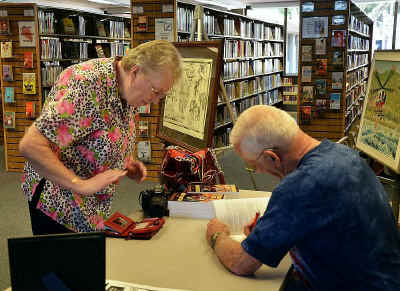
Bette
Sharpe/Glendale Daily Planet no. 5281.
Jennifer
Machamer is getting her book signed by Jerry
Foster. Foster
said on Saturday, March 8, 2014 during his book
signing that one of his most positive memories
are of his many visits to elementary schools and
the kids. One
of many school visits he made was to Jennifer
Machmer’s class.
“It ain’t braggin’ if you’ve done
it!”… Jerry Foster.
“Earthbound
Misfit: by Jerry Foster”, with Dee Dees is
available at Amazon.com or at local book
signings.

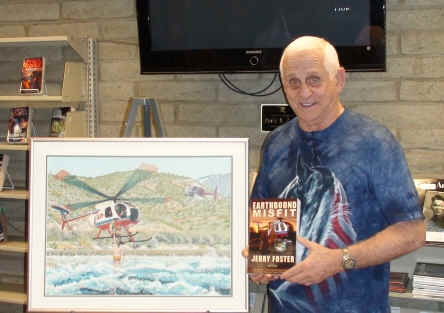
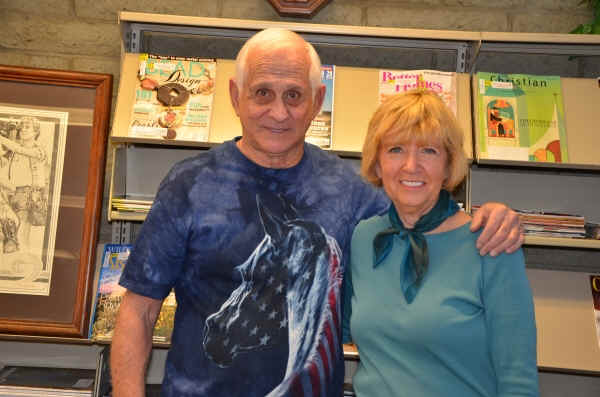
Jerry Foster along with
co-author of his book Dee Dees

 
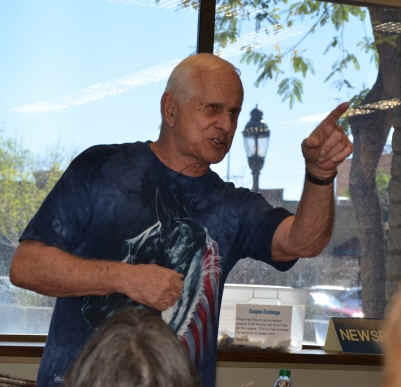
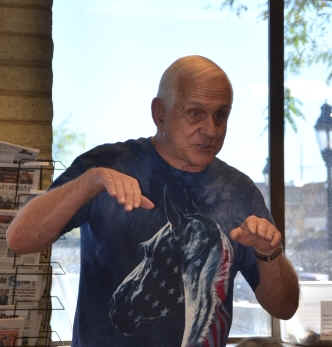
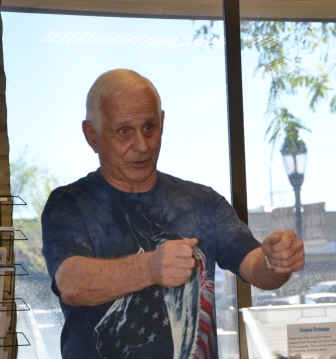
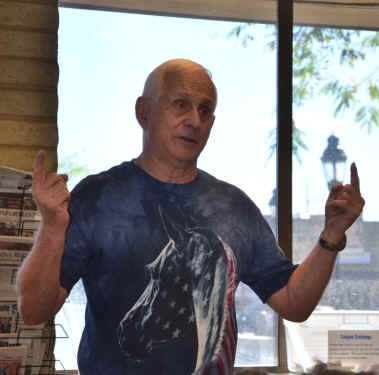
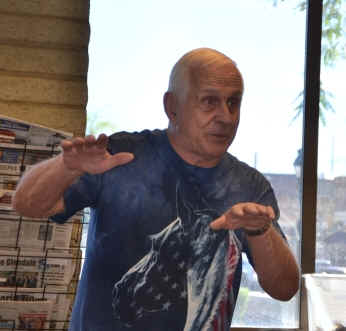 
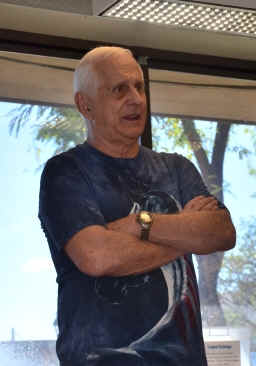
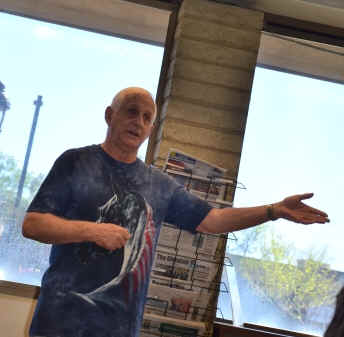
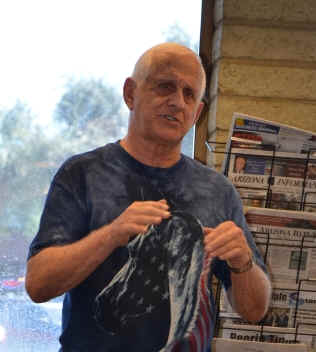 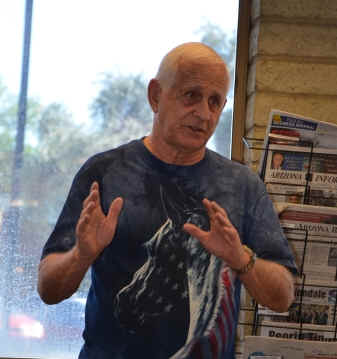

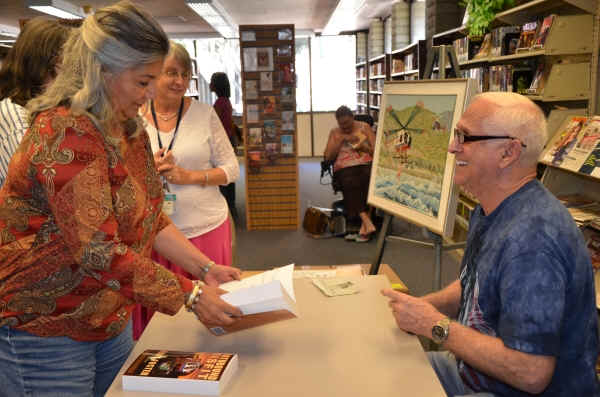
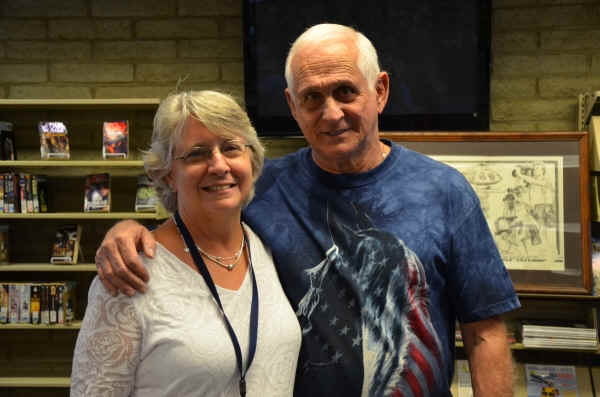

Former
Local News Pilot Jerry Foster
Signs
“Earthbound Misfit” at the Library
Glendale,
Ariz. –– Former TV news personality and
helicopter pilot Jerry Foster will discuss and
sign his new book, “Earthbound Misfit,” during
the Authors @ the Teague event at 2 p.m.,
Saturday, March 8 at Velma Teague Branch Library,
7010 N. 58th Ave.
The
most decorated civilian helicopter pilot in
history, Foster spent more than 20 years covering
the news for three different Phoenix stations.
After starting out reporting traffic conditions,
he progressed to breaking stories in the Valley,
including many daring rescue and recovery
missions. Foster even inadvertently became part of
the news a few times during his career. For more
information, see his website at www.sky12.tv.
Prior
to becoming a news helicopter pilot, Foster
trained pilots bound for Vietnam.
He is the recipient of the Harmon Trophy,
the highest civilian honor in aviation. After
retiring, he has continued to fly various
aircraft. He is married and lives in Phoenix and
Show Low. His
book is co-authored by Dee Dees, a personal
historian, writer and ghostwriter residing in
Gilbert.
The
program is free and books will be available for
purchase and signing. For more information, call
623-930-3431.

Earthbound
Misfit is the story of Jerry Foster, a pioneer
in the field of news helicopter pilots. What
began a routine flying job reporting traffic for
a local TV station, soon became much more, as
Jerry began reporting news stories as well. His
former training as a paramedic for the AMES
project (for which he was Chief pilot), and his
association with several law enforcement
agencies, also allowed him the opportunity to
help with rescues and recoveries. Very often,
instead of just reporting the story, Jerry
Foster was the story. The book also covers
Jerry’s early life, and the demons that
followed him for years, as well as his life
after 20 years in the TV business. It covers his
fall from grace, and his years of reclusiveness,
before venturing out into the world of Facebook
and discovering that he was still loved by many.

|
The
Abominable, a Novel,
by Dan Simmons
By
Bette Sharpe Glendale Daily Planet
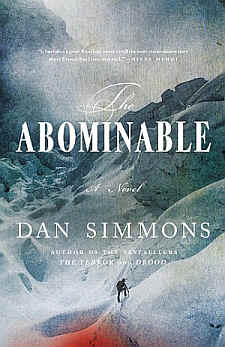
This
work by Simmons is a one being over
six-hundred pages. The lengthy beginning
sets up the history and personalities of
the characters, but fails to get and to
keep the reader’s attention.
The reader will have to read their
way to the middle or two-thirds of the
book (about page 427) to finally get to
the action.
The last two-hundred or so pages
might pay off for the reader.
The
story begins in 1924, when the race to
climb Mount Everest is suddenly stopped by
the disappearance of George Mallory and
Sandy Irvine somewhere high on Mount
Everest. Three
climbers, a British poet, a French
mountain guide, and a young American, find
a way to finance a climbing expedition.
The three arrange funding from Lady
Bromley, whose son has also disappeared on
the mountain.
The three men are joined by the
missing boy’s cousin, a young woman.
Each of whom thought of they were a
confident and capable of climbing Mount
Everest finding the missing hiker, and go
home heroes.
And they would have a chance to
climb the mountain, and make history.
Surprisingly, the mountain, Mount Everest,
is too much of a minor character this
latest work by Simmons and should have
been a stronger character.
The
four climbers found monsters more
frightening than anything they could
imagine. “German
supermen” were somewhere on the
mountain, but even they could not climb
the mountain’s treacherous slopes in the
dark, or could they.
The
Abominable is loosely based on the
disappearance of two famous British
climbers George Mallory and Andrew (Sandy)
Irvine. Both
left their camp on Mount Everest one day
in June of 1924 and basically were never
seen again.
They were spotted by others on the
mountain were about 1000 feet from the
summit. Were
Mallory and Irvine headed to the top—the
summit of Everest?
If they did make it to the top, it
would have been 29 years before Edmund
Hillary and Tenzing Norgay.
Did Mallory and Irvine make it to
the summit of Everest and why did they not
make it down the mountain are real
unsolved mysteries?
|
|
“Drawing
with Mark: Reach for the Stars!/A day with
the dinosaurs”
Now on DVD!
By
Bette Sharpe - Glendale Daily Planet
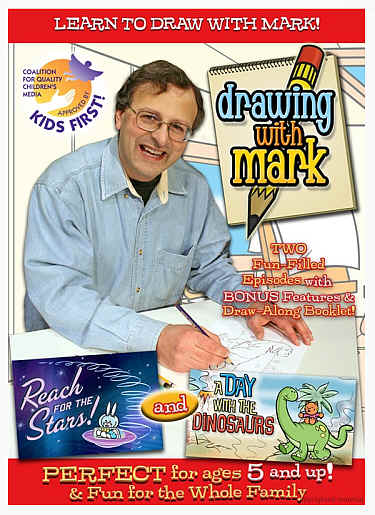 The
DVD has two thirty minute lessons, “A Day
with the Dinosaurs” and “Reach for the
Stars”.
Each lesson is blended with a visit
to an actual museum, drawing instruction,
and some animated fun.
In “A Day with the Dinosaurs” the
viewer sees a clip from an old dinosaur
movie and in “Reach for the Stars” there
are some animated rock-n-roll characters
drawn the geometric shapes that might
inspire young artists. The
DVD has two thirty minute lessons, “A Day
with the Dinosaurs” and “Reach for the
Stars”.
Each lesson is blended with a visit
to an actual museum, drawing instruction,
and some animated fun.
In “A Day with the Dinosaurs” the
viewer sees a clip from an old dinosaur
movie and in “Reach for the Stars” there
are some animated rock-n-roll characters
drawn the geometric shapes that might
inspire young artists.
The
elements of drawing included in each drawing
lesson are the basic shapes, circle, square,
and triangle. Cylinders are referred to as tubes in this DVD.
Vocabulary terms ovals, parallel
lines, stick figure, action line and
dimension are defined both verbally and with
illustration.
The
viewer visits a museum and a guide answers a
few questions regarding dinosaurs or
astronomy. Then it is back to the magical
attic for more drawing.
The subject of the drawing is based
on what was seen at the museum. A suggest reading list for both lesson is included.
In the dinosaur lesson, Mark shows
the viewer how to draw a Pterodactyl and a
Tyrannosaurus Rex.
While in the astronomy episode, Mark
draws Saturn and a happy astronaut on the
moon.
”Drawing
with Mark” is a Parents’ Choice and Creative Child Magazine award winning
television series that teaches children of
all ages the fundamentals of drawing.
The series was released on DVD and
digital platforms on October 8, 2013 by
Shelter Island.
Professional
Mark Marderosian uses the basic shapes to
block out the subject,
Tyrannosaurus Rex or Saturn for
example, and then adds simple details to the
subject to create an outline drawing
suitable for coloring in.
Mark Marderosian, a professional
cartoonist and illustrator with over 25
years of experience.
Marderosian has worked with companies
such as Walt Disney Productions, Universal
Theme Parks and Hasbro toys.
Among the characters his is best
known for drawing art Mulan, Jessica Rabbit,
the Little Mermaid and Mr. and Mrs. Potato
Head.
Since
only the subject matter is drawn and simple
details are added, the young artist can add
his or her own information to the drawing
that might include were the subject is
located and who or what is in the picture
with the subject.
And add color.
Mark’s drawing is done mostly with
lines.
A
materials or supplies list is not mentioned.
However, because of this, the artist
can use whatever is available; paper, a flat
surface and a pencil or crayon or marker.
Mark encourages viewers to have fun,
because with freehand sketching “there are
no mistakes
that are why we have erasers.”
Watching
Mark draw will more than likely be the most
watched parts of the DVD.
Mark Marderosian, “Keep practicing
and having fun” is good advice to keep
drawing.
“Drawing with Mark” Produced and
directed by Robert Palmer for Big City
Publishing.
|
| |
| |
J.A.
Jance appearing in person
at the Glendale Foothills Library
Feb 8, @ 1PM
19055 n 57 ave Glenale, AZ 85308
Deadly
Stakes, by J. A. Jance
A
Bette Sharpe Review
Deadly
Stakes is the newest and eighth
title in the Ali Reynolds series and will be available at bookstores on
February 5th. There
is some romance, some humor and of course a body, or two, in this new work
by J.A. Jance. Her likeable
characters are one of the major draws that keep her readers coming back.
Readers and will be pleased with the addition of at least one new
character in the Ali Reynolds series, Stuart Ramey. Deadly Stakes contains some big news for Ali.
Lynn
Martinson from Fatal Error
returns. In Fatal
Error Lynn was a victim of a cyber-sociopath. She has not had much luck in finding mister right.
In fact her search almost got her killed and left her emotionally
drained. Until she meet Chip
Ralston, and he seems to be too good to be true.
When his ex-wife is found murdered and left for dead in the Arizona
desert near Camp Verde, both Lynn and Chip find themselves in jail.
Lynn’s cell phone is found at the crime scene.
There is plea agreement on the table for the one who will take the
other person down!
A.J.
Sanders, a teenager who received a letter from his estranged father with
instructions for finding a box of something valuable buried in the desert
near Camp Verde. Right!
Buried treasure in the desert.
A.J. needs the money, so why shouldn’t play along, and see if
there ready a fortune waiting for him in the desert.
All he has to do is dig it up.
Even if he has to cut school to do it.
Two
dead bodies in the same area, they must be a connection.
However, A. J. and Lynn’s cases are more related than anyone
could have imagined. Ali
uncovers clues in both cases, but her friends in the police department are
irritated by her involvement with the cases.
Ali must depend on sources outside the police to get to the truth.
Two good guesses as to who those two are B. Simpson, and Leland
Brooks!
Several
subplots provide plenty of twists and turns for the reader.
However, this last work might be considered by some to be a little
underdone in that the last portion of the story seems under developed and
not as believable.
J.A. Jance is the New York
Times bestselling author of the Ali Reynolds series, the J.P. Beaumont
series, the Joanna Brady series, and four interrelated southwestern
thrillers featuring the Walker Family.
Born in South Dakota and brought up in Bisbee, Arizona, Jance lives
with her husband in Seattle, Washington, and Tucson, Arizona
(
|
Bryan Gruley -
Authors @ The Teague, 6-14-2012

Article and Photos by: Lesa Holstine Glendale Daily Planet Book
Topics Editor, unless otherwise mentioned.
When Bryan Gruley appeared for Authors @ The Teague, I introduced him as
the award-winning author of the Starvation Lake mystery trilogy. He spent
sixteen years with The Wall Street Journal, where he shared in a Pulitzer
Prize for the coverage of 9/11. He is now a reporter-at-large for Bloomber
News, writing long features for Bloomberg Businessweek magazine. He
responded by thanking me, and then told the audience he thinks of me as a
friend. He said being a writer is like throwing a message in a bottle off
a beach. Librarians are out there picking them up, and saying, there's a
book. He told us that anyone who gets his books in the hands of readers is
a friend.
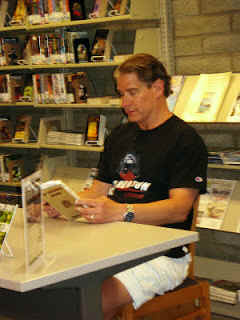 Then,
he started his program with a story designed to win the heart of any
librarian or book lover. He said he seldom read to the audience, but he
was going to read to us from a favorite book. He said, this is The
Crisscross Shadow by Franklin W. Dixon, an author you might recognize.
This is a Hardy Boys mystery. Bryan highlighted this book as an important
book in his life. He grew up in a blue collar suburb of Detroit. He was
over at a friend's house, and the friend was going on and on about this
book he read, and the villain named Brett. Bryan thought in order to be
cool, he'd have to read the book. So, he asked his mom for the book. It
was probably the first chapter book he ever read. Bryan was enamored of
the Hardy Boys. He even made up his own version, the Anderson twins. He
wrote and illustrated them, and then read them to the second grade class.
His mother encouraged him to write. She also knew he was a hot dog, and
liked to have the attention on him. So, by eight or nine Bryan knew he
wanted to write. Then,
he started his program with a story designed to win the heart of any
librarian or book lover. He said he seldom read to the audience, but he
was going to read to us from a favorite book. He said, this is The
Crisscross Shadow by Franklin W. Dixon, an author you might recognize.
This is a Hardy Boys mystery. Bryan highlighted this book as an important
book in his life. He grew up in a blue collar suburb of Detroit. He was
over at a friend's house, and the friend was going on and on about this
book he read, and the villain named Brett. Bryan thought in order to be
cool, he'd have to read the book. So, he asked his mom for the book. It
was probably the first chapter book he ever read. Bryan was enamored of
the Hardy Boys. He even made up his own version, the Anderson twins. He
wrote and illustrated them, and then read them to the second grade class.
His mother encouraged him to write. She also knew he was a hot dog, and
liked to have the attention on him. So, by eight or nine Bryan knew he
wanted to write.
When Gruley graduated from Notre Dame in 1979, though, he realized he
couldn't just sit around and make things up. He took a detour to
journalism, a detour that has lasted for thirty-two years. He's worked all
over, and it's been a great detour. Bryan is still having a blast. He
enjoys being a reporter, asking people what they do.
Gruley's body of work contains a number of narratives, small versions of
stories with an arc, beginning, middle and end. He swore he didn't make up
the stories. He still had a longing to be a novelist. He talked about it,
dreamt about it. But, he never sat his butt down in a chair and wrote. He
was intimidated. He didn't know any authors. Then, a friend, Ken Wells,
published his first novel. Bryan worked with Ken. He wasn't intimidating.
He thought, if Wells can do it, I can at least try.
So, Bryan wrote 25,000 words. His agent didn't like it, but there was a
glimmer of hockey in those 25,000 words. Bryan had played hockey since he
was eight. There was a rink in his backyard, and rinks all over the
neighborhood. His agent suggested a story about middle-aged guys who play
hockey in the middle of the night. Right away, he had an idea, mentioned
something really bad that happened, and she said, oh, that's good. It
always sells.
Gruley set his book two hundred miles north of Detroit in Starvation Lake.
Starvation Lake is a small lake three miles north of Big Twin Lake.
There's really no town at Starvation Lake, but he put one there. It took
him four years to write the book. He did several drafts. He submitted Starvation
Lake in April 2006. He had twenty-six rejections. No one knew what to
do with the book. Bryan didn't set out to write a mystery. He doesn't read
just mysteries. He reads all sorts of things. He said they were nice
rejection letters. Some suggested it might be a mystery. One young editor
said it best. He said the book fell between two schools. It's too nuanced
to be a genre mystery, but it's not literary. Brian concedes the latter
point. It's not literary. But he's baffled by the first. He was on the
verge of giving up when Touchstone, division of Simon & Schuster
signed him to a three book deal. Then, he realized he had to write the
other two books.
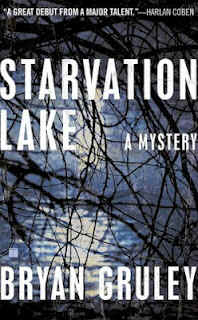 Starvation
Lake came out in 2009. It deals with the death of a hockey coach
relating to a snowmobile accident. Years later, the snowmobile parts who
up, in a different lake in which it supposedly went down. Starvation
Lake came out in 2009. It deals with the death of a hockey coach
relating to a snowmobile accident. Years later, the snowmobile parts who
up, in a different lake in which it supposedly went down.
Gus Carpenter is the narrator of Starvation Lake. He played hockey
for the great River Rat teams of the '70s, the only teams that had the
chance to beat the tough teams from Detroit. He also gave up the goal that
cost them their only chance at the state championship. He left Starvation
Lake for college, and ended up working as a journalist in Detroit until he
was fired. He went back to Starvation Lake with his tail between his legs,
where he ended up as associate editor at the local newspaper. He's forced
to investigate the story about the snowmobile, and learns things that are
not so pleasant.
When Gruley turned in his second book, it was terrible. It didn't even
have a title. His editor agreed that it was terrible. He was about to go
on tour for Starvation Lake. She told him to go on tour, and got
him a seven month extension on the second book. So, he threw away that
second book. It had too much plot, and not enough story. Some people think
it's the same thing. Plot is the skeletal structure. The story is
everything else.
Bryan did like one element of his original story. There was a mystery
about a tree filled with shoes, but the story was too disconnected from
Gus to matter. So, he threw it away and started over, keeping just a
couple scenes. He took the tree.
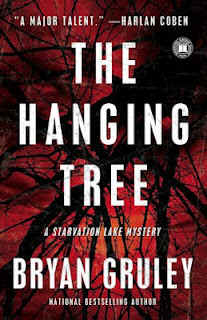 Once
Bryan's characters have names they come to life. He named the victim
Gracie McBride. She was found hanging in a shoe tree. Why did it matter to
Gus? She was his second cousin. She was also Darlene's best friend.
Darlene is Gus' on-again, off-again girlfriend. And, Gracie had been
fooling around with Soupy, the greatest hockey player ever to come out of
Starvation Lake. He threw his career away on drugs and drinking. He is
also Gus' best friend. That became The Hanging Tree, which has been
optioned for a movie. Once
Bryan's characters have names they come to life. He named the victim
Gracie McBride. She was found hanging in a shoe tree. Why did it matter to
Gus? She was his second cousin. She was also Darlene's best friend.
Darlene is Gus' on-again, off-again girlfriend. And, Gracie had been
fooling around with Soupy, the greatest hockey player ever to come out of
Starvation Lake. He threw his career away on drugs and drinking. He is
also Gus' best friend. That became The Hanging Tree, which has been
optioned for a movie.
Like Gruley's earlier books, The Skeleton Box began with an image.
Brian picked up a little book at a package store in Michigan. It was by a
Traverse City author, and it was called Ghost Towns in Michigan. It
was about towns that had once thrived and then gone away. One of those
towns, Isadore, still exists. In 1907, a nun disappeared in the Polish
Catholic parish there. The townspeople searched for her, and never found
her. Five or six years later, a woman who worked there at Holy Rosary
Church went to confession and confessed she murdered the nun, and buried
her bones under the church. That should have remained a secret since it
was told in the confessional, but it got out, as so many secrets do. The
diocese was now building a new church on the site, and they contacted the
church there, and told them to get the bones out, and bury them elsewhere.
They got caught. That resulted in the longest trial in Michigan's history.
The woman who had confessed pleaded not guilty. There was a nonfiction
book written about it called Isadore's Secret. It was published by
the University of Michigan Press.
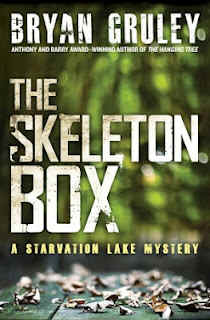 This
image got Bryan going. The Skeleton Box, his latest book, is set in
March 2000. Starvation Lake was set in 1998, and The Hanging
Tree in 1999. This book starts with a series of burglaries. The
newspaper calls them "Bingo Night Break-Ins" because someone
knew the people would be out playing bingo. What was odd is that they
didn't take anything, but went through the houses, as if looking for
something. There were four or five burglaries, and then one burglary went
bad. Darlene's mother was murdered. She was the best friend of Gus'
mother, Bea. Darlene's mother died in Bea's house, and Gus has to look
into it. This
image got Bryan going. The Skeleton Box, his latest book, is set in
March 2000. Starvation Lake was set in 1998, and The Hanging
Tree in 1999. This book starts with a series of burglaries. The
newspaper calls them "Bingo Night Break-Ins" because someone
knew the people would be out playing bingo. What was odd is that they
didn't take anything, but went through the houses, as if looking for
something. There were four or five burglaries, and then one burglary went
bad. Darlene's mother was murdered. She was the best friend of Gus'
mother, Bea. Darlene's mother died in Bea's house, and Gus has to look
into it.
Gus already has problems. He's on the outs with Darlene. His future at the
newspaper is iffy since he's on shaky ground with the suits in Traverse.
His mother is losing her memory, and has a hard time keeping her story
straight.
However, the River Rats hockey team is doing better. They have a great new
player. There's also a new Evangelical Christian camp over by the lake,
and the man in charge is starting to get involved in the town. His name is
Brett, the same as the bad guy in The Crisscross Shadow. That's
Gruley's homage to that Hardy Boys book. In fact, at one point, Soupy
asks, "What is this, a Hardy Boys mystery?"
In this book, Gus has a distant connection to the disappearance of a young
nun from St. Valentine's Church.
Does it get any easier? No. All the books are difficult in their own way.
And, if you're ambitious, and want to get better, it doesn't get
easier.Just because you continue to do something, that doesn't mean it
gets easier. Bryan plays golf, so he knows it's not true that it gets
easier. It doesn't necessarily get better.
When he turned in The Skeleton Box, his editor asked him questions
he couldn't answer. But, she was patient, and stayed with him. The book
covers decades, the 30s, 40s, and 50s, leading up to 2000. He had events
in every decade, but hadn't done the boring work of building it up. He
needed to see things, so he did a 20-25 page outline, beginning in 1903
with the birth of a future priest. Then, he could see it all. He needed to
understand it, and see the cause and effect in order to keep it straight.
So, he took seven weeks off last summer to finish The Skeleton Box.
Is the Starvation Lake series a trilogy like Tolkien's Middle Earth
trilogy or George Lucas' Star Wars trilogy? It wasn't planned as a
trilogy. But, Gruley is resolving issues that spanned all three books. One
is the relationship between Gus and his mother. Bryan's readers email him
and tell them they love Bea, but they're frustrated by her. She doesn't
give up everything she knows.Gus and Bea have a similar mother-son
relationship as Bryan did with his mother.
Bryan's characters are entities of their own. They're not based on real
people. Saying that, Gus has some of Bryan in him, and so does Soupy. And,
there are things in the relationship between Gus and his mother that Bryan
had with his mother.
The Skeleton Box is Bryan's favorite of the three books. He's not
sure what he's doing next. And, then he ended his formal presentation by
reading the end of The Crisscross Shadow.
The first question from the audience involved characters who take over.
Bryan said Gus doesn't tell him what to do. However, brains are always
working. Usually, Gruley goes by gut instinct. Everything he sees
influences him.
Would he ever quit his job, and write just fiction? His wife doesn't want
to life in a tent. His journalism pays the bills.
Who are his favorite authors? J.D. Salinger for his short stories;
Hemingway. He loves Thomas Harris' Red Dragon and The Silence of
the Lambs. He's rereading Dennis Lehane's Mystic River. He just
finished Tim O'Brien's The Things They Carried. That's art. It's
harrowing, funny, absurd. It's written as a collection of short stories,
but it's actually a memoir about men at war.
And, he ended by answering a question about his Starvation Lake tee
shirt. It features a goalie, which is great, but the person who picked the
number 76 must be the only person in Canada who doesn't watch hockey
because no goalies have 76 as a number. All goalies have low numbers.
Bryan Gruley's website is www.bryangruley.com
The Skeleton Box by Bryan Gruley. Touchstone. 2012. ISBN 9781416563662
(hardcover), 336p.
--
Lesa Holstine
lesa.holstine@gmail.com
http://www.lesasbookcritiques.blogspot.com
|
Tucson
Festival of Books, 2012

by: Lesa Holstine Glendale Daily Planet Book
Topics Editor
Behind this door lies a world "Where
Words and Imagination Come to Life."
Well, not really, but that's the theme for the Tucson Festival of Books.
And, the festival truly is a magical place for book lovers. It's now in
it's fourth year, and I've been to the festival every year but the first
one.
It was a full day, beginning with the two hour drive to Tucson. Once I
arrived, I had a little time before the first panel of the morning, so
there was time to scope out the exhibition tents. We immediately caught up
with Libby Fischer Hellmann, author of A Bitter Veil. Libby appears
for Authors @ The Teague on Monday, March 12. She was working at a booth
with Joel Fox, author of Lincoln's Hand, and Pascal Marco, author
of Identity: Lost.
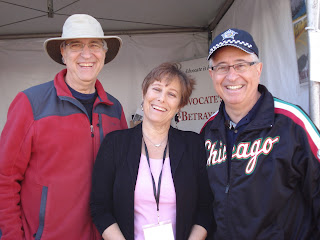 |
| Joel
Fox, Libby Fischer Hellmann, Pascal Marco |
The first panel of the day was called "Between Two Wars."
Jennifer Lee Carrell moderated, with award-winning authors Rebecca
Cantrell and the writing team that makes up Charles Todd, Charles and
Caroline Todd. They discussed their mysteries, set during and between the
two world wars. Rebecca's most recent Hannah Vogel novel is A Game of
Lies. Hannah Vogel is a crime reporter in 1930s Berlin, Germany. The
Todds have two series. The Confession, the latest Ian Rutledge book
features the shell-shocked veteran who returns to his job at Scotland
Yard, and A Bitter Truth is about Bess Crawford, a British Army
nurse in World War I.
Mark McLemore moderated the panel about urban fantasy called "Where
the Paranormal Hits the Pavement." I went to support Kevin Hearne,
author of The Iron Druid Chronicles, who will be appearing for Authors @
The Teague on May 19. Kevin's always entertaining, but this was the
funniest panel of the day with authors Cherie Priest, Angela Knight,
Cynthia Garner, and Yvonne Navarro.
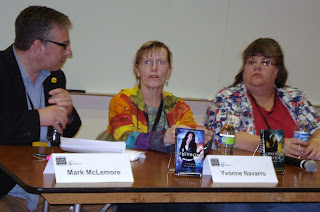 |
| Moderator
Mark McLemore with Yvonne Navarro and Cynthia Garner |
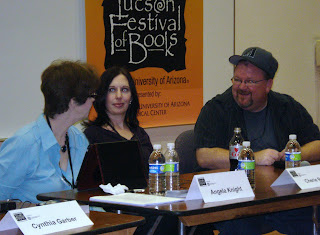 |
| Angela
Knight, Cherie Priest and Kevin Hearne |
On the way to the next panel, I had a chance to meet the ringtail cat who
is the mascot of this year's OneBookAZ for kids, Arizona: Way Out West
and Witty by Lynda Exley and Conrad J. Storad. Of course, I'd pose for
a picture with a "cat," even though it's really not a cat. It's
in the raccoon family.
The panel "Queen Elizabeth and Her World" featured authors
Jennifer Lee Carrell, Margaret George and Louis Bayard. I just had a short
time to listen to this one before I had to run off to moderate a panel.
My final panel of the day was "Cozies Need Respect, Too."
Cozies Need Respect Too!
When: Saturday 4:00 PM - 5:00 PM
Where: Student Union - Tucson Room
Genre: Mystery
| Authors |
Moderators |
Kate Carlisle
Earlene Fowler
Avery Aames |
Lesa Holstine |
I moderated, but authors Kate Carlisle, Earlene Fowler, and Avery
Aames really didn't need a moderator. All three authors have appeared for
Authors @ The Teague in the past, so I knew they would successfully take
off on the subject. Kate Carlisle is the author of the Bibliophile
mysteries. Her new book is One Book in the Grave. Earlene Fowler,
author of the Benni Harper mysteries, was there to discuss her series and
the latest book, Spider Web. However, she also has a sequel coming
out to her bestselling novel, The Saddlemaker's Wife. And, I love Avery
Aames, author of the Cheese Shop Mysteries. Her latest is Clobbered by
Camembert. Avery, a former actress, is a treat to have on a panel. I
thought the panel went well. And, one woman told me it was the best one
she attended all day.
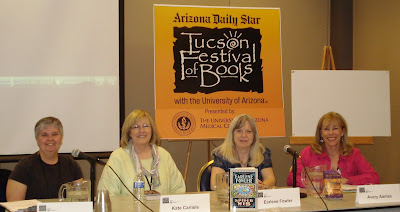 |
| Moderator
Lesa Holstine, with Kate Carlisle, Earlene Fowler and Avery Aames |
If you're a reader, you might want to attend the Tucson Festival of Books
next year. 100,000 people a day can't be wrong.
--
Lesa Holstine
lesa.holstine@gmail.com
|
Book
The
Girl Next Door by Brad Parks

Review by: Lesa Holstine Glendale Daily Planet Book
Topics Editor
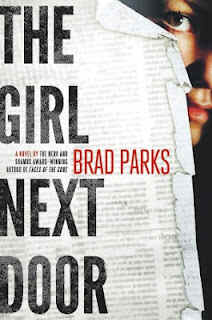 Every
time I pick up a Brad Parks book, I'm waiting to see what kind of trouble
his newspaper reporter, Carter Ross, can get into. This time, he
"Wasn't put off by the potential loss of his job, by hits to his
reputation, or even the threat of jail." If you like witty
characters, the newspaper business, and a reporter who makes just about
the worst mistakes he can, you'll enjoy The Girl Next Door. Every
time I pick up a Brad Parks book, I'm waiting to see what kind of trouble
his newspaper reporter, Carter Ross, can get into. This time, he
"Wasn't put off by the potential loss of his job, by hits to his
reputation, or even the threat of jail." If you like witty
characters, the newspaper business, and a reporter who makes just about
the worst mistakes he can, you'll enjoy The Girl Next Door.
It started out as a simple obituary. Carter Ross, a veteran reporter at
the Newark Eagle-Examiner, read obits for inspiration for stories.
He convinced his editor, Tina Thompson, that he wanted to write a story
about Nancy Marino. Nancy worked as a waitress, but she was also a
delivery person for the newspaper, a union representative. Everyone seemed
to like her. "She worked two jobs, kept her mother company..."
He called the piece, "Fanfare for the Common Woman." And, that
worked, until her sister prodded Carter, saying the hit-and-run accident
might have been murder. And, Carter couldn't let go of the story,
especially with the link to the newspaper. What if the link to the
newspaper was bigger than anyone thought?
Carter enlists the help of a friend on the paper, Tommy Hernandez, and an
intern nobody respects, Kevin Lungford. But, even his friends can't save
Carter when he goes too far with his investigation, attracting the
attention of the publisher. It's going to take dogged determination to
keep going when wiser heads warn Ross off the story.
Carter Ross is my kind of character, one who stands up for the underdog,
and persists against all odds. And, in The Girl Next Door, he
persists in continuing his reckless actions, almost to the point
where he's TSTL. TSTL, "Too Stupid To Live" is a complaint
readers have when sleuths are reckless with their own safety. Carter
is only saved by his final awareness as to how stupid he was. And, it
isn't as if he deliberately set out to endanger himself. He actually tried
to tell everyone, from his editor to the police, what he thought was
happening. But no one would listen.
Brad Parks knows how to create characters. Carter Ross and the
staff at the newspaper are brilliantly written. Tommy Hernandez, the gay
Cuban-American reporter, is wonderful. Other than Carter Ross,
though, Parks' best characters, book after book, are the different
newspaper interns. They're all original, and funny.
But, Carter Ross is the heart of these stories. He loves the newspaper
business, loves Newark with all its flaws, and, really, just loves people.
He's witty and bright, and, sometimes, he's his own worst enemy, as in The
Girl Next Door. He's also the first one to admit he isn't perfect, and
that makes him lovable.
I'll admit right now that most readers will see the solution to this case
long before Carter Ross does. Knowing he's heading in the wrong direction
is part of the fun of this book. You won't want to miss the latest
installment in Carter Ross' adventures, The Girl Next Door.
(Please come back tomorrow when Brad Parks is my guest blogger. His
subject just might surprise you. And, Brad will be appearing for Authors @
The Teague on April 5 at 2 p.m.)
Brad Parks is a winner of the Nero Award and the Shamus Award. His latest
book, The Girl Next Door, releases from St. Martin’s
Press/Minotaur Books on March 13. For more Brad, sign up for his
newsletter http://www.bradparksbooks.com/newsletter.php,
like him on Facebook http://www.facebook.com/pages/Brad-Parks-Books/137190195628,
or follow @Brad_Parks on Twitter.
The Girl Next Door by Brad Parks. St. Martin's Minotaur. 2012. ISBN
9780312667689 (hardcover), 326p.
--
Lesa Holstine
lesa.holstine@gmail.com
|
Rhys
Bowen, Cara Black, and Libby Fischer Hellmann
for Authors @ The Teague

by: Lesa Holstine Glendale Daily Planet Book
Topics Editor
What a wonderful afternoon! I had the chance to
go to lunch with Rhys Bowen, Cara Black and Libby Fischer Hellmann before
their appearance for Authors @ The Teague. And, we celebrated downtown
Glendale. Libby and Cara wanted to go to Bitzee Mama's, across from the
library. They said they always go there when they appear at Velma Teague.
We followed it up with a trip to A Shot of Java, so Cara could have
espresso. And, of course, I gave them the French mints from Cerreta Candy
Company. All the authors who appear at Velma Teague get those.
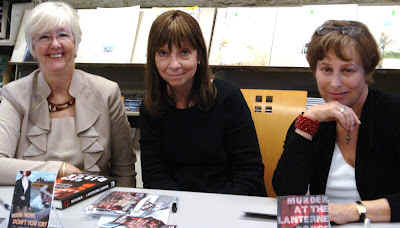 |
| Rhys
Bowen, Cara Black and Libby Fischer Hellmann |
And, we had a nice audience for the event, including a number of new
people in attendance. After the introduction, Rhys Bowen started the
program by saying she and Cara have a symbiotic relationship. They often
tour together because they both have books out in March. And, they've had
some unusual signings, including one at a nudist colony. Fortunately, it
was a cold night, and most people came clothed, except for one man. He was
a large bearded man who wore nothing but a little backpack, and paraded
back and forth as the authors talked. Rhys assured us she could handle
anything that might happen during the program.
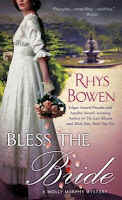 Rhys said she and
Cara also see the same things in the universe. Last year, Bowen's Molly
Murphy book, Bless the Bride, came out, and it was set in New
York's Chinatown. Cara's new book is set in a Parisian Chinatown. Rhys is
anxious to see how the experiences compare. Rhys said she and
Cara also see the same things in the universe. Last year, Bowen's Molly
Murphy book, Bless the Bride, came out, and it was set in New
York's Chinatown. Cara's new book is set in a Parisian Chinatown. Rhys is
anxious to see how the experiences compare.
In Bless the Bride set in early 20th century New York, the Chinese
were excluded from society. They had no rights. And, they looked
different. The men wore blue outfits, and had long pigtails, queues. They
didn't want to cut their pigtails because they hoped to return to China.
If they cut their pigtails, it was a sign of disrespect to the Emperor,
and that meant instant beheading. But, the Chinese were also terrible
gamblers, and gambled away their earnings. So they didn't have the money
to return home.
 Rhys
said she's lucky to use the various environments of New York for her
books. She can explore the deep dark parts of the city, such as opium
dens, for one book. Then, she set this year's book in what she calls New
York's Downton Abbey. The cottages in Newport, Rhode Island were
actually summer palaces for families such as the Astors and Vanderbilts.
They were fabulous homes, without many bedrooms. They enjoyed parties, but
didn't want people to spend the night. Those mansions, used only for six
weeks or so in the summer, are all along a spit of land in Newsport. Rhys
said she's lucky to use the various environments of New York for her
books. She can explore the deep dark parts of the city, such as opium
dens, for one book. Then, she set this year's book in what she calls New
York's Downton Abbey. The cottages in Newport, Rhode Island were
actually summer palaces for families such as the Astors and Vanderbilts.
They were fabulous homes, without many bedrooms. They enjoyed parties, but
didn't want people to spend the night. Those mansions, used only for six
weeks or so in the summer, are all along a spit of land in Newsport.
Because of a case, Molly and her new husband, Daniel Sullivan, were forced
to cut their honeymoon short in Bless the Bride. Now, in Hush
Now, Don't You Cry, a New York alderman lent them the guest cottage on
his estate. But, Molly is always suspicious. Why is this politician being
so nice to an ordinary policeman? Then they learn the rest of the man's
family has been invited to spend the weekend at this house, usually only
used in the summer. This newly built house, looking like an Irish castle,
already has secrets.
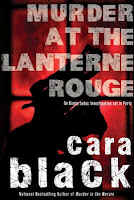 Cara Black joked
that she always follows Rhys. In her latest Aimée Leduc Investigations, Murder
at the Lanterne Rouge, Aimée is finally back in the Marais. Marais,
which means marsh in French, was once a swamp until it was drained for
houses for the aristocrats. The fourth and third arrondissements
are in the Marais. This book takes place in the third arrondissement, in
the northeast part. It's set in the smallest and oldest Chinatown in
Paris. Black was in Paris, and went down a narrow street, and came across
a fourteenth century building. Then she heard Chinese, and the click of
mahjong tiles. A mercantile group of Chinese live in just a few narrow
streets there. They are entrepreneurs. Then, she heard a rumbling noise.
What was behind that noise? Machines. People were working on machines in
sweatshops at night, behind the front of luggage and wholesale jewelry
shops. Cara Black joked
that she always follows Rhys. In her latest Aimée Leduc Investigations, Murder
at the Lanterne Rouge, Aimée is finally back in the Marais. Marais,
which means marsh in French, was once a swamp until it was drained for
houses for the aristocrats. The fourth and third arrondissements
are in the Marais. This book takes place in the third arrondissement, in
the northeast part. It's set in the smallest and oldest Chinatown in
Paris. Black was in Paris, and went down a narrow street, and came across
a fourteenth century building. Then she heard Chinese, and the click of
mahjong tiles. A mercantile group of Chinese live in just a few narrow
streets there. They are entrepreneurs. Then, she heard a rumbling noise.
What was behind that noise? Machines. People were working on machines in
sweatshops at night, behind the front of luggage and wholesale jewelry
shops.
Four years ago, Cara was meeting with a friend, a member
of the intelligence branch of the police force in Paris. He made the
comment, "No one dies in Chinatown." She asked him what he meant
by that, and he said, "You're a writer. You figure it out." Why
wouldn't people die in Chinatown? Because, to register a death, they have
to have papers. Identity cards are passed around in Chinatown, so no one
has papers.
And, of course, Black had to include the Knights Templar
in this book because this was their area. One day she saw courtyard doors
open, and she wandered in, as she often does. There were Polish workmen
working in the courtyard, but there was also the base of a medieval tower,
a Templar tower. Napoleon destroyed most of them because Marie Antoinette
had been imprisoned in one before she was executed, and he didn't want the
Royalists to rally around the towers. The only other thing Cara would say
was love doesn't work out for poor René, Aimée's business
partner.
Libby Fischer Hellman's forthcoming book, A Bitter Veil, is set in
Iran. But, before writing that, she wrote two mystery series. One series
features Ellie Foreman, a single mother. She said she also has a
similarity to Rhys' books. One of the Ellie Foreman books takes place in
Lake Geneva, Wisconsin, called the Newport of the Midwest. In that book,
she showed the contrast between the rich and those who serve. Libby loves
to include historical elements in her books. Her book, Set the Night on
Fire, is set in the late 60s. Even though many of us lived through the
60s, unfortunately, that's not considered history. It's a standalone
thriller.
ABitterVeil is another thriller. It
features a young woman who graduated in 1978. She met a young Iranian
engineering student while they were in school in Chicago, and they fell in
love. They married and moved to Tehran. Unfortunately, they moved there
just before the Shah was deposed and the rise of the Islamic Republic.
 Hellmann did an
enormous amount of research about the Iranian Revolution. She said the
mystery community is very close and supportive. She put out the word that
she was looking for Iranian-Americans who were there during the
revolution, and within a few weeks, had contact information for five of
them. One was a woman from Cara's book group. She had such an intriguing
story that Libby used some of that in A Bitter Veil. She had her
vet the manuscript to make sure it was right. Her publisher had it vetted
again, and then they had someone check on the pronunciation to ensure it
was right for the audio. Hellmann did an
enormous amount of research about the Iranian Revolution. She said the
mystery community is very close and supportive. She put out the word that
she was looking for Iranian-Americans who were there during the
revolution, and within a few weeks, had contact information for five of
them. One was a woman from Cara's book group. She had such an intriguing
story that Libby used some of that in A Bitter Veil. She had her
vet the manuscript to make sure it was right. Her publisher had it vetted
again, and then they had someone check on the pronunciation to ensure it
was right for the audio.
A Bitter Veil comes out next month in print, audio, and ebook. It
takes place from 1978-80.
When Libby asked the others about research, Rhys answered first. Molly
lives in New York City, which hasn't changed a lot since 1904. She
selected her house in Greenwich Village deliberately. A professor at
Fordham University contacted Rhys and said, "I'm living in Molly's
house." He sent her pictures of the inside and out, which is just as
Bowen pictured it.
Bowen said she received a gift once when she was there and came across a
festival in that area. There were little booths, and cooking food. The
booths were on both sides of the street, and the crowds were channeled in
the middle. The sound bounced back from the tenement walls, and Rhys
realized how loud the streets were, and that would have been just what it
was like when Molly lived there. She saw a sign that said, "Freak
Show. Come and See the Snake Woman - 50 cents." She used that in Oh
Danny Boy. You can really experience Molly's world in New York.
She also told us Google Earth has been great for her to see where Molly
would walk, and she can check back on the site. In addition, 1903 was the
age of the Brownie camera. There are lots of photos of New York in 1900,
and Rhys can go back and look at those photographs. Then, there is the New
York Times for every day.
It's possible, though, to over-research. You can get consumed with getting
it right while creating our own world. Rhys said she's one who reads a
book, and notices if something is wrong. She loves Connie Willis, whose
book, Blackout, is about the blitz. And, at one point, a landlady
tells a character how much it will cost to use the phone. But, she used a
coin that wasn't yet in use. Once she used the wrong monetary system,
Bowen didn't trust anything else in the book.
Cara loves to do research. A photographer took photos in 1890 of the
streets, and she wanted to see the medieval streets. The photos were taken
at dawn when no one was there. But, the streets haven't changed, and it
was like looking at the past and the present.
Cara Black's books are set in the 1990s, and the latest is set in 1998
when the money was still francs, and there was still smoking in cafes.
When she does research, she wants to know what the big world events were.
Who was visiting at the time? She also looks at the ads. In Murder at
the Lanterne Rouge, the January sales are going on. It's shortly after
Princess Diana's death, so the investigation is still going on. The World
Cup will be in six months.
Libby said she was also lucky. The Iranian Revolution was well-covered
with pictures. She had the chronology. A Bitter Veil is seen
through the eyes of a young American woman. Hellmann watched the first
speech Khomeini made after returning to Iran. She couldn't understand it,
but then she realized her character, Anna, wouldn't have been able to
understand it either. He started slowly and then built up to his
denunciations of Americans.
Black said many of the Chinese came to France in 1912 from Wenzu province.
The French boys were in the war, so the country needed workers. They
imported them from China. Ho Chi Minh and Chou En Lai both worked in
Paris. Young single men worked there, and then many returned home. There
are four Chinatowns in Paris, and Black's book takes place in the
smallest, oldest one.
Hellmann asked the others about writing characters. Are Molly and Aimée
still the character they thought they'd be when they started writing about
them?
Bowen started with Constable Evans. She liked the series, but he was just
too polite. She wanted to write a feisty, first person female, a character
a lot more like Rhys. She went to Ellis Island while trying to decide
where to set Molly Murphy. She thought she knew what to expect, but she
was overcome with emotion. And, her family were not immigrants. The walls
seemed to be shouting at her. She felt great joy, and that people had
escaped from great horrors.
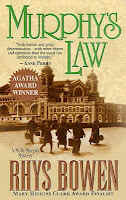 In
Murphy's Law, Molly accidentally kills the man, the son of the
landowner, who was trying to rape her. She flees, taking another woman's
name. But, when she gets to Ellis Island, there is a murder, and that name
is the name of the prime suspect. When she set it in Manhattan, she
thought I've just committed myself to doing research for every book for
the rest of my life because she didn't know New York history. Hush Now,
Don't You Cry is the eleventh book in the series. Molly is four years
older, a little wiser. She just got married. She's still imprudent,
though, and doesn't think things through. In
Murphy's Law, Molly accidentally kills the man, the son of the
landowner, who was trying to rape her. She flees, taking another woman's
name. But, when she gets to Ellis Island, there is a murder, and that name
is the name of the prime suspect. When she set it in Manhattan, she
thought I've just committed myself to doing research for every book for
the rest of my life because she didn't know New York history. Hush Now,
Don't You Cry is the eleventh book in the series. Molly is four years
older, a little wiser. She just got married. She's still imprudent,
though, and doesn't think things through.
Cara said she isn't French. But, she grew up in a Francophile family. Her
father was a Francophile who loved French food. Her mother had to cook
Julia Child's recipes. And, Black went to French Catholic schools where
she was taught French by nuns. She was an eighteen-year-old, backpacking
in Paris, and determined to use her French. One man listened to her, and
then, with a British accent, told her you're using words we haven't used
since 1900. The nuns taught an older version of French. To this day,
France feels familiar, but different to her.
In 1984, a friend took Cara to the Marais, to the fourth arrondissement,
the lower part, and pointing to a window, said, "That where my mother
lived during the German Occupation." She was fourteen, wearing a
yellow star and going to school. When she came home one day, her family
was gone. The concierge and others took care of her during the war. In
1944, when the war ended, there was a place people could go to get
help finding their families. People put up signs asking if you have seen
this family. A woman came up to Black's friend's mother, and said, "I
saw your sister get off the train at Auschwitz."
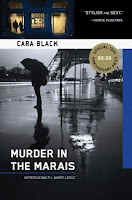 Ten
years later, Cara was in France with her family. She put her son to bed,
and walked down the street, thinking what would these cobblestones say.
What would have you done to survive? It took her three and a half years to
write the first Aimée Leduc Investigations mystery, Murder in
the Marais. Ten
years later, Cara was in France with her family. She put her son to bed,
and walked down the street, thinking what would these cobblestones say.
What would have you done to survive? It took her three and a half years to
write the first Aimée Leduc Investigations mystery, Murder in
the Marais.
Black said she loved Sara Paretsky. She wanted her detective to be strong,
but vulnerable. She has issues. She was raised by her father, a policeman,
and there were police around the table at night. Aimée makes mistakes.
Now, she's four years older. It was Rhys who mentioned that if anyone saw Midnight
in Paris, they saw Duluc Detective Agency. That's the firm Cara
used as the basis for Leduc Investigations.
I wrapped up the program by asking the authors where they were going with
their books. Rhys Bowen said she writes a series besides Molly Murphy. Her
Royal Spyness series features a minor royal in the 1930s. That's the
series she chuckles over. The last book in that series was Naughty in
Nice. The next one in that series will be a Christmas mystery coming
out in November, The Twelve Clues of Christmas. Rhys calls that
series, "Downton Abbey with bodies." That series has been
optioned for a movie. Now, they're saying it should start shooting in
England in the third quarter of this year.
Cara Black told us she had submitted her manuscript to her editor for the
next book in the Aimée Leduc Investigations. It will be set three months
after Murder at the Lanterne Rouge.
Libby Fischer Hellmann's next book is set in Cuba. It's her last
revolutionary novel. She's still working on it. The book begins during the
revolution. The second part takes place in the early 90s in Cuba when the
economy collapsed. The third part will be in Chicago at the present time.
The book covers three generations of the same family. Then, Hellmann will
go back to her Georgia Davis series.
As always, it was a treat to welcome Rhys Bowen, Cara Black and Libby
Fischer Hellmann to the Velma Teague Library for Authors @ The Teague.
 |
| Left
to right - Rhys Bowen, Lesa Holstine, Cara Black and Libby Fischer
Hellmann |
--
Lesa Holstine
lesa.holstine@gmail.com
=============================================
Murder
at the Lanterne Rouge by Cara Black

Review by: Lesa Holstine Glendale Daily Planet Book
Topics Editor
 I've
never been to Paris, but every time I read one of Cara Black's Aimée
Leduc Investigations, I feel immersed in the city and the culture. The
stories are rich with detail, dense, complicated mysteries in which
Paris comes to life. In Murder at the Lanterne Rouge, Black takes
us into one of the four Chinatowns in the city in January 1998. I've
never been to Paris, but every time I read one of Cara Black's Aimée
Leduc Investigations, I feel immersed in the city and the culture. The
stories are rich with detail, dense, complicated mysteries in which
Paris comes to life. In Murder at the Lanterne Rouge, Black takes
us into one of the four Chinatowns in the city in January 1998.
Lanterne Rouge refers to the red paper
lanterns hanging outside the shops in Chinatown. It's there, in a small
restaurant, that Aimée meets her business partner, René. They are
celebrating the birthday of Meizi Wu, the woman he claims is his soul
mate, the love of his life. But just as she opens her gift from René,
Meizi receives a phone call and leaves the restaurant. She never
returns, but just minutes later, people start fleeing. Following the
crowd, Aimée and René find the warm body of a young man, a gifted
scientist. The young man is wrapped in plastic, with a photo of Meizi in
his wallet.
Although Aimée thought something was off about
Meizi and her parents, she knows how desperate René is to find the
missing woman. So, Aimée ransacks Chinatown for hints of her
whereabouts, only to discover sweatshops and illegal women in the secret
rooms behind leather shops and jewelry stores. Before she knows it,
she's not only searching for a missing woman, but looking into the
murder of the young scientist, and the secret that may have lead to his
death.
Only Cara Black can combine Chinatown, illegal
aliens, fourteenth century scientific discoveries, and
secrets that interest the Intelligence Branch of
the police. Black's complex stories of politics and murder continue to
find Aimée tangled up in family secrets she never uncovered, secrets
that continue to endanger her. No one tells the truth, and everyone has
secrets to hide in Murder at the Lanterne Rouge. How appropriate
for the city that becomes a character in Cara Black's books. Paris is a
city of history, where the past, present and future are entwined. And,
readers need to be prepared to immerse themselves in the dark spider web
that's Paris in the stories that are the Aimée Leduc Investigations. Murder
at the Lanterne Rouge once again takes us into the backstreets and
underground world that Cara Black knows so well.
Murder at the Lanterne Rouge by Cara Black. Soho
Press, 2012. ISBN 9781616950613 (hardcover), 298p.
*****
FTC Full Disclosure - The publisher sent me a copy
of the book, hoping I would review it.
--
Lesa Holstine
lesa.holstine@gmail.com
|
Book
Review - Desert Wind by Betty Webb

Review by: Lesa Holstine Glendale Daily Planet Book
Topics Editor
Desert Wind by
Betty Webb
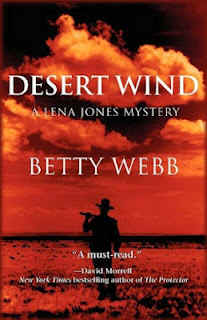 On
the jacket of Betty Webb's latest Lena Jones mystery, Desert Wind,
David Morrell is quoted as saying, "A must-read." It is. Webb
has tackled tough subjects before, everything from polygamy to genital
mutilation on young girls, but Desert Wind may be her most
controversial and powerful book yet. It's a book that should scare
everyone living in the Southwest. On
the jacket of Betty Webb's latest Lena Jones mystery, Desert Wind,
David Morrell is quoted as saying, "A must-read." It is. Webb
has tackled tough subjects before, everything from polygamy to genital
mutilation on young girls, but Desert Wind may be her most
controversial and powerful book yet. It's a book that should scare
everyone living in the Southwest.
In 1954 in Snow Canyon, Utah, Gabe Boone was a horse wrangler on the set
of the filming of The Conqueror, a film that starred John Wayne as
Genghis Khan, and Susan Hayward and Agnes Moorehead. Gabe idolized Wayne,
who treated all the cast and crew as friends, including the Paiute
Indians. But, Gabe did notice that the red dust got in people's lungs, and
there were even blisters in the mouths of the horses. The Paiutes
themselves had blisters in their mouths. Although Gabe didn't realize it
at the time, he was witnessing death.
Almost sixty years later, Lena Jones arrives at her office at Scottsdale,
Arizona's Desert Investigations to find her partner, Jimmy Sisiwan,
missing. Her uneasy feeling only grew when she received strange messages
saying he'd be out for a week or longer, so she tracks him down in Walapai
Flats in northwestern Arizona. His brother had been put in jail as a
material witness in a murder, and now Jimmy is in jail as well. Lena
interferes with Jimmy's plans, and takes it upon herself to find the
person who killed the PR man for Black Basin Uranium Mine. The mine, just
about to open, is controversial. Many of the residents hope for jobs at
the mine, but Jimmy's sister-in-law, an outspoken opponent, was killed in
a shooting, and that killer is still loose.
Lena finds resistance in the community, people unwilling to answer her
questions. And, Gabe Boone, with his knowledge of the past, might have the
key to reveal the secrets of Walapai Flats. Generations of lies and
secrets, of scars, may have led to murder in present-day Arizona.
Each time readers pick up a Lena Jones mystery, we hope to learn a little
more about Lena's mysterious past. There have been glimpses into her
traumatic childhood, and her time in foster homes. Webb still gives us a
glimpse here and there in this book, but Lena's past isn't the focus of
this latest crime novel.
Instead, this is about crime on a grand scale, with implications for all
Americans, especially those of us who live in the Southwest, I'm not going
to spoil Webb's story by giving away too much. She unravels the past
beautifully, along with the repercussions. I'll just say, Desert Wind,
the latest Lena Jones mystery, is powerful, political, and a book that
serves as a warning. David Morrell is right. It truly is "A
must-read."
Betty Webb's website is
www.bettywebb-mystery.com.
Desert Wind by Betty Webb. Poisoned Pen Press. 2012. ISBN 978159089793
(hardcover), 318p.
--
Lesa Holstine
lesa.holstine@gmail.com
|
|
Beth
Aldrich for Authors @ The Teague

by: Lesa Holstine Glendale Daily Planet Book
Topics Editor
Most of the authors who appear for Authors @ The
Teague are mystery authors since the library often partners with The
Poisoned Pen bookstore. Beth Aldrich appeared on Sonoran Living,
though, to discuss her book, Real Moms Love to Eat: How to Conduct a
Love Affair with Food, Lose Weight, and Feel Fabulous. She was willing
to come to the Velma Teague Library while she was in the Valley.
When Aldrich appeared on Sonoran Living, she fixed three of the recipes
from her book. There are one hundred recipes in it from mom-bloggers who
submitted them to Aldrich's website.
 Aldrich's
book contains a ten part plan to help people have a love affair with food,
yet still lose weight or maintain the weight they want to be. The book's
content will help readers enjoy food, but not become caught up in the
food. Aldrich's
book contains a ten part plan to help people have a love affair with food,
yet still lose weight or maintain the weight they want to be. The book's
content will help readers enjoy food, but not become caught up in the
food.
Beth Aldrich is a holistic health counselor. She once had her own PBS TV
series in Chicago, but she was in a serious car accident there one
January. It made her re-evaluate her life. She loved food and cooking. She
loves the smell of food, and loves to prepare food. She even went to
culinary school. She decided it was time for a shift in her life. She
stopped filming, and went back to school. At the time, she went one
weekend a month in New York to become certified through Columbia
University and the Institute for Integrative Nutrition. She had classes
with Dr. Andrew Weil, Dr. Oz, and other well-known practitioners. Now, you
can take those classes online.
Aldrich is a health counselor, not a registered dietitian. She looks at a
person's entire lifestyle. The holistic health model covers four areas:
spirituality, career, relationships and exercise. It looks at all aspects
of life. Aldrich breaks diets apart.
People have love affairs with eating. Aldrich examines the beginnings of
our excitement about food. There is nostalgia wrapped around food. Think
about Sunday dinner at Grandma's. She examines our eating habits and where
they come from. Real Moms Love to Eat contains various vignettes in
which Aldrich reminisces about moments in life that influence our
relationships with food. There are emotions attached to food, and it's
important to honor where we come from. At one point in the book, she asks
readers to list ten foods they like, and ten foods they don't like. Then,
she helps people customize plans to plug in what they love in their diet,
and take out the foods they don't love. Throughout the book, she tells
stories people can relate to. Everyone has love affairs with their
favorite meals.
It's important to indulge in the foods we like. But, we can indulge in a
little cupcake, not the entire cake. She encourages people to indulge in
four colorful foods a week, and gradually make changes in their diets.
Beth did say you don't have to be a mother to read this book. However, in
order to market the book, it had to be positioned for a certain market.
That market was mothers.
She told us she includes tips for sustainability in the book as well.
There are opportunities within your own kitchen to live a more sustainable
life. Look at the containers used, pots and pans. Be aware of what's going
on. She also includes holistic health tips between recipes in the book.
Beth Aldrich concluded by telling us the chapters of Real Moms Love to
Eat are densely populated with information to help readers do an
entire makeover. Looking at life as a whole is the holistic model.
Beth Aldrich blogs at
RealMomsLovetoEat.com.
Real Moms Love to Eat: How to Conduct a Love Affair with Food, Lose
Weight, and Feel Fabulous by Beth Aldrich. New American Library. 2012.
ISBN 9780451235589 (paperback), 306p.
lesa.holstine@gmail.com |
Hilary
Davidson for Authors @ The Teague & The Poisoned Pen

by: Lesa Holstine Glendale Daily Planet Book
Topics Editor
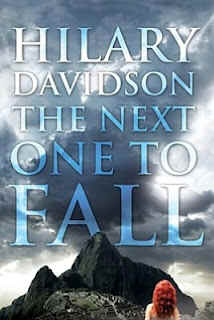 The
recap of Hilary Davidson’s Phoenix-area appearances is split between
two events, a Feb. 21 event at the Poisoned Pen in Scottsdale, and the
Authors @ The Teague event on Wed. Feb. 22. Hilary appeared both places
on her book tour for The Next One to Die, the second book to
feature travel writer Lily Moore. The
recap of Hilary Davidson’s Phoenix-area appearances is split between
two events, a Feb. 21 event at the Poisoned Pen in Scottsdale, and the
Authors @ The Teague event on Wed. Feb. 22. Hilary appeared both places
on her book tour for The Next One to Die, the second book to
feature travel writer Lily Moore.
Before
even starting the program at the Poisoned Pen, though, Barbara Peters,
owner of the Poisoned Pen, introduced another author in the audience,
Rhys Bowen. Rhys’ next book in her Molly Murphy series, Hush Now,
Don’t You Cry, is due out next month. (Rhys will be appearing at
the Velma Teague Library on March 12, along with Cara Black and Libby
Hellmann.) The book is set in Newport in the early 20th
century, amid all the fabulous estates. Molly and Daniel went there on
their honeymoon, but, even though Molly promised him she wouldn’t work
after they were married, she can’t resist getting involved in another
investigation.
To
introduce Hilary, Barbara showed the Jan/Feb issue of Crimespree
Magazine with Hilary’s picture on the cover. Ruth Jordan and Jen
Forbus interviewed Hilary for the cover article.
Hilary’s
first mystery, The Damage Done, came out in 2010, and went on to
win the Anthony Award for Best First Novel. Hilary said that’s why her
second book was a little delayed. Her publisher released The Damage
Done in paperback in January, so release date for The Next One to
Die was pushed back. The new book takes travel writer Lily Moore to
Peru.
Together
Barbara Peters and Hilary Davidson provided a fascinating glimpse at
Peru, using slides and their accounts of their travels to the country.
Barbara warned us. Travelers always know not to drink the water in Peru,
but they forget that they shouldn’t drink anything with ice in it.
And, she said the altitude is so high, you must wear a hat. She didn’t
heed either warning on her first trip to Peru in 1975, and she became
sick. In January 2010, she and her husband, Rob, went on a cruise that
ended in Lima. They planned to go to Machu Picchu, and they flew to
Cuzco. It’s a shock to the system to go from sea level to 11,500 feet.
She and Rob planned to hike the Inca Trail to Machu Picchu, but they
were evacuated before they could go. That was the year of the flood and
mud slides and people died. There were 15,000 people there with no way
to evacuate them except by helicopter. The helicopters could only take
thirty people at a time, and the ruins were weakened by the helicopters
having to land there.
So,
Barbara and Rob spent a week in Cuzco. Rob loved it because it’s an
eater’s paradise.
Hilary
and Barbara discussed the statue of the black Christ in Cuzco. It’s
called the Lord of the Tremblers. Inca structures were built with no
mortar and they have stood the test of time. But, in the mid-sixteenth
century, there was a huge earthquake. The church brought the black
Christ out, and the earthquake stopped. So, the natives decided that was
a powerful God, and many converted. When Barbara was there, they brought
the statue out for the first time in years. There was a Mass in the
square; they prayed for the rains to stop, and they walked the statue
around the square.
While we viewed slides of the markets, Hilary told
us there are 800 kinds of potatoes in Peru. According to an article in Smithsonian,
before the Europeans took potatoes back, there had never been enough
food in Europe. The population boomed because potatoes became a vital
food staple.
They also mentioned coca tea, which is in urns in
all the hotel lobbies. People are encouraged to drink the coca tea, and
are told it will help them adjust to the altitude. Coca comes from the
same plant as cocaine. People chew the leaves. There's coca candy. Coca
Cola was called that because cocaine was an ingredient in it at one
time.
Hilary
mentioned that she has a
gluten-free website because she has Celiac Disease. She didn’t
know what she could eat in Peru, but it’s gluten-free paradise with
potatoes, corn and quinoa. The Incas farmed for self-sufficiency, and
the terraced hills at Machu Picchu were designed so the community
would be self-sustaining. Asked how people made a living there,
Davidson told us there is a theory that Machu Picchu was a royal
retreat. It may have been a summer home, and the nobles built houses
around it.
She
and Barbara both mentioned there is a medication to help people
breathe at the high altitude. You need to start it 48 hours ahead of
time. If not, you can end up breathing so shallowly that you’ll wake
yourself up at night, thinking you’re suffocating. That scene when
Lily has that problem in the book is realistic.
Davidson
also told us about the Cuzco School of Art. Artists came from Spain to
work with the native artists. However, the native artists put their
own interpretation on the religious art. For instance, there’s a
painting of the Last Supper in a cathedral. Jesus and his apostles are
eating guinea pig. And, the native artists did not think it was
respectful to portray Jesus in a loin cloth. Instead, they painted him
in the linen skirt of the Inca nobility.
They
both discussed the train in to Machu Picchu. There’s no road. And,
if there’s an accident, people have to be airlifted out. People do
fall and die at that remote location.
Hilary
made her trip to Peru at the start of the rainy season at the end of
October. She stayed for three weeks, and she was hard hit by altitude
sickness because she tried to go without the medication. She was still
doing travel writing at the time, and her trip to Peru convinced her
to set up the Gluten-Free
Guidebook, an online resource. She learned a lot in three weeks.
On
Wednesday, Hilary introduced her character Lily Moore to the audience
at the Velma Teague Library. Lily
first appeared in the Anthony Award-winning mystery, The Damage
Done. She was a travel writer living in Spain, who was called back
to New York because her sister had died. But, when she arrived, she
found the body was another woman who had stolen her sister’s
identity, and was living in her apartment. This is a dark book, and
Lily spends the rest of the book looking for her sister. By the end,
she discovered she had been betrayed by lots of people who were close
to her.
The
Next One to Fall
starts three months later. Lily still trusts her best friend, Jesse.
He’s a travel photographer who asks her to accompany him to Peru. He
wants to spend time with her, for one thing. And, he’s been to Peru
before, and finds it beautiful, just breathtaking. He thinks a trip
there will get her out of her dark mood. But, they hear a couple
arguing, followed by a scream, and then they find a woman at the
bottom of a stone staircase. Before Jesse runs for help, Lily glimpsed
a man running away from the scene. With Jesse gone, the woman reveals
information about the man, and then dies.
Lily
knew the dead woman was traveling with a man, but he doesn’t come
forward. And, the police dismiss it as a woman on drugs who had an
accident. Lily hunts for him, and finds he’s the son of a very
wealthy man, and there are a number of dead and missing women in his
past. His first wife died in an accident. His second disappeared in
Peru. Now, this woman died. Lily feels he must be stopped, and she
wants justice for the women.
Once
Hilary introduced her books, we showed a slide show about Machu Picchu
that she has on her website. Machu Picchu is the Lost City of the
Incas, although it was not lost to the Incas. The Spaniards never
found it. 2011 was the 100th anniversary of the rediscovery
of the city. It’s remarkable because, although it’s in an
earthquake zone, it was not damaged by earthquakes. All the damage
there is man-made.
She
told us Cuzco, the Inca capital, became a Spanish city. They knocked
down the Inca temples and used the stone for their churches.
Davidson
told the audience that her three week trip there in 2007 inspired this
story. She was there during the rainy season. When the fog burned off,
she said, “This would be a perfect place to kill someone.” Her
husband, who was with her, said he didn’t think he wanted to travel
with her again.
She
also mentioned the breathing problems people have at the high altitude
in Cuzco. They become sleep-deprived, and can’t fall asleep. Lily was
in that state at the beginning of The Next One to Die, and she
had trouble trusting her own perceptions.
When
questions were asked about tourism and crime, Hilary said tourist
sites are reluctant to publish information about deaths at the sites.
The Natalie Holloway case is a good example. No one wanted to deal
with her disappearance, but the suspect was arrested later for
murdering a woman in Peru. He’s in prison now. It’s easier for
people to get away with committing crimes in foreign locations.
Asked
about rules for tourism at Machu Picchu, Daivdson answered there are
now new rules since so much of the damage there is man-made. They’re
trying to limit the number of tourists. The site has been loved to
death. At its peak, there were 3500 visitors a day. The site wasn’t
built to handle that many people. Now, the maximum number allowed per
day is 2500. And, a permit is required to go to Machu Picchu. It costs
$150 per person per day. In the last ten years, Peru has tried to
preserve its history. Hiram Bingham, who rediscovered Machu Picchu
took many of the artifacts back to Yale. Yale has told the Peruvian
government they will return them once Peru is able to be caregivers
for them. Until now, they have not been able to do that.
Hilary
told us she’s fascinated by the Incas. The character of Jesse reflects
that interest. He describes many of the Inca traditions in the book. For
instance, the stones in their buildings fitted together without mortar.
And, they couldn’t use llamas to transport much of the stone because
llamas can’t carry heavy weight. And, this was a society that never
discovered the wheel. There’s no description as to how they
transported all the stones. They didn’t really have a writing system.
Their method of tying knots to communicate is described in the book.
And, they had symbols imprinted on silver and gold to communicate. Some
of those symbols explained their theory of the cosmos. But, that silver
and gold was shipped back to Spain and melted down. Everything they
represented in silver and gold has been lost. They were astronomers.
And, the Temple of the Sun has a series of windows through which
constellations could sometimes be seen. But, no one knows how they
utilized that knowledge.
Peru
attracts some bizarre tourists. There are drug tourists because there
are drugs that are legal to use in Peru. Marijuana is legal there.
There’s also a natural LSD that is legal, and it’s traditional for
tribes to take it together and have group visions.
Then
there are the people who go to Peru to find UFOs. There was a pre-Inca
civilization who carved designs in the earth. They’re called Nazca
Lines, and many of them depict animals. But, the designs can’t be
seen from the ground, only from the air. So, there’s a culture of
UFO hunters in Peru. They’re part of the book, but not at the core
of the story.
Hilary
Davidson concluded the presentation by discussing her third book. She
always had three books in mind, although she initially had a two-book
contract. She has another two-book deal. The third Lily Moore story is
the first of those two books. It’s set shortly after the end of The
Next One to Fall. It starts in Acapulco, which has been luring
travel writers. Lily goes there with another journalist, and the other
woman vanishes. It’s then she learns the property where she is has
been bought by her former boyfriend’s company.
Hilary
Davidson takes readers into Lily Moore’s world, and the world of
Peru in her latest book, The Next One to Fall.
Hilary Davidson's website is
www.hilarydavidson.com
The Next One to Fall by Hilary Davidson. Tom
Doherty Associates, ©2012. ISBN 9780765326980 (hardcover), 352p.
 |
| Hilary
Davidson and Lesa Holstine |
|
| `
Lesa
Holstine, Library Manager, Velma Teague Branch Library
Receives
the 2011 Arizona Library Association's
Outstanding
Library Service Award
By
Bette Sharpe Glendale Daily Planet
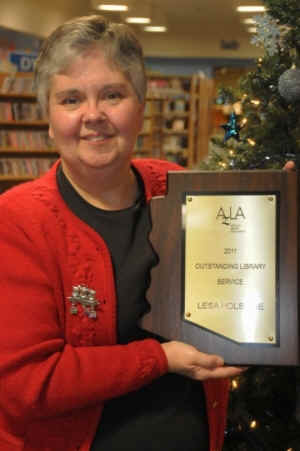 Lesa
Holstine, Library Manager for Velma Teague Branch Library,
received the Arizona State Library Association's 2011
Outstanding Library Service Award.
Lesa was nominated by members of her staff, Barbara
Peters, The Poisoned Pen Bookstore and Editor, Poisoned Pen
Press; and Talia Sherer,Director, Library Marketing Macmillan. Lesa
Holstine, Library Manager for Velma Teague Branch Library,
received the Arizona State Library Association's 2011
Outstanding Library Service Award.
Lesa was nominated by members of her staff, Barbara
Peters, The Poisoned Pen Bookstore and Editor, Poisoned Pen
Press; and Talia Sherer,Director, Library Marketing Macmillan.
Lesa
knew she wanted to be a librarian since she was a young girl.
She loved reading mysteries as a child and it is
evident that her passion for books, reading and mysteries is
still with her and seems to be growing even stronger.
In
Lesa's own words,"When I was sixteen, I found my
life's passion, working in the public library.
It's been a joy to share my love of books and reading
with the people in the communities where I've lived and
worked, as well as the community of far-flung readers on the
Internet."
"To
me, the public service award recognizes the people who have
given me a gift, a love of books, libraries, and people, and
the opportunity to bring them together."
Thank you for honoring all those people who gave me
roots, and all those people in the communities I've served, by
presenting me with the award."
Lesa
admits, authors are her rock stars.
She shares her enthusiasm and passion for books and
reading through her work at Velma Teague where she has to wear
many hats. She is
often providing adult and youth reference services, and
holding quarterly Brown Bag Luncheons where she shares 15 book
titles (fiction and non-fiction) that are worth considering as
possible reads. Also,
Lesa holds monthly lunchtime book talks where library staff
talk about books they have read.
This helps to multiply the number of book titles
library staff is familiar with which is really a mini course
in Reader's Advisory.
Lesa's
love of reading is one reason she chairs the library's Readers
Advisory Committee. Her reviews can be found in such publications as Library
Journal, Generflecting, and Mystery Readers Journal,
and The Strand Magazine.
Lesa started the Authors @ the Teague program several
years ago. This program has brought local, national and international
authors to downtown Glendale.
The faces from the back of the book jacket come to
Glendale, in person, to talk about their writing, personal
lives and of course about their books.
Talia
Sherer, Director, Library Marketing Macmillan wrote this in
her nomination letter.
"She
is absolutely selfless when it comes to promoting books and
reading. Whether
it's on her blog
http://lesasbookcritiques.blogspot.com/, at the
staff-focused Brown Bag Lunches, or her participation at the
"Back to the Beach" program - there is a fire inside
here and a passion for books that is inspiring."
Lesa's
internationally known and nationally syndicated book blog,
http://lesasbookcritiques.blogspot.com/,
and has won the Spinetingler Award for Best Reviewer in 2009
and 2010. Bestselling
mystery author Louise Penny, is one of many well know authors
that have acknowledged Lesa's contribution to libraries,
readers, and authors.
Lesa
is an editor at
Glendale
Daily Planet and presents articles on Arizona
writers and book related items in her Book Topics section on
the 'Planet. Glendale
Daily Planet publisher Ed Sharpe stated, " Lesa's
material is timely, captivating and entertaining… Her award
winning contributed work is responsible in part for the
Glendale Daily Planet obtaining a Hermes Creative Award
and a MARCOM
Award in 2011, and many other awards in previous years."
Barbara
Peters, The Poisoned Pen Bookstore and Editor, Poisoned Pen
Press made these remarks to the AzLA Service Awards Chair.
"It has been my please to work with Velma
Teague's Lesa Holstine for a number of years and in a variety
of reader, author, and community outreach programs.
Plus she's the best blogger I know, a model to everyone
who wishes to communicate a love of reading and news of
publishing. I'm
not too shabby at this myself so to say I wish I could emulate
her is a measure of how great is her reach and
influence."
For
Lesa, it is about the books and libraries and bringing the two
together. Congratulations
Lesa.
|
Sketch
Me If You Can by Sharon Pape

Review by: Lesa Holstine Glendale Daily Planet Book
Topics Editor
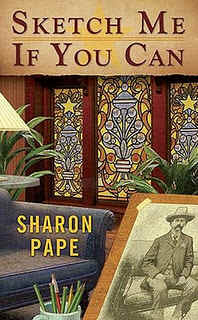 I
had been hoarding the books in Sharon Pape’s Portrait of
Crime mystery series, so when she told me the third one was
due out soon, it was time to go back and start the first
book, Sketch Me If You Can. I
had been hoarding the books in Sharon Pape’s Portrait of
Crime mystery series, so when she told me the third one was
due out soon, it was time to go back and start the first
book, Sketch Me If You Can.
Zeke
Drummond thinks Rory McCain is, “One cantankerous
female.”” Of course, Zeke is the ghost of a federal
marshal, who really doesn’t understand the role of modern
women. Rory, a sketch artist for the Suffolk County Police
on Long Island, thinks he’s too overbearing. She accuses
Zeke of being, “The most frustrating, obstinate man I’ve
ever met”. Maybe they both need to back off just a little.
When
Rory’s uncle, Mac McCain died, her left her his car, his
private investigation business, and his house. The first
couple times she went to his house, she was mourning his
death, and just thought maybe she missed him when she felt
uneasy in the house. She hadn’t read the letter Mac left
her, telling her his business boomed after he partnered with
the ghost in his house, the ghost of a federal marshal.
Ezekial Drummond had been shot in the back there in 1878.
So, she was in denial when Zeke first showed up.
It’s
while she’s cleaning out her uncle’s office that one of
his former clients approaches Rory to ask her to look into
his sister’s death. He swears she was murdered, while the
police say it was an accident in the new house she was
decorating. She’s intrigued enough to ask a few questions.
But, when the questions stir up trouble, Rory and Zeke start
pushing back. And, they both suspect the woman’s death may
have resulted in Mac’s death. It’s hard to stop a
“cantankerous woman” and the ghost of an “obstinate
man.”
This
debut novel in the series is fun, with two characters with
interesting backgrounds. Zeke Drummond was a federal marshal
in the Arizona territory in 1878. The author provides just
enough of that storyline in Arizona to pique the reader’s
interest. Zeke was following a man there who kidnapped young
girls, and after finding a girl’s body in the desert, he
was more determined to find the killer. This book focuses on
Zeke’s search in Arizona. It doesn’t reveal yet how Zeke
reached New York, but I’m sure it’s coming.
Rory
McCain is a police sketch artist, licensed as a detective
because of that job. It’s a job that works for her in this
case, and she’s able to work with Zeke for needed
sketches. Rory and Zeke may have worked successfully
together to wrap up a couple murder cases in Sketch Me If
You Can, but it’s going to be fun to watch the
relationship between these two as they squabble, learn to
work together, and learn to work across the difference in
styles that result from living in different centuries.
Sketch
Me If You Can by Sharon Pape. Berkley Prime Crime. ©2010.
ISBN 9780425236048 (paperback), 293p.
|
Authors @ the Teague -
Author
Kris Neri Brings “Magical Alienation”
to the Library
Saturday, December 17

GLENDALE,
Ariz. – Award-winning local author Kris Neri will discuss
and sign her latest mystery, “Magical Alienation,” during
the upcoming Authors @ the Teague event at 2 p.m. on Saturday,
December 17 at Velma Teague Branch Library, 7010 N. 58th
Ave.
Fake psychic Samantha Brennan and genuine Celtic
goddess/FBI Special Agent Annabelle Haggerty return for more
madcap magical mayhem in this second entry in the Magical
Mystery series, the sequel to “High Crimes on the Magical
Plane.” Shape shifters, gods, Roswell, Area 51, rock stars,
and a harmonic convergence in Sedona conjure up another
deviously twisty, fast-paced, “funny, pell-mell romp of an
adventure.” (Diana
Gabaldon, “New York Times” bestselling author of the
Outlander series on “High Crimes on the Magical Plane”)
Owner of The Well Red Coyote, repeatedly voted Best
Bookstore in Sedona, Kris Neri teaches crime writing online
for the Writers’ Program of the UCLA Extension School.
Also known for her Tracy Eaton mystery series, she is a
two-time winner of the Derringer Award as well as a Pushcart
Prize, Agatha, Anthony, Macavity, and Lefty Award nominee.
For more information, see her website at http://www.krisneri.com.
The
program is free. Books
will be available for purchase and signing.
For more information, please call 623-930-3439.
|
|
Jeri Westerson for
Authors @ The Teague

Story
and Photos by: Lesa Holstine Glendale Daily Planet Book
Topics Editor
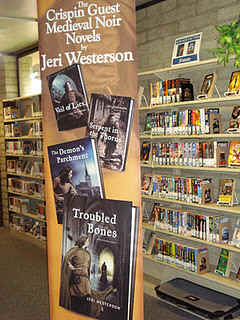 Author
Rebecca Cantrell is right. When Jeri Westerson appears for an author
event, she brings cool toys. She recently appeared for Authors @ The
Teague on her Troubled Bones tour. Anyone who wanted to handle
her medieval weapons was welcome to try them out. Jeri does a terrific
program, fun and informative. Author
Rebecca Cantrell is right. When Jeri Westerson appears for an author
event, she brings cool toys. She recently appeared for Authors @ The
Teague on her Troubled Bones tour. Anyone who wanted to handle
her medieval weapons was welcome to try them out. Jeri does a terrific
program, fun and informative.
Westerson calls her style medieval noir. She
said she was first writing historical fiction at a time when Publishers
Weekly called historical fiction dead. She tried to sell it for
ten years, and saw her agents come and go. One of those agents said,
why don’t we try mysteries. After more rejections, Jeri thought
maybe she should try mysteries. She decided to write medieval
mysteries. She always loved Ellis Peters’ Brother Cadfael. But many
of those medieval mysteries have a slower pace with a monk or nun as
the protagonist. Westerson wanted to do something much different.

Westerson was reading Chandler and Hammett, so
she decided to create a hardboiled detective in a medieval setting.
Then, he would be hired to solve mysteries. She made him the typical
lone detective. Crispin Guest is hard-drinking and hard-living. He
gets beaten up. He’s a sucker for a dame in trouble. But, he also
was a knight, so he’s educated, and has the skills he needs to be an
investigator. He can read and write. He knows several languages. He
has in intense sense of justice and honor. When Crispin Guest
was convicted of treason, he lost his knighthood. Everything that
defined him was taken. Guest redefines himself as “the Tracker.”
 London
becomes another character in Westerson’s books. Each book deals with
a religious relic or venerated object. Troubled Bones, the
latest book, deals with relics at Canterbury Cathedral, the bones of
Thomas à Becket. Crispin got in some trouble in London, and the
sheriff offered him options, go to jail or do a job for the Archbishop
of Canterbury. So, Guest agreed to guard the bones of Thomas à
Becket. The Archbishop was afraid the Lollards would steal them.
Lollards were members of a reformist movement, and they didn’t
believe in relics. While Crispin was in the cathedral, a pilgrim was
murdered. London
becomes another character in Westerson’s books. Each book deals with
a religious relic or venerated object. Troubled Bones, the
latest book, deals with relics at Canterbury Cathedral, the bones of
Thomas à Becket. Crispin got in some trouble in London, and the
sheriff offered him options, go to jail or do a job for the Archbishop
of Canterbury. So, Guest agreed to guard the bones of Thomas à
Becket. The Archbishop was afraid the Lollards would steal them.
Lollards were members of a reformist movement, and they didn’t
believe in relics. While Crispin was in the cathedral, a pilgrim was
murdered.
Westerson told us she had been waiting to do
this book since she knew she was setting her series in the 14th
century. She wanted to do this story. Jeri’s parents were rabid
Anglophiles. They were history buffs, particularly British history
buffs. Their collection included fiction and nonfiction from authors
such as Thomas B. Costain and Norah Lofts.
As a kid, Jeri read a child’s version of The
Canterbury Tales when she was eight nor nine. It had great
illustrations. She loved the pilgrims. Then the afterword said Chaucer
died before he finished The Canterbury Tales, and she was
upset. Naturally, some of the bawdier tales were left out of the
child’s version.
Jeri’s mother had a record of The
Canterbury Tales. It included the prologue and some of the
stories, written and read in middle English. Westerson loved the
lyrical flow of the language.
 When
Westerson was young, her parents took the family to lots of museums.
For a family of five, it was cheap entertainment because admission was
free. One they visited was the Huntington Library. It had a Gutenberg
Bible. There was one of Shakespeare’s quartos, and one of his bad
quartos. And, there was the Ellesmere Manuscript. It was commissioned
after Chaucer’s death. It was written by hand, and contains
illustrations of all the pilgrims and Chaucer. When
Westerson was young, her parents took the family to lots of museums.
For a family of five, it was cheap entertainment because admission was
free. One they visited was the Huntington Library. It had a Gutenberg
Bible. There was one of Shakespeare’s quartos, and one of his bad
quartos. And, there was the Ellesmere Manuscript. It was commissioned
after Chaucer’s death. It was written by hand, and contains
illustrations of all the pilgrims and Chaucer.
So, Westerson has been waiting to get to the
right year to write about The Canterbury Tales and Chaucer. In
Troubled Bones, Crispin Guest meets the pilgrims and Chaucer. Chaucer
was quite an interesting person. He was a knight, a poet, a spy for
the king. His sister-in-law was the mistress of the Duke of Lancaster,
John of Gaunt.
Westerson said she does most of her research in
university libraries. There are a number of archives on the Internet.
Many of the small archives are thrilled to answer her questions.
She’s only been to Europe once when she was eighteen. She was there
for a month in England and northern Europe.
It was Canterbury Cathedral that struck her, and
touched her the most. Westerson showed us a diagram of the Cathedral,
showing it built outside the town. The monastery was there as well,
and it was self-sufficient. The Archbishop of Canterbury, the voice of
Rome, had his own manor house. She showed us a picture of the narrow
gate leading to the cathedral, perfect as a gate to get to the
heavenly cathedral. The west gate was still being built in Crispin’s
days. There were towers and guards. Mercy Lane, on the way to the
cathedral, was a medieval lane. Canterbury Cathedral is very much a
character in Troubled Bones.
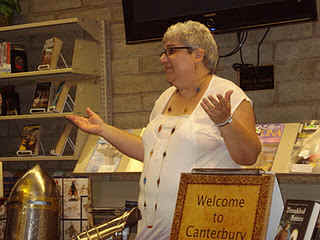 Thomas
à Becket was murdered in Canterbury Cathedral. At one time, he was
King Henry II's best friend. Henry II was the father of Richard the
Lionheart and King John. Becket was Chancellor of England. Henry II
had a problem with the Church. He wanted to try clerics in court, and
the Archbishop of Canterbury told him no. They had to be tried in
Church courts. Then, the Archbishop died, and Henry seized the
opportunity. He had Thomas made Archbishop, even though he wasn’t a
priest. Thomas
à Becket was murdered in Canterbury Cathedral. At one time, he was
King Henry II's best friend. Henry II was the father of Richard the
Lionheart and King John. Becket was Chancellor of England. Henry II
had a problem with the Church. He wanted to try clerics in court, and
the Archbishop of Canterbury told him no. They had to be tried in
Church courts. Then, the Archbishop died, and Henry seized the
opportunity. He had Thomas made Archbishop, even though he wasn’t a
priest.
However, Thomas took his job seriously, and the
next time Henry II brought up the subject of trying priests, Thomas
said no. The priests were under the jurisdiction of the Church. Henry
was frustrated, and, at court, asked, “Who will rid me of the
troublesome priest?” Four barons killed him while he was at prayer
in the cathedral. The people immediately declared Becket a saint, and
the Church made it official only a year later. Canterbury Cathedral
became a place of pilgrimage. Henry II said, please forgive me
for having him murdered, and wore sackcloth. Pilgrimage sites were
very popular at the time because people could get points off their
time in purgatory by making a pilgrimage.
Westerson showed us illustrations of Becket’s
shrine. A canopy was lowered over it to protect it at night. During
the day, though, people could touch the bones. It’s just that some
started to take home bones as souvenirs. There was a charge to come
and see the shrine.
The shrine to Thomas à Becket is no longer
there. There was another Henry who had problems with the Church. Henry
VIII took over the Church of England. He dissolved the monasteries,
and destroyed shrines, particularly this one. It was a shrine to an
Archbishop who opposed a king named Henry.
The coffin of Edward of Woodstock, the Black
Prince, is also there. His surcoat, helm, gauntlets and sword are on
display. It’s unusual to have the originals in a museum.
Jeri told us she likes to write about medieval
times because she likes to play with the weapons. She does pack them
in her luggage when she flies. The TSA always picks her luggage when
they do random searches. She thinks they actually take everything out
and play with them.
Then, Westerson took time to show us the weapons
she brought. The broadsword weighed three pounds, and was forty-four
inches long. It was a one-handed weapon, more or less. It was designed
as a hacking and slashing weapon. It was not used as a foil, as it is
in many films.
She said everyone needed a good dagger. If
you’re caring a small shield, a buckler, it’s also good to have a
dagger. That’s where the term swashbuckler came from. A man could
block a broadsword with a dagger and a buckler. Women wore
jewel-encrusted daggers. Westerson even recommended a particular
dagger because if someone was stabbing with a dagger, there would be
momentum with their hand, and when the dagger stops in the body, the
hand might continue, and the person would be cut. So, she said you
wanted a dagger with a piece to stop the hand from being cut.
Jeri had a piece of mail in her possession. She
said it was part of a piece sent to a museum for repairs. It would
rust, so it needed to be cleaned in sand. She demonstrated the use of
a little battleax, saying it would be used on horseback, and the user
would slash away. She showed us what most of us would have called a
mace. But, hers is a flail. Attached with a chain, it’s a flail.
Without a chain, it’s a mace. That would be used on horseback.
She showed us the gauntlet, then the sugarloaf
helm. It was called that because sugar came in a container of that
shape.
 Jeri
Westerson's next book, Blood Lance, has jousting in it. She'll
have a powerpoint in which she’s on a 2000 pound Percheron dressed
as a knight. It’s hard to see with the helm. But, the knight on that
horse would plow through foot soldiers. Jeri
Westerson's next book, Blood Lance, has jousting in it. She'll
have a powerpoint in which she’s on a 2000 pound Percheron dressed
as a knight. It’s hard to see with the helm. But, the knight on that
horse would plow through foot soldiers.
Asked to talk about Crispin’s apprentice, Jack
Tucker, Westerson said she introduced him in the first book, Veil
of Lies. He was an orphan, eleven years old, and a cutpurse. Each
book is now a year later, so Jack ages. Westerson has turned in
book five, and is working on six. Jack is a Huck Finn, Artful Dodger
character. He’s all kinds of things to Crispin, including the child
and family he’ll never have. After a couple books, Crispin takes him
under his wing, seeing him as his legacy. In Troubled Bones, Jack has
his own chapters, and many readers say those are their favorites.
Westerson likes writing a series because she’s
writing the world’s largest novel. She knows the backstory. Jack’s
growing up, and, someday, Crispin might. Jack starts at eleven,
and he’s now thirteen/fourteen. The characters change in the course
of the series.
Most of the books are set in London. Maybe one
will be set in France. Chaucer is in the next one. In this series, she
can follow Crispin, but also can follow the historical timeline. She
can include the politics of the time, and sometimes, more of the
actual characters who lived.
To finish up, members of the audience tried on
the helm and gauntlet, and played with the medieval weapons while Jeri
Westerson signed books. This program combined books, history and
weapons, a little different for Authors @ The Teague.
Jeri Westerson's website is www.jeriwesterson.com
Troubled Bones by Jeri Westerson. St. Martin’s
Minotaur. ©2011. ISBN 9780312621636 (hardcover), 288p.
|
|
Desert Sleuths for Authors @ The Teague - SoWest, So Wild - Panel
Discussion!

Story
and Most Photos by: Lesa Holstine Glendale Daily Planet Book
Topics Editor

Group Photo by Ed Sharpe, Glendale
Daily Planet
 The
Desert Sleuths were supposed to appear at the Velma Teague Library on
Saturday, but, because the electricity was off for three hours, we
moved to Plan B, and moved the group to a meeting room next door.
Thirteen members of Desert Sleuths, the Arizona Chapter of Sisters in
Crime, showed up to promote their new mystery anthology, SoWest, So
Wild. Roni Olson, president of the group, moderated the program. The
Desert Sleuths were supposed to appear at the Velma Teague Library on
Saturday, but, because the electricity was off for three hours, we
moved to Plan B, and moved the group to a meeting room next door.
Thirteen members of Desert Sleuths, the Arizona Chapter of Sisters in
Crime, showed up to promote their new mystery anthology, SoWest, So
Wild. Roni Olson, president of the group, moderated the program.
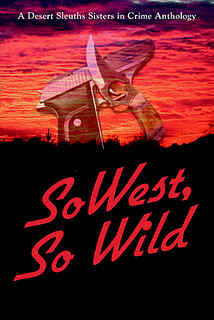 Roni
kicked off the program saying Desert Sleuths is the state-wide Sisters
in Crime chapter for Arizona. Sisters in Crime was started twenty-five
years ago to promote the work of women crime writers. Sara Paretsky
and the other founders saw a discrepancy in the treatment of female
writers. Today, the group consists of authors, readers, and people who
love both. Roni
kicked off the program saying Desert Sleuths is the state-wide Sisters
in Crime chapter for Arizona. Sisters in Crime was started twenty-five
years ago to promote the work of women crime writers. Sara Paretsky
and the other founders saw a discrepancy in the treatment of female
writers. Today, the group consists of authors, readers, and people who
love both.
Then,
Roni asked each author to just do a short introduction for their
stories. She started with CR Bolinski, author of “A Tumbleweed
Mystery.” Carole said she knew her story had to be set outside, with
lots of tumbleweed. SoWest, So Wild was perfect for that
setting.
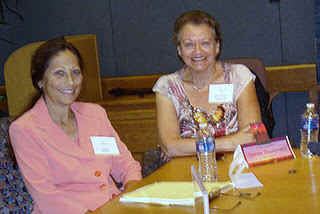 |
CR
Bolinski and Susan Buadavari
|
Susan
Budavari’s story is “The Danger of Impulse Shopping.” It’s
about a woman who stops at a convenience store, a divorced woman at a
time a serial killer was loose. Susan said when the Baseline Killer
was in Phoenix, she had a number of friends who were afraid to go to
various parts of the city. They might expose the next serial killer.
Howard
“Doc” Carron wrote “Moshe Goes to Arizona.” It’s about a
cattle drive. Doc grew up in New York, and he had already written
westerns, so he had some experience with the background. His story is
set in the 1880s. It was originally set in Wyoming, because Carron was
familiar with Wyoming, but the editors gently suggested he move it to
Arizona.
 |
Howard
"Doc" Carron and Leslie Kohler
|
Leslie
Kohler’s story is “Shadow of Darkness,” about an escapee from
Folsom Prison. Kohler grew up close to Folsom Prison. She could see
the guards in the turrets, with their rifles. She and her family
shopped at the prison gift shop. Her father had toured it, but, at
time, women couldn’t tour Folsom Prison. Since then, her sister has
worked for the prison system, and has been in prisons all over. Folsom
Prison is no longer a maximum security prison; it’s a medium prison.
And, the area where Kohler grew up, is now filled with million dollar
homes. Leslie did say if you’re going to live near a prison, it’s
best to live near a maximum security one, because the prisoners rarely
escape.
Does
Merle McCann's title, "Murder at Rocking Witches Ranch,"
sound as if it's about French grape growing stock in Arizona? Merle
usually writes historical fiction. The story is based on historical
fact, facts that McCann uncovered through a circuitous route. Email
from someone about the Jerome Winery gave her the best clue. It
mentioned mission grapes. The Immaculate Conception Cathedral in
Brownsville, Texas, was built in 1850, ten years after the Civil War.
Winemaking nuns accompanied a Frenchman there. Then, the Church as
named a Cathedral in 1874. McCann knew she could do something with
this material.
 |
Merle
McCann and Toni Niesen
|
Toni
Niesen was asked about calendar sticks since her story is, "A
Pair of Calendar Sticks." She said she first became interested in
them when she was working with the Salt Water Pima, and they called
their resort "Talking Sticks." She said calendar sticks are
historical, but there wasn't a lot written about them that was
accessible. Then, she found information written by Frank Russell who
studied the Pimas in the early 1900s. That information, along with
information from Arizona Highways led to her story with
calendar sticks and a water theme.
 |
Amy
Schuster
|
Amy
Schuster's "Fowl Play" is set at a clown college. Why a
clown college? She told us she's always been drawn to the absurd.
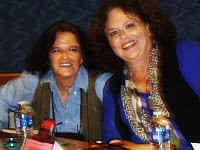 |
Deborah
J. Ledford and Roni Olson
|
Deborah
J. Ledford is one of the editors of SoWest, So Wild. Her story
is, "A Tombstone Epitaph." Roni asked her about that, saying
Deborah normally doesn't write period pieces. Deb said she never does,
but, with the theme, she thought she should, and she expected to have
all kinds of period pieces. Instead, hers was the only entry about the
Old West.
 |
Roni
Olson and Virginia Nosky
|
Virginia
Nosky's "All Four One" asks if identical quadruplets can get
away with murder. Virginia told us if it was a perfect crime, no one
would no about it. But, this one offers a perfect crime, with a
perfect alibi. Four gorgeous sisters set out to murder their nasty
stepfather.
In
Nancy Newcomer's "Coyote's Bones," a coyote digs up bones in
a backyard, human bones. Nancy told us it's based on her own
experience. In the '90s, she moved to Fountain Hills. Her backyard
ended in a wash, and there was lots of wildlife. One day, she looked
outside her back window, and there was a coyote out there digging in
the dirt. He dug up a bone, probably a rabbit leg. Nancy changed that
in her story, and it became a human bone.
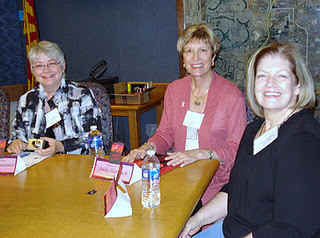 |
Nancy
Newcomer, Judy Starbuck and JoAnne Zeterberg
|
Judy
Starbuck's
In
JoAnne Zeterberg's "Ghost in the Rocks," a medicine man is
held at gunpoint. JoAnne said she starts with characters, and puts
them in inopportune moments. She was lucky enough to camp with a
Navajo family once, and the man described his uncle, a medicine man.
Roni
asked them why they write mysteries. Deborah Ledford answered,
"They're the ultimate escape." Doc Carron said it's good and
evil. He told us he often has a solution that the law wouldn't take
care of, but justice is different than law. He said during the
Depression movies flourished. People needed a break. Now, they do it
with books. Virginia Nosky said it's fun to put yourself in the
situation. Could you have done it better?
One
audience member asked if their anthologies were available on Kindle.
She's in a book group, and they all use Kindles. Ledford answered that
they're in the process of making them available. However, some of the
authors have their own books available on Kindle. Leslie Kohler is the
author of Sins of the Border. Deborah J. Ledford has written Staccato
and the Hillerman Sky Award Nominee, Snare. The Fall From
Paradise Valley is Virginia Nosky's book.
Merle
McCann told the audience that four or five of the stories from How
Not to Survive a Vacation are available online through ipulp
fiction.
There
have been three anthologies published by Desert Sleuths. The first was
How Not to Survive the Holidays. Then came How Not to
Survive a Vacation. SoWest, So Wild shows that the West is still
wild. The stories are all set in the Southwest, most in Arizona. It's
a diverse collection.
Roni's
next question involved setting. Howard Carron's stories are all based
on places where he's been. One third of his life was spent overseas.
He had to do research to write this one, set in Arizona. But, he's a
reference librarian, and enjoys doing research. He wants to have it
accurate. Orthodox Jews eat kosher food. They can't work on Saturday.
This became a problem for Moshe, his character, who was on a cattle
drive. There's interest in expanding Moshe's adventures to a novel, so
Doc is doing more research. He's probably going to set it in Wyoming,
though, not Arizona. He's familiar with the Jews in Brooklyn. He
learned there were 75 Jewish families in Cheyenne in the 1880s. That
leaves opportunities for Moshe. Research is key.
Leslie
Kohler's story is told from the perspective of a young girl. She knows
that from her own life. But, she didn't know Folsom Prison was built
to provide labor for Folsom Dam so a wealthy logger could bring his
logs down by river.
Carol
said Arizona is a big part of her writing. She lives outside Prescott
in Chino Valley. Her neighbors are gophers, rattlesnakes, cows,
coyotes. They all interest her. She wanted to use tumbleweed in this
story because there was so much tumbleweed up north. Roads were
closed, and tumbleweed was all over. It became an issue, and the mayor
asked people to take the tumbleweed away and burn it. It became funny.
So she wanted to use it as a basis of a story.
Judy
Starbuck has six short stories in anthologies. Some are set in places
where she's never been, but places that interested her. She's
fascinated by setting. Her story is based on Patagonia, a place that
has birdwatchers, drug dealers, tourists.
Virginia
Nosky would like to go back to using Arizona as a setting. There's so
much here, desert, mountains. And, everything is harsh, weather, the
heat. There's snow and cold. Everything bites or scratches. Setting is
almost a character in Nosky's books.
Merle
McCann said it's convenient to use Arizona. Phoenix, Tucson and
Flagstaff represent the metropolis. But, there are huge horse ranches,
dog shows. There's a great deal of animal activities here. Washes are
used in Scottsdale, and wild animals are found in suburban and urban
communities. There are javelina, bobcats, and there was a mountain
lion sighted in McCann's neighborhood recently.
The
final question of the day related to work habits. Roni said their
writing conference in August featured this topic. She said everyone
has different habits. She's just settling in to write 2000 words a
day. But, it's important for writers to get in a chair and get their
fingers moving every day.
And,
Leslie said she often leaves the house, and tries to avoid online
distractions.
Howard
summed it up, though, agreeing with Roni Olson. The key is to write
every day.
Actually,
though, I ended the program. I brought out the celebratory cake. I had
a special cake made at Shelly's Bakery in downtown Glendale. It was
done in the colors from SoWest, So Wild and featured the same weapons
on the cake. It celebrated the 25th anniversary of Sisters in Crime
with a "25" under a magnifying glass. And, everything on the
beautiful cake was edible. Thank you, Shelly!
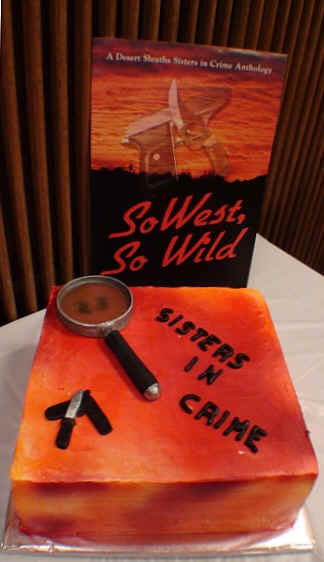 Cake Photo By Ed Sharpe
Cake Photo By Ed Sharpe
SoWest,
So Wild by Desert Sleuths. DS Publishing. ©2011. ISBN 9780982877418
(paperback), 209p.
lholstine@yahoo.com
|
Jeri
Westerson will be appearing for
Authors @ The Teague on Monday, Oct. 24 at 2 p.m.
Troubled
Bones by Jeri Westerson
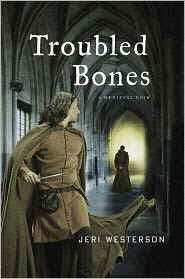 I
just fell in love with a character, Jeri Westerson’s Crispin Guest. Troubled
Bones is the fourth in her medieval noir series. Now, I have to go
back and read the three earlier books. Fortunately, they’re in that
bottomless pit I call a closet. I
just fell in love with a character, Jeri Westerson’s Crispin Guest. Troubled
Bones is the fourth in her medieval noir series. Now, I have to go
back and read the three earlier books. Fortunately, they’re in that
bottomless pit I call a closet.
Crispin
Guest was once a knight, but he lost everything, his barony, his lands,
and his knighthood, eight years earlier because of a trap to discover
traitors against the king. His patron intervened, and Crispin was
allowed to live, but he almost starved until he discovered a talent for
investigating crime. Now, as London’s Tracker, he
works with his protégé, a thirteen-year-old former beggar, Jack
Tucker.
One
night of drunkenness in a tavern, though, forces Crispin to take a job
for the Archbishop of Canterbury, William de Courtenay. He had two jobs
for Guest. Lollard heretics had threatened to steal the bones of Thomas
à Becket, and the Archbishop wanted Crispin to protect them. And, he
suspected one of his own monks was a Lollard, and wanted Guest to
uncover the heretic.
As
soon as Crispin arrives at his lodging, he finds a group of pilgrims
there, including an old friend, Geoffrey Chaucer. It’s an unusual
group of travelers, including a priest and nuns, a mistress from Bath, a
Pardoner, a miller. And, when one of that party is murdered during
Crispin’s watch in the cathedral, he’s determined to find the
killer. It isn’t long, though, before suspicion falls on Guest’s old
friend, Chaucer.
Fans
of historical mysteries should appreciate this combination of history
and literature as readers get the chance to “meet” some of
Chaucer’s pilgrims from The Canterbury Tales. But, you don’t
have to like historicals to enjoy the fascinating puzzle in
Westerson’s latest mystery. The pace is faster, and the story more
readable than many historical mysteries. It doesn’t get bogged down in
the details. Troubled Bones is a compelling
mystery with complex webs of intrigue, and the pace of a thriller.
Crispin
Guest and Jack Tucker may have been down on their luck, but they have a
code of honor. Westerson’s author’s notes indicate that Jack is
growing up, so it will be interesting to go back and read about the two
characters in the earlier books. Westerson’s
character description and development were excellent. It was easy to
become caught up in the lives of Crispin and Jack, even though this was
the first book I read in the series.
Troubled
Bones offers so much for mystery readers, good characters, a
fascinating plot, history and suspense. If you can’t get the earlier
books, don’t hesitate to start with this one. But, I’m going back to
learn more about Crispin Guest, the disgraced knight, and his
apprentice, Jack Tucker.
Troubled
Bones by Jeri Westerson. St. Martin’s Minotaur. ©2011. ISBN
9780312621636 (hardcover), 288p.
|
 Who
wouldn't like a mystery that features cupcakes? I'll admit there are a
number of reasons I enjoy Jenn McKinlay's Cupcake Bakery mysteries.
They're set in Scottsdale, Arizona, and I recognize a number of the
sites in the books. It's hard to resist all those recipes for cupcakes.
It’s fun to watch the three protagonists challenge each other to movie
quotes. I know and like Jenn, a fellow librarian. But, the best
reason to read her third book in this series, Death by the Dozen?
It’s the best yet, with great characters, and a terrific, tightly
written plot. Who
wouldn't like a mystery that features cupcakes? I'll admit there are a
number of reasons I enjoy Jenn McKinlay's Cupcake Bakery mysteries.
They're set in Scottsdale, Arizona, and I recognize a number of the
sites in the books. It's hard to resist all those recipes for cupcakes.
It’s fun to watch the three protagonists challenge each other to movie
quotes. I know and like Jenn, a fellow librarian. But, the best
reason to read her third book in this series, Death by the Dozen?
It’s the best yet, with great characters, and a terrific, tightly
written plot.
Melanie
Cooper and Angie DeLaura, owners of Fairy Tale Cupcake Bakery, just make
it in time to enter the bakery challenge at the Scottsdale Food
Festival, no thanks to their arch-rival Olivia Puckett, who does
everything she can to block their entry. Knowing they’ll be tied up
for a while, they ask for an intern from the local tech high school.
When Oz shows up, he’s not quite what they expect. He’s a hulking
teenager in black, with piercings and a chain. But, he does like to
bake.
Even
the judges aren’t what Mel and Angie expect. Two were men who hated
each other, teachers at the culinary institute where Mel went to school.
A third is a former fellow student who also disliked one of the judges,
Vic Mazzotta, now a Food Channel chef, and Mel’s mentor. Mel may know
most of the judges, but it’s still a formidable competition, a
challenge to bake with mystery ingredients.
Angie
is determined to beat Olivia Puckett in the competition. But, Mel’s
will to win is dampened when Vic ends up dead. Now, she just wants to
know who hated him enough to end his career for good.
McKinlay’s
Death by the Dozen has a little of everything. There’s so much
humor in the friends’ competition with Olivia, from the opening scene
to the end. There’s always humor when it comes to Angie’s seven
brothers. The baking challenge is thrilling to anyone who frequently
wants food challenges on television. There’s a little romance, along
with the suspense of the mystery and the food challenge.
Now,
Jenn McKinlay has added to her interesting cast of characters. Oz and
the new kitten in Mel’s life, Captain Jack, are welcome additions to a
cast that was already fun and a little off-beat. McKinlay truly has
written her strongest entry in this series. It’s almost as hard to
resist the appeal of Death by the Dozen as it is to resist
cupcakes.
Death
by the Dozen by Jenn McKinlay. Berkley Prime Crime.
©2011.
ISBN 9780425244050 (paperback), 294p.
lholstine@yahoo.com
|
Simon
Wood, a favorite author of the Desert Sleuths Chapter Sisters in Crime,
appeared for Authors @ The Teague.
____________________________________________________ 
Story
and Photo by: Lesa Holstine Glendale Daily Planet Book
Topics Editor
Simon
Wood is a favorite author of the Desert Sleuths Chapter Sisters in
Crime. This time, when he came to town on his book tour for Did Not
Finish, he appeared for Authors @ The Teague.
Simon
told us his writing is a product of the immigration service. He is
British. He met his wife in Costa Rica, and, romantically, they
decided to meet in different countries. They did that every few months
for eighteen months, and then decided it was easier to live together
in England or the U.S. So, he came to the U.S. on an extended visa,
but he wasn’t allowed to work for eighteen months. He had to decide
what to do with his time.
Wood
wanted to tell stories, but he was dyslexic. He was a good liar as a
kid. He took those months and worked on his first book, Accidents
Waiting to Happen. It took him three years, and it was a product of
the INS machine.
Wood
tackled writing in a mechanical way. He was a mechanical engineer who
designed things like oil rigs. He applied the same method to writing.
He listened to audios, and broke them down to study how the stories
worked. Since the INS wouldn’t let him have a job, he owes
everything to them.
Simon
has always followed his dreams. He loved race cars, and twenty years
ago, he went from racing a car to running his own cars and owning a
race team. At twenty-one, he was shipping cars around the country. He
loved it.
But,
he decided he needed to do something that was more respectable. So, he
became a pilot. Simon’s mother is convinced he does things just to
upset her. The government underwrote one third of the cost of his
training because they pay for vocational training. He did have to
crash land his own plane as a student pilot. But, it was one more
example of his brush with luck.
Then
he told us about his job as a private investigator. Since Simon
couldn't work, he and his wife had to come up with other ways to bring
in money. For a long time, his wife was a mystery shopper. First, she
had a contract to go to movie theaters. They saw a movie a week for
eighteen months. Then, they shopped at Albertson's. They would go up
and down aisles, examining displays, checking to see how long it took
someone to clean up spills. Mystery shopping was a method of quality
control.
Then,
they did restaurants. They ate at every four or five star restaurant
around San Francisco. They would eat there, and make sure everything
was OK, the service, the food. This was around the time of the tech
bubble, when people were paying $1000 for dinner. Wood and his wife
did this for three or four years. Then, they did hotels. Then, they
did casinos.
When
they investigated casinos, they worked for a little man, a blond Joe
Pesci. They went undercover into casinos for three or four days.
Before they did it, though, they had to know all the table games. They
learned on the Internet, and they had to be proficient at all of them.
Wood found himself the only non-Asian guy at some of the games. There
was a list of things they were looking for at the casinos. And, all
there work was all in cash. They would stay at one place, and go to
different casinos. For different jobs, they would have to come up with
cover stories. Often, they were doing more than one job. One bartender
might be doing something, or a dealer. Most theft from casinos is not
like Ocean's Eleven. It's theft from the inside. They'd watch
dealers. But, they had to commit everything to memory because they
couldn't record it or film it. So, they'd have to remember the time
something happened, and a description of the person involved. His wife
would handle the time, and Wood would do name and description. And,
every fifteen minutes or so, he'd go to the restroom so he could write
it down. They learned to never forget anything. That's a problem. His
wife doesn't forget. Simon and his wife would have a script for their
cover story. Depending on the contract, they would keep any money they
won.
Wood
told us he kept falling into jobs. He took odd career paths. He
admitted he attracts a certain amount of trouble. That turns into
stories. He has a thing about chaos. If anyone thinks their life is on
a nice even keel, it's not true. Decision A can lead to two outcomes.
Wood examines the subsequent outcomes.
When
Wood was racing, he ran a Cinderella team. Everything was begged,
borrowed, or stolen. The night before the race, he went around picking
up stuff. Once, he had a close encounter with a woman on a roundabout.
She gave him a wave with one finger, and he waved back with the same
finger. They brought London traffic to a standstill. Then, he thought
it was over, but she followed him for miles before giving up.
Wood's
sponsor was later approached by the police who said his van had been
involved in a crash. Wood said there hadn't been an accident. They
showed them pictures of that woman's damaged car, and accused Simon of
running her off the road. He said just look at the van. It wasn't in an
accident. The police officer said here's the statement I wrote saying
you ran her off the road. Wood said he wasn't signing it, and he changed
it in about thirty places after the officer said, if you don't sign it,
I can't help you. How did that incident on the roundabout turn into
this? How did this happen that the police show up with a statement
for him to sign, saying he did it? Any action, big or small, can impact
anyone.
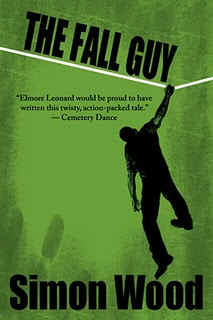
Wood's
book, The Fall Guy, is the best example. It's about a down on his
luck guy who is late for work one morning. He hits a Porsche, cracking
its tail light, and there are witnesses. So, he writes a note to put on
the windshield, saying, everybody thinks I'm leaving the address, but
I'm not.
There
a repercussions. The Porsche belonged to a drug dealer, who was puled
over because of the broken tail light. The police found the drugs, and
confiscated them, arresting the driver. But, the big boss tracks the man
down, and tells him, you cost me drugs, a car, and a driver, you owe me.
And, he's inducted into the drug world. Things tend to come back and
bite you.

Wood's
novel, Terminated, deals with workplace violence. Twenty people a
week are murdered at work. Retail is the most dangerous work environment
for women. The safest work environment? Coal mines. There's only one
murder a year. The working conditions might not be good, but no one
murders you. In Terminated, a man's annual review doesn't go as
expected. Someone on edge can take it personally. Simon's favorite story
of workplace violence is about a man who tried to kill a female coworker
by putting mercury in her heating system to try to poison her. He's been
trying other ways for a while, but they caught this one. The reason he
went over the edge? She didn't like his deviled eggs once at a company
picnic.
Wood
likes the Hitchcock big story. He likes stories of the human condition,
when people are tempted, teased.
 All
of Simon Wood's books have been standalones until now. Did Not Finish
is the first in a series. It's set in the racing world. Racing is
expensive, and people are willing to compromise. It's a competitive
world with rule-bending. Dick Francis took readers into the world of
horse racing. This series is an inside point of view of motor sports. All
of Simon Wood's books have been standalones until now. Did Not Finish
is the first in a series. It's set in the racing world. Racing is
expensive, and people are willing to compromise. It's a competitive
world with rule-bending. Dick Francis took readers into the world of
horse racing. This series is an inside point of view of motor sports.
Did
Not Finish is based on an actual incident. In 1972, there was a
tight championship. Two drivers were just two points apart, and whoever
was in front at the end of this race would win.
The
night before the race, there were drivers, teams and officials in the
club house. There was a rumor going around that the driver in second
place had said if the leader doesn't pull over and let him win, I'll
kill him. The public didn't know about it.
Qualifying
went okay. But, in the second lap, the two touched wheels; the guy
leading the championship hit the wall and was killed, in the same way
Dale Earnhardt died.
Wood
told us there are ways to make cars go off the track if you know how.
The driver can slip wheels. Anyone who has seen Ben Hur has seen
one driver slip his wheel inside the other driver's.
The
race was televised, but it wasn't a live feed. Everyone was quiet after
the race, thinking the threat had played out. So they expected TV on
Tuesday would expose it. But, the TV coverage was edited. They changed
the grid, didn't show the first two laps since the driver was killed in
the second lap. The third lap appeared to be the first one. And, the
driver's name didn't appear on the roster. Police wrapped up the case,
and the car disappeared. Everyone pretended nothing happened, and some
people were told to stop asking questions. The story just went away.
Here's
where it got personal. Wood had seen something wrong with the dead
driver's car in qualifying, and told him so it could be fixed. Then,
when they call the drivers to the cars, Simon always had to go to the
restroom. Other drivers were there, and then it was just Wood and the
guy who later died. Simon wished him good luck, and the guy responded,
that's OK, after this one, I'm telling my girlfriend I'm going to stop
driving, and we'll get married. It's my wedding gift to her. Wood never
told the guy's girlfriend that after the accident. But, he wanted to
tell that story.
The
story is somewhat changed in Did Not Finish. Some of the people
from that time are still around. Aidy Westlake, the protagonist, is the
third generation in motor sports. His grandmother was a mechanic. His
father was a driver who had just moved up to Formula One, but he and
Aidy's mother were killed in an accident on the way home from a race.
Aidy was raised by his grandfather, much like Heid, except for lots of
oil and grease. He's twenty-one years old at the grass roots
championship when a driver dies, and he wants to find out who the killer
is, and expose him.
Wood
intends to follow Aidy through his rise in racing. He'll take him to
different races around the world. One will be set in Europe, then Le
Mans. There's a lot of gambling corruption in sports, so he'll take him
to Vegas. One team had made ends meet by being drug mules. They crossed
numerous European borders before they were caught. If you can imagine it
in sports, it will happen. The people have to have money.
When
the audience asked questions, the first question was about humor in his
books, because Simon is funny. He said he might be lighthearted, but
he's way too into justice or digging out the truth. There's not much
humor in his fiction, although he writes humorous nonfiction.
Asked
where he gets his ideas, he answered that he cuts lots of things from
newspapers. He likes the odd cases, not the big ones. Wood lives in the
east bay area, across from San Francisco. There's a big case right now.
A Deputy Chief of a county task force on narcotics has been convicted of
selling drugs as part of a prostitution scheme. It was a private eye who
brought him down. It's like the Sopranos are working out of small
towns with populations of 30-50,000.
Once
confiscated drugs are no longer needed for a case, they're burned. But,
in that recent California case, the stuff was not destroyed. It was
moved into storage, and then the whole case was wrapped up in
prostitution. Wood likes this case. He likes stories from the back of
newspapers, not the front page.
He
was asked if he goes to trials, and he said he has gone to some. He went
to night court in New York because he wanted to see what kind of cases
go to court at 2 in the morning. He's been inside prisons. The
California Parole Board was interesting.
Simon
likes the unusual. "Body found in public storage." Why? People
can bid on public storage units when the rent is delinquent. A woman
paid $38 dollars for the contents of one, and when she unwrapped the
contents, she found a body.
Wood
likes the unusual, unexplained crimes. He's most inspired by news
stories. And, it's those kind of stories we'll continue to see in Simon
Wood's books.
Did
Not Finish by Simon Wood. Severn House. ©2011.
ISBN 9781780290072 (hardcover), 215p.
lholstine@yahoo.com
|
Kevin Hearne for
Authors @ The Teague
Story
and Most Photos by: Lesa Holstine Glendale Daily Planet Book
Topics Editor
Hosting an Authors @ The Teague program
with a fantasy author is different than hosting a mystery author.
Fantasy authors have SERIOUS fans, who read the books, can quote the
books, and can give the author the answers when the author can’t
remember what he wrote. I was all set to introduce the author of the
series about a Druid who is twenty-one centuries old, but his fans
knew about Atticus O'Sullivan. It was a treat to host Kevin Hearne,
the author of The Iron Druid Chronicles. This was his first appearance
for Authors @ The Teague, but, hopefully, it won’t be his last. Fans
of his first three books, Hounded, Hexed, and Hammered, showed up to
support him, ask questions, and chime in with comments. I’m sure
many will be back when his next book, Tricked, is released in April
2012.
And, I learned fantasy authors who are
terrific speakers take the ball in their own hands, and skip the
introduction. Kevin already had the crowd eating out of his hand
before the program would have officially began at 2 p.m. He was
telling the audience that Atticus O’Sullivan’s occult bookshop in
Tempe is actually located on Ash Avenue where his cousin’s comic
book shop is located. He likes reality in his urban fantasy. Someone
in the audience agreed, saying that’s why Jim Butcher’s Dresden
Files are so good. They have Chicago right.
Hearne told us he teaches high school
English in the east Valley. He teaches English Lit and American Lit,
which is why there are nerd English jokes in the books.
 Kevin
said the first three books came out so fast it was bewildering.
That’s how quickly books can come out in a series. Hounded was
accepted in 2009, but the publishers wanted two more books to be
published right away. Hearne had to write two more books in one year
to meet the schedule. But, the publishers (Del Rey) thought it was
better to get three books on the shelf immediately, so readers could
dive right in, and really get involved. There were seven months
between the books. The fourth book, Tricked, is due out in April.
Kevin has started the fifth, Trapped. That’s due in Dec. 2012. The
sixth book will be Hunted. Kevin
said the first three books came out so fast it was bewildering.
That’s how quickly books can come out in a series. Hounded was
accepted in 2009, but the publishers wanted two more books to be
published right away. Hearne had to write two more books in one year
to meet the schedule. But, the publishers (Del Rey) thought it was
better to get three books on the shelf immediately, so readers could
dive right in, and really get involved. There were seven months
between the books. The fourth book, Tricked, is due out in April.
Kevin has started the fifth, Trapped. That’s due in Dec. 2012. The
sixth book will be Hunted.
Asked if there will be more references
to music in future books, and does Atticus play an instrument, Kearne
answered that he does, but he's changed instruments in the course of
his history. He was a bard at one time, and played the harp. Now he
plays guitar. There's a lot that is backstory about Atticus that Kevin
knows, but it's not in the story yet.
There's a great deal in Atticus'
backstory. He's been working on him for so long. Kevin originally
plotted out a bunch of short stories, such as he raided the Library at
Alexandria. He met up with the Mayas in America. Hearne has had to
make a timeline so Atticus isn't in two places at one time.
Kearne discussed the Druids for a
little, saying the Romans and St. Patrick wiped them out. In Tricked,
he's going to address the fact that as the last surviving Druid,
Atticus was trained to tie the world together with oaks, so the Druids
can't be trapped again.
Asked how he researches his books,
Hearne said he starts with Wikipedia.
He commented using Wikipedia is like a nuclear arms treaty, “Trust,
but verify.” He starts there, but then checks the sources they use.
 In
Hexed, there were numerous languages used. Hearne was lucky in that he
had native speakers to consult from Poland and Germany. He had a
German exchange student a the school who told him how to say things.
And, he had a fellow from Germany who he corresponded with. He wanted
to know how to curse in German, but then it wasn’t used. In
Hexed, there were numerous languages used. Hearne was lucky in that he
had native speakers to consult from Poland and Germany. He had a
German exchange student a the school who told him how to say things.
And, he had a fellow from Germany who he corresponded with. He wanted
to know how to curse in German, but then it wasn’t used.
When Hearne starts research, he begins
with the easily accessible, and then digs in. The Fenian and Ulster
cycles of Irish mythology are online via a University of Dublin
translation. He says he has to be accurate, or he’ll hear about it.
He admitted he pokes fun of what he
teaches. He has fun with literary jokes about Edith Wharton and
Charles Dickens in his books.
Asked why he picked Celtic mythology,
Hearne answered that he’s partially Irish himself. And, there
wasn’t a lot out there except the same stories. The Morrigan and the
Wild Hunt are used, and not much else. And, the Wild Hunt isn’t used
much in the Irish Celtic mythology. He’ll be back with more
Celtic mythology in the fifth book, Trapped, when Atticus deals with
more of the gods.
Hearne was asked if he received any
flak about his use of Christian figures. He did receive one star on
Amazon from one person who objected to it. But, he feels no one can
actually attack him on his portrayal of Jesus. Jesus is just in a
different form than usually pictured, but it's not a disrespectful
portrayal. In fact, Atticus is the ultimate religious minority because
he's the last Druid. And, Hearne wrote the books first to entertain
himself. Religious tolerance is going to be a theme through the
series.
 Atticus
wears an Iron necklace he uses for protection. Hearne was asked where
the inspiration for that came from. He said he built it backwards. He
wanted to write a book about a man and his dog, and he wanted them to
communicate telepathically. How much easier would it be if you could
tell your dog what to do mentally? So, he created Atticus and Oberon.
His research indicated a Druid might be the type of magical being who
could form a bond with an animal. And, he found out that Fragarach was
the sword given to Conn of the Hundred Battles, but it was never
returned. So, he created a story about what happened to Fragarach and
how Atticus got it. And, he's been fleeing from Aenghus Óg because
the god wanted the sword. So, he had to come up with a way for Atticus
to have dodged him for 1000 years. Some gods helped him. Atticus
wears an Iron necklace he uses for protection. Hearne was asked where
the inspiration for that came from. He said he built it backwards. He
wanted to write a book about a man and his dog, and he wanted them to
communicate telepathically. How much easier would it be if you could
tell your dog what to do mentally? So, he created Atticus and Oberon.
His research indicated a Druid might be the type of magical being who
could form a bond with an animal. And, he found out that Fragarach was
the sword given to Conn of the Hundred Battles, but it was never
returned. So, he created a story about what happened to Fragarach and
how Atticus got it. And, he's been fleeing from Aenghus Óg because
the god wanted the sword. So, he had to come up with a way for Atticus
to have dodged him for 1000 years. Some gods helped him.
Then Kevin realized that iron
elementals eat faeries. Iron is the opposite of magic. He decided to
bind iron to Atticus' aura as his magical protection. Now, the story
of iron defeating magic goes back to the Milesians arriving in
Ireland, bringing iron, and defeating the Bronze Age society there.
Atticus is immune to magic because of his iron necklace.
Hearne was asked how he makes himself
writing deadlines, as an author with a day job. He said now he has to
make himself write, because he does have deadlines. It took him eleven
months to write Hounded, his first book in the series. But once he got
the book deal and a deadline, he had to get motivated. He started
Hexed at the end of summer, August 2009. He finished it New Year's
Eve. That one, written in the shortest period of time, has received
the best reviews so far. Hammered took longer. He had to skip around.
Kevin outlines chapters, and then ignores them.
Someone mentioned the group, The
Hammers of God, that appear in Hexed. Kevin said they started as a
joke, "A rabbi and a priest walk into an occult bookshop. .
." And, they became a good subplot.
He did say he writes 500 words a day.
Other authors tweet, "I wrote 2000 words today!" Hearne's
audience told him they don't have day jobs. But, Kevin said if he
writes 500 words, he can write a 90,000 word novel in six months. And,
it's helpful to have an outline.
Going back to The Hammers of God,
someone asked, "What's up with the beards?" He said,
"Have you seen Patrick Rothfuss' beard?" Rothfuss is one of
Hearne's favorite authors, the author of The Name of the Wind. He said
some beards just demand care and feeding. He found it fascinating.
Hearne told us Hounded was originally
going to be a comic, but then he decided to make it a book. It does have
some vampires and werewolves, but they're only in there as background,
to make fun of them. There's no romance. And, he thought not many urban
fantasies have male protagonists, other than Jim Butcher's books.
Since Oberon is an Irish Wolfhound, Kevin was asked about his dogs. He
has a Boston Terrier named Sophie, and a Pug, Manley. He lives in a
little house, and has no room for a Wolfhound, although he'd love to
have one.
Asked about media interest in his books, he said the production company
that did Ella Enchanted is interested in them for either TV or movie
production. They're very good an name dropping, telling him who read the
books. They said Peter Jackson read it. For a short time, he knew he was
on Peter Jackson's mind. Then they said Will Smith was reading it. Will
Smith? But, nothing's happening right now. It's just talk.
Asked if his students knew about his books, he said most of them have no
clue, and he doesn't advertise it. A few of them know. But Kevin teaches
in a conservative community. Half the school goes across to the street
to a seminary for one class a day. And, Atticus is an adult who uses
adult language and has a sex life. So, he doesn't push his books at
school.
Since Atticus hangs out at Rúla Búla,
an actual Irish pub in Tempe, Kevin was asked about whiskey. He said,
"Red Breast, an Irish whiskey." Rúla Búla was the first
bar west of the Mississippi to carry it.
Speaking of Rúla Búla, the
release party of Tricked is going to be there on April 28. It's going
to be on the patio from 3-6, and they're going to give away
commemorative pint glasses with Atticus and Oberon on them. The public
will be allowed in at 6. There's going to be Irish music played by a
two man band. No bagpipes. Hearne will be selling tickets on his
website, www.kevinhearne.com.
There will only be 100 tickets. When someone asked what would happen
if they couldn't get tickets, he responded. "I'm Irish, in a bar.
Where am I going?" The books will be sold even after the ticketed
event is over that night.
Hearne never wanted to be a writer
until he read Ken Kesey's One Flew Over the Cuckoo's Nest in college.
He wanted to be able to write and move people like that. But, his
writing isn't as deep. It's fun. But, he started writing after that.
He never took a writing course. He said he never even talked to any of
his professors about writing. Instead, he wrote the first forty pages
of ten books. That took him ten years.
It took him six years to finish one
book, The Road to Cibola. That was about a mess of stuff. There was
the Russian mob, and Aztec treasure on a Hopi reservation. But, he
learned he could finish a book. Finishing is the first big step. Many
people think they can write a book, but they give up, and never
finish. He considers that his practice novel. He'll never publish it,
but he loves it for what it taught him.
He learned balance. To write a series,
you have to consider the market. Kevin writes for himself, but he
considers the market. He wrote an epic fantasy, 200,000 words. He
finally went to a writing conference, and was told that's just too big
for a first novel. Now, people can join online writing communities,
but he didn't know that. He chopped that novel to 114,000 words, and
sent it to agents. It was rejected by all of them, so he decided to go
the direct route, and send it to publishers. Two weeks later, he
received a response from one saying he'd passed the first round. But,
he didn't hear anything again for a year.
However, Hearne was so encouraged that
he started Hounded to keep him busy while he was waiting to hear from
the publisher. He sent Hounded to twelve agents. You're lucky if the
response is that they want to see a partial or full manuscript. It was
rejected by all of them. So he made further adjustments. And, he sent
the query letters to twelve more agents. One asked for a full
manuscript. Then, he said he'd work with him.
At the time, Kevin thought there was no
one else writing about Druids. It turns out, there was one other
author, Mark Del Franco, but his Druid is nothing like Atticus. Hearne
hoped a Druid would stand out from all the books about werewolves and
vampires.
Kevin let us in on a secret. His agent
asked him to make a change. When the witch, Emily, comes into the
store asking for a potion, the original potion was to cause an
abortion. But, the agent wanted him to get rid of that potion. Hearne
had intended to show that Atticus provides services for women because,
as a Druid, he doesn't have the same feelings modern society has.
However, the change was to a potion to humble a man, and the scene was
funnier with that.
Hounded was sent out on Sept. 9. Two
weeks later, he had a deal. It went to auction with four publishers.
Kevin told the audience you definitely want an agent.
He chose Del Rey as his publisher.They
have option clauses for his next three books, which they've picked up.
And, they have an option on his epic fantasy, if he ever finishes it.
He has to show it to them first, and they have the right to first
rejection.
How did he come up with Atticus'
powers, such as his ability to shape-shift? Hearne said the stories of
the Druids agree on some of the powers they were supposed to have.
They had the power to change into animals. You have to remember,
anything written about the Druids was written by their enemies. They
only had an oral culture. Shape-shifting, teleporting, and some
ability to control weather were agreed upon traits. And, they had an
affinity with animals.
Kevin Hearne's answer to the final
question was perfect, before the crowd lined up for autographed books.
He was asked why he set the books in Tempe. Kevin grew up in
Scottsdale, and spent lots of time on Mill Avenue. You can run across
anyone on Mill Avenue. It's not segregated, like many cities in the
Valley. There would be a nerd, like Kevin, next to a yuppie, next to a
gang member. You might even run into gods there.
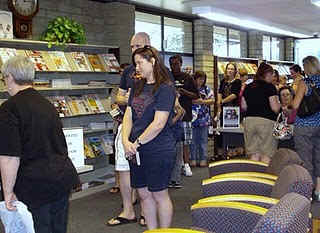 |
| Lined
up for autographs |
 |
Lesa
Holstine and Kevin Hearne
Photo by: Anna Caggiano |
lholstine@yahoo.com
book blog: http://lesasbookcritiques.blogspot.com
Twitter @LesaHolstine
|
Denise
Hamilton for Authors @ The Teague
Story
and Photos by: Lesa Holstine Glendale Daily Planet Book
Topics Editor
When
Denise Hamilton appeared at the Velma Teague Library for Authors @ The
Teague, I introduced her as a lover of libraries and books. She said
one reason she loves libraries is because she’s married to a
librarian. And, she has two sons who are readers. They call her oldest
son the “Book Anaconda” because he reads a book a night, more on
the weekend. At the price of a YA book, that’s $18 a night, so she
can’t afford all the books he goes through. She loves libraries, and
donates books to them, and makes appearances at libraries. This time,
she came to promote her latest book, Damage Control. It received a
starred review in Library Journal, and is already in its second
printing.
Denise
began by giving a little personal background. She’s an LA native,
married to an LA native, but they spoke different languages at home.
Her mother was French while his parents were from Mexico. Hamilton
worked for ten years as a journalist for the LA Times.
Although
she always loved words as a child, she didn’t think she could make a
living writing. So, she majored in business. Then, she found herself
working with numbers when she wanted to work with words. She felt old
and washed-out at 24. Fortunately, she had a boyfriend who was
studying journalism, and he’d discuss his assignments. She thought
they sounded interesting, so she decided to take an extension course
at UCLA. Then she went back to get her Master’s in journalism. The
woman who ran the program was married to the suburban editor for the
LA Times. When she had a promising student, she’d say, “Bob, give
this student an internship.” And, he did, which is how Hamilton
started work with the LA Times.
Hamilton
would submit articles, and when they were edited, she’d say, that
turned out much better. She learned quite a lot on the job. And,
she’d watch the big reporters argue with the editors. They liked her
because she never argued. She was young and pliable. She’d cover any
story. She was just happy to be there as a summer intern.
When
the summer was up, they asked if she could stay a few more months
while someone went on maternity leave. Then, when an opening came up,
they asked her to hang around until they hired someone, but don’t
apply for it because you don’t have enough experience. Two years
went by before she was hired permanently. Then, she was sent to
Ventura, a beachy suburb where nothing happens. She was bored, and
decided to apply for a fellowship in Eastern Europe. It was just
before the fall of Communism, although no one knew that when she left
for Budapest, Hungary for six months. Hamilton ended up staying six
months while Communist governments all around were collapsing. She
wrote lots of articles for the LA Times, covering Czechoslovakia,
Hungary, and other countries.
When
Denise returned to California, they told her, we have this great
bureau in a mini-mall in San Gabriel Valley. She debated as to whether
she should leave and go to Russia, because she spoke some Russian, but
ended up going to the San Gabriel Valley. She covered lots of
immigrant Chinese stories. For the first time, large numbers of
Chinese were not settling in Chinaton, but moving to the suburbs.
Monterey Park became the first majority Asian suburb. She covered
stories about the community; organized crime, schooling. She pretended
China came to her.
 It
was while covering the Chinese community that Hamilton found the
background for her first Eve Diamond mystery, The Jasmine Trade. She
learned that Chinese families come to the U.S., buy houses, enroll
their they go back to China, and the kids live by themselves,
sometimes with an older sister or their mother, sometimes a nanny,
sometimes just by themselves.This came to light when a boy was
kidnapped, and held for $1 million ransom. Instead of paying, his
father in Taiwan went to Interpol, and the boy was found and returned.
Hamilton's editor thought she made up the story. It
was while covering the Chinese community that Hamilton found the
background for her first Eve Diamond mystery, The Jasmine Trade. She
learned that Chinese families come to the U.S., buy houses, enroll
their they go back to China, and the kids live by themselves,
sometimes with an older sister or their mother, sometimes a nanny,
sometimes just by themselves.This came to light when a boy was
kidnapped, and held for $1 million ransom. Instead of paying, his
father in Taiwan went to Interpol, and the boy was found and returned.
Hamilton's editor thought she made up the story.
Hamilton
admitted some reporters do make things up. But, she's always thought
there are plenty of bizarre stories out there, so there's no need to
make them up. She said she felt like a PI, tracking down stories. She
felt like Raymond Chandler's Philip Marlowe, only "Philippa
Marlowe," tracking down stories. People will talk to reporters
when they won't talk to cops. She felt glamorous and gritty. It felt
like she was starring in her own movie.
After
ten years as a reporter, Denise felt constrained. It was always,
"Who, what, where and how." Sometimes, the stories were
eliminated or the best part was cut by the editor. Or, there were
amazing stories she just couldn't cover. She had thousands of stories
that didn't fit in the paper.
Denise
joined a writing group, nine ladies who met on Sunday night. They all
read from their latest work, and then they'd critique it. Hamilton
decided to write about a female reporter at the LA Times, working in a
multicultural city. She wrote about the Chinese "parachute
kids." They were called that because the whole family dropped in,
bought a house, and then left the teenage kids there." Dads were
often called "astronauts" because they were always on planes
back and forth. Her writing group always asked what happens next, and
she told them they'd have to wait until the next group. She'd go home
and write the next chapter. The Jasmine Trade was written as a series
of chapter installments over three years for her writing group.
Hamilton wrote it as a mystery with a fast pace. Mysteries have the
same pace as newspaper journalism. She focused on moving the action
forward.
Hamilton
called LA a noir and surreal place. Seventy years after Raymond
Chandler, it's still a glamorous city, even with the grit and crime.
LA is like a bad boyfriend. Denise tries to break up, but it keeps
drawing her back. LA is her muse, the ultimate femme fatale. She's
still documenting her corner of LA, trying to make sense of it.
 Denise
wrote five books in the Eve Diamond series. Then she was called by a
publisher asked her to edit a short story collection, Los Angeles
Noir. They wanted the stories set in different neighborhoods with
seventeen different authors, including Hamilton. She knew she wanted
Michael Connelly, the dean of LA crime stories. The first volume had
seventeen contemporary crime and short stories about LA. Susan
Straight, a literary writer, even won the Edgar Allan Poe award for
her contribution. Denise
wrote five books in the Eve Diamond series. Then she was called by a
publisher asked her to edit a short story collection, Los Angeles
Noir. They wanted the stories set in different neighborhoods with
seventeen different authors, including Hamilton. She knew she wanted
Michael Connelly, the dean of LA crime stories. The first volume had
seventeen contemporary crime and short stories about LA. Susan
Straight, a literary writer, even won the Edgar Allan Poe award for
her contribution.
 The
second volume was a reprint of classic stories, including ones by F.
Scott Fitzgerald and Raymond Chandler. It covers the '20s and '30s to
the '90s. Hollywood always lured big authors, and they wrote stories
about it. But, Hamilton needed stories about other neighborhoods, not
just Hollywood. She poured over books, and found a woman pulp
writer, Leigh Brackett. No one knew she was a woman. Howard Hawks
wanted "him" to write the screenplay for "The Big
Sleep." Brackett floored everyone when she showed up. She did
co-write it, and got a screen credit. She went on to write more novels
and short stories. And, she finished her career by co-writing the
screenplay for "The Empire Strikes Back." George Lucas was a
big fan of her science fiction. The
second volume was a reprint of classic stories, including ones by F.
Scott Fitzgerald and Raymond Chandler. It covers the '20s and '30s to
the '90s. Hollywood always lured big authors, and they wrote stories
about it. But, Hamilton needed stories about other neighborhoods, not
just Hollywood. She poured over books, and found a woman pulp
writer, Leigh Brackett. No one knew she was a woman. Howard Hawks
wanted "him" to write the screenplay for "The Big
Sleep." Brackett floored everyone when she showed up. She did
co-write it, and got a screen credit. She went on to write more novels
and short stories. And, she finished her career by co-writing the
screenplay for "The Empire Strikes Back." George Lucas was a
big fan of her science fiction.
When
Hamilton was writing her latest book, Damage Control, the John Edwards
scandal was in the news because of his affair and his love child. For
a while, his campaign said his aide fathered the child. It was a media
political scandal. Denise wondered how far someone would go if they
could silence someone to keep the scandal from coming out. What if
someone on staff could "get rid of the problem?"
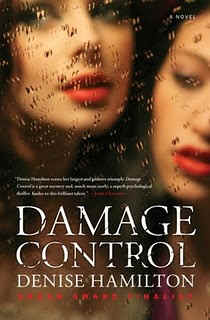 Damage
Control involves a politician whose new social media expert is found
murdered. He didn't kill her, but he was the last one seen with her.
They had a meeting to discuss Twitter, and then he drove her to her
apartment. He was the last one to see her. He hires a PR firm, the top
damage control firm in LA, not because he did it, but because he needs
guidance so he doesn't say the wrong thing. Damage
Control involves a politician whose new social media expert is found
murdered. He didn't kill her, but he was the last one seen with her.
They had a meeting to discuss Twitter, and then he drove her to her
apartment. He was the last one to see her. He hires a PR firm, the top
damage control firm in LA, not because he did it, but because he needs
guidance so he doesn't say the wrong thing.
Hamilton's
protagonist is a young woman who grew up in LA. She's divorced, in her
30s. Her mother is a cancer survivor who moved in with her while going
through treatment. Now, Maggie Silver would like her mom to get her
own place. But, her mother is content there, and she likes to set
Maggie up with dates, which drives Maggie nuts. Maggie's under a great
deal of pressure, trying to make it. She's afraid she would lose her
house if she loses her job.
Maggie
is in Malibu, counseling a movie star who was accused of sexual
harassment by the au pair. She stole jewelry from his wife, and when
she's accused of it, she accuses him of sexual harassment. While
working on this job, Maggie is called back to the office for a
bigger crisis.
When
Maggie sees the politician in the office, she realizes she knows
him. He's the father of her childhood friend, Anabelle. She almost
lived at their house for two years in school. She and Anabelle
bonded. Maggie idealized their family. They had a huge house, art,
classical music. She was beguiled by them. But at sixteen, something
bad happened at a beach party. They haven't spoken for fifteen
years. Maggie is assigned to represent Anabelle's dad.
Hamilton
said she wrote Damage Control as a political sex thriller. It's also
about the dark side of beach culture, what she calls surf noir. She
loved the beach and parties, but there was a dark side, too. There
is the cult of body, drugs, and drinking. Twenty or thirty years
after their teens, some people are still on the beach. Crime fiction
sees the dark side. Hamilton sees the shadow and light.
Denise
also wanted to write about the intense emotional friendships between
teenage girls. They share clothes, talk about boys, party together.
It's all important, raw and intense. In the course of the book,
readers learn the backstory for Maggie and Anabelle. Denise told us
she found it intense being in the heads of teenage girls. Everything
is embarrassing to teens. Hamilton has two teenage boys, and the
oldest wants her to drop him off down the street.
Hamilton
summarized herself as someone who takes care of her kids, writes
crime fiction, and takes her dogs for walks.
Asked
what she was working on, she said she's working on three things
right now. She's writing another Eve Diamond, and two more
standalones. She has a draft of a YA urban fantasy set in LA.
There's crime in the urban fantasy, too. She doesn't have a problem
with lack of ideas. She has so many ideas. She works with her
publisher, Scribner, to narrow it down. They say, "We think you
should be doing this." Denise said the best job in the world is
to sit around and tell lies, stories.
One
question mentioned Sue Grafton's Kinsey Millhone and Janet
Evanovich's Stephanie Plum. Is Denise aging Eve Diamond? She said,
not really. She's around thirty. But, Hamilton is going to have to
deal with the reality of the newspaper business. If she's writing in
the present, she has to reference things that are happening. And,
her boyfriends change, but she stays around thirty.
As
an author, how does she feel about ebooks? She answered that it's
great people are readings. But, she likes to read a book, the
artifact. She just read Mark Twain's short story, "The
Celebrated Jumping Frog of Calaveras County," to her
thirteen-year-old son, and it was hard to read on her cell phone.
Hamilton says the publishing industry is going through the same
revolution as music did ten to fifteen years ago. But, there's
always room for storytellers in whatever form.
The
last question had to do with her experiences in Europe. She said
publishers don't want the stories set there. They want them in LA.
But, she would tell one story about her adventures. She was a
Fulbright scholar in Yugoslavia during the Bosnian War. She was in
Macedonia, where it was calm and quiet. She could walk home at 2
a.m. The Balkan cafe culture mentality was alive.
At
a conference of journalists in Yugoslavia, she met an Albanian
journalist. She had never met an Albanian before because they were
shut off from the rest of the world. For forty years, no one had
been allowed in or out. She asked questions, and was invited back
with them, traveling in their van with an Albanian-American guide.
As they traveled the mountains, they could look down and see the
carcasses of other trucks and buses that had fallen off the road.
They dropped her off at the US Information Office, and they put her
in touch with some Fulbright scholars. She crashed with them for
three to four days, but needed to get back to Macedonia. There were
no flights and no trains. There were private buses. She originally
had the chance to go back with a man who had a private car, but he
told her he couldn't take her. She ended up on the private bus. But,
she was told later she was lucky that she hadn't ridden with the man
in the car because he was the biggest heroin dealer in the area.
And,
we were lucky she didn't end up riding with him, and ended up in
Glendale, Arizona, discussing her books, including Damage Control.
Denise Hamilton's
website is www.denisehamilton.com
Damage Control by
Denise Hamilton. Scribner. ©2011. ISBN 9780743296748 (hardcover), 384p.
lholstine@yahoo.com
book blog: http://lesasbookcritiques.blogspot.com
Twitter @LesaHolstine
"Remember, books have no calories, they last longer than a latte
and you can
enjoy them again and again. The police won't stop you if you go on a
book
bender." - Elaine Viets
|
| Interview
with Denise Hamilton
She will
appear at Velma Teague Branch Library in downtown Glendale AZ on
Wed., Sept. 14 at 2 p.m - Be
There!

Interview by: Lesa Holstine Glendale Daily Planet Book
Topics Editor
 I've
read Denise Hamilton's Eve Diamond books since the series started, so I
jumped at the chance to host her for Authors @ The Teague Wednesday, Sept.
14 at 2 p.m. She's on tour for her latest standalone, Damage Control.
It was a little intimidating, though, to agree to interview a journalist. I've
read Denise Hamilton's Eve Diamond books since the series started, so I
jumped at the chance to host her for Authors @ The Teague Wednesday, Sept.
14 at 2 p.m. She's on tour for her latest standalone, Damage Control.
It was a little intimidating, though, to agree to interview a journalist.
Lesa - Thank you, Denise, for taking time to answer some questions.
I know your first crime novel came out in 2001, however I'd still like you
to introduce yourself to my readers, please. Tell us about yourself.
Denise - Hi Lesa, and thanks so much for
inviting me to chat on your blog and also to visit your library.
I'm a Los Angeles native who worked as a reporter before having kids and
becoming a crime fiction writer. I've got two teenaged boys, two fat
sassy cats, a rascally huskie/lab mix dog with spooky blue eyes and a
husband who is a .... librarian. We are a very bookie household, there
are books in every room because we're all avid readers and collectors.
I’ve always loved reading and writing. As a kid, I made up stories, I
was almost obsessive about writing. As for reading…I'd ride my bike to
the library twice a week. I was that weird dorky kid who read every book
in the elementary school library and was always huddled at the picnic
tables, engrossed in a book while everyone else was playing. I'm lucky I
stumbled into journalism, a profession where I got paid to be nosy and
ask a jillion questions then write a story about it. But after 10 years
at the L.A. Times, I started feeling constrained by the
limitations of daily journalism. I wanted to crawl inside the heads of
all the tragic and wonderful and villainous and fascinating people I met
and imagine life through their eyes. I wanted to tweak their quotes to
make them even better. I wanted to cover murder stories where the bad
guy was arrested and tried and found guilty, and we all knew whodunit.
Unfortunately, in real life, something like only
half the homicides are ever solved. So writing crime fiction was
therapeutic for me, because by end we knew who did it and the bad guy
was lead away in handcuffs or got killed, and that helped me order my
world and make it feel like it was a safer place. Because the crime that
seemed so random and senseless in the first chapter turned out to have
motive and suspects and secrets and an entire backstory.
By the way, let me just say that I don't know why
any reporter would ever make up a story. Real life is just too strange
and bizarre and unpredictable and surreal. I also found that being a
reporter is a little bit like being a private eye. You have to pound
that shoe leather out in the street and chase down clues and convince
people to talk to you and the piece the information together. Especially
in a gigantic, Pacific Rim megalopolis like Los Angeles, any crazy thing
you can imagine in fiction is already happening somewhere out there. You
just have to go find it.
Lesa - I didn't know any of that
background, Denise. I'm looking forward to meeting a fellow book nut,
especially one married to a librarian. But, now I want to talk about
your latest novel. I won't say your latest book, Damage Control,
is "ripped from the headlines" because your story goes so much
deeper. Would you tell us about Damage Control?
Denise - Thanks for saying that!
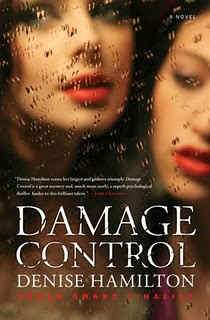 Damage
Control is a political thriller about a female PR executive who
finds herself representing a U.S. Senator whose beautiful young aide has
been found strangled. It deals with celebrity culture, surf noir, and
the powerful bonds between two high school girls whose friendship is
destroyed when something awful happens on a beach one night. Fifteen
years later, my protagonist walks into the high-rise conference room at
her firm to meet her new client the Senator and realizes he's the father
of her long-lost friend. And then the plot thickens. Damage
Control is a political thriller about a female PR executive who
finds herself representing a U.S. Senator whose beautiful young aide has
been found strangled. It deals with celebrity culture, surf noir, and
the powerful bonds between two high school girls whose friendship is
destroyed when something awful happens on a beach one night. Fifteen
years later, my protagonist walks into the high-rise conference room at
her firm to meet her new client the Senator and realizes he's the father
of her long-lost friend. And then the plot thickens.
Lesa - Your protagonist, Maggie
Silver, is in an unusual profession, but perfect for this story. Tell us
a little about creating Maggie.
Denise - Yes, Maggie is a crisis consultant. She does
high-profile PR for celebrities, athletes, politicians, bond traders and
the like. Maggie's divorced, she's ambitious, she's got an upside-down
mortgage on a bungalow in an older, hilly part of Los Angeles and she
lives with her mother, who's just been through cancer and is now living
with her. The stakes are high because Maggie needs this job or she'll
lose her house. But she’s in her 30s and single and doesn’t really
want her mom for a roommate, especially since she’s bossy and a bit
self-destructive and keeps trying to fix Maggie up. So there’s some
conflict at home. And strange things are happening at work. Is her firm
above board, or are they involved in criminal activities on behalf of
their clients. Who can Maggie trust? Maggie also has to figure out if
her old friend's father - now a Senator - is telling the truth about the
dead girl. Along the way, she will reconnect with her old friend
Annabelle, face down her darkest fears and learn a lot about herself.
Lesa - You wrote five books in the Eve
Diamond series before switching to standalones. Why did you switch?
Which do you prefer? Do you have plans to bring Eve back sometime?
Denise - I like it all. The problem for me is never coming up
with ideas, it's figuring out which idea to write next. After the fifth
Eve Diamond novel, Scribner and I decided it was time for a standalone
and so I wrote a 1947 Hollywood novel called The Last Embrace
inspired by the real-life murder of starlet Jeanne Spangler. That was so
much fun to research!! Around that time another publisher, Akashic
Books, asked me to edit two volumes of Los Angeles Noir, which are short
story anthologies of noir fiction in which each story is set in a
different L.A. neighborhood. I’m a bit of a perfectionist – for
almost a year, short stories with a crime set in L.A. from the 1920s to
the present were my bedside reading. I must have read 100 collections!
So that took way more time than I’d imagined. Then I presented
Scribner with the idea of Damage Control and they said to go for
it. I would love to go back to Eve, but I also have several other ideas
that are calling my name, and they clamor loudly. So we’ll just have
to see.
Lesa - You are
a journalist, required to write facts. What do you enjoy about writing
crime fiction?
Denise - Ah, that's exactly what I enjoy about crime fiction -
not sticking to the facts. It's glorious to make stuff up. In my first
couple of books, I used characters inspired by real life people I'd
interviewed. One was a Chinese immigrant father and I remember flipping
madly through old reporter notepads, looking for the interview to find
his quotes, because he’d spoken with such poignancy. But I couldn't
find it. And I was devastated. Then, sitting amidst this stack of
notebooks, the light bulb suddenly went off. And I realized I didn't
have to quote him verbatim. It didn't matter what the guy had said. I
could put words in his mouth now. I could even make the quote better!
And that was a huge revelation. But it’s true. And in general, you
can't take a newspaper story and dump it between covers to make a book.
You have to change things. Add characters. Create subplots. Red
herrings. Blind alleys. Sometimes you change the killer. Everything you
write has to be in the service of the plot, and developing the
characters, so everything changes. And that's OK. That's what makes it
fiction.
Lesa - Can you tell us anything about your next writing
project?
Denise - I've got several projects on tap, but I am not ready to
discuss them yet until I get the green light from my editor. I guess I'm
a little superstitious that way.
Lesa - I understand, Denise. Now, is there anything you'd like to
tell readers that I might have missed?
Denise - You've been very thorough!
Lesa - I have a final question I
always ask since I'm a librarian. Do you have a story to tell us about
libraries or librarians?
Denise - Besides being married to one, you mean? I guess I'm
lucky because I can ask my husband to do bits of research for me and
he's quite helpful. He also doesn't mind when I come home with stacks of
new books that we don't have room for! He’ll just tell me we need to
get another bookcase.
As for librarians in general, they were always these benign fairy
godmothers keeping an eye on me because I spent so much time inside
their kingdoms when I was a kid. I was way too shy to ask for
recommendations from them, but I always felt a silent encouragement. The
secret signal that passes between two strangers who share a passion for
books. For that reason, perhaps, I love librarians and speak at as many
as I can.
I also donate tons of books to the school
libraries near me because they are so strapped for funds. I'm a
big supporter of literacy in the schools and I’ve been known to stalk
kids at the school book fair (where I always volunteer) and recommend
individual books to them. The new Warriors cat book! The Artemis Fowl
graphic novel! The future dystopia plot of House of Stairs. Giant
robot spiders, you’ll love it! I’m that slightly wacky mom who is
always shoving books in the hands of her friends’ kids and saying what
a good read it is.
Thanks
again for the visit, Lesa. It’s been a pleasure.
Lesa
- Thank you, again, Denise. I'm looking forward to finally meeting you on
September 14.
*****
DENISE HAMILTON
BIOGRAPHY
Denise Hamilton’s
crime novels have been finalists for the Edgar, Anthony, Macavity and
Willa Cather awards. She also edited Los Angeles Noir and Los Angeles
Noir 2: The Classics, which spent two months on bestseller lists, won
the Edgar Award for “Best Short Story” and the Southern California
Independent Booksellers’ award for “Best Mystery of the Year.”
Denise’s new
novel, Damage Control, will be published by Scribner on September
6, 2011 and has already received a starred review in Publishers
Weekly (excellent), a rave advance from Kirkus (In a novel
that marries celebrity culture, surf noir and the bonds of friendship,
Hamilton is at the top of her game) and kudos from James Ellroy (A
superb psychological thriller).
Denise has five
books in the Eve Diamond series and her standalone book The Last
Embrace, set in 1949 Hollywood, was compared to Raymond Chandler.
Denise’s debut, The
Jasmine Trade, was a finalist for the prestigious Creasey Dagger
Award given by the UK Crime Writers Assn. Her books have been BookSense
76 picks, USA Today Summer Picks and “Best Books of the Year”
by the Los Angeles Times, the South Florida Sun-Sentinel
and the Toronto Globe & Mail.
Prior to writing
novels, Hamilton was a Los Angeles Times staff writer. Her
award-winning stories have also appeared in Wired, Cosmopolitan,
Der Spiegel and New Times. She covered the collapse of
Communism and was a Fulbright Scholar in Yugoslavia during the Bosnian
War. Hamilton lives in the Los Angeles suburbs with her husband and two
boys.
Denise Hamilton's
website is www.denisehamilton.com
Damage Control by Denise Hamilton. Simon
& Schuster. 2011. ISBN 9780743296748. 384p.
The Review!
Denise Hamilton will be appearing for
Authors @ The Teague on Wed. Sept. 14 at 2 p.m.
Damage
Control by Denise Hamilton
by: Lesa Holstine Glendale Daily Planet Book
Topics Editor
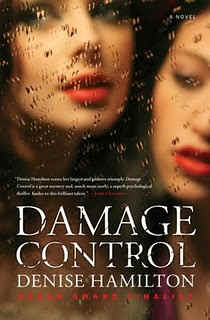 Denise
Hamilton takes readers into the world of the rich and powerful, a world
where celebrities can pay for media control, where ordinary people can
be used to cover-up the sins of the wealthy. It's the world of Damage
Control. Denise
Hamilton takes readers into the world of the rich and powerful, a world
where celebrities can pay for media control, where ordinary people can
be used to cover-up the sins of the wealthy. It's the world of Damage
Control.
Maggie Silver works in the world of crisis management. The Blair Company
is the top crisis management firm in L.A. At thirty-six, Maggie enjoys
the adrenaline rush, dealing with celebrities and their scandals, acting
as their spokesperson to the media. But, it's a job that takes a toll
physically, a twenty-four hour on-call job, and Maggie survives by
taking Adderall. It's the way the business works, and Maggie's boss
dishes pills out in company envelopes to the staff. She's going to need
those pills to stay on top of their latest story. Senator Henry Paxton's
young female aide has been murdered, and he and his family are in the
spotlight.
Maggie is handpicked to handle the Paxton case because of her background
as the teenage friend of Paxton's daughter, Anabelle. But only three
people, Maggie, Anabelle, and Anabelle's brother, Luke, know why Maggie
and Anabelle drifted apart after a tragic night of partying when they
were teens. Now Maggie is thrown back into that world, as one
catastrophe after another hits the Paxton family. She's caught up in a
world of lies and secrets, both at the Paxton house and at work, a place
where secrecy and cover-up is the name of the game. Maggie's bosses
count on her memories and connection to the Paxton household from her
teen years. But those years were the start of a downward path for so
many people. What is the high cost of survival in that world?
Denise Hamilton created Maggie Silver as a naive woman, still infatuated
with the life she knew as Anabelle's friend. She's the perfect pawn
caught in a dangerous game. And, it's hard to image what anyone would do
in Maggie's place, as she balances job security, the needs of a sick
mother, and the need for secrecy and lies. Damage Control is a story of
suspense. Who actually knew what happened to Senator Paxton's aide? Why
are lives spiralling out of control, as one event piles up on another?
And, more important, who can Maggie trust as she tries to maneuver the
dangerous path between friendship and cover-up? Damage Control is more
than a business. It becomes a matter of life and death for Maggie
Silver.
Denise Hamilton's website is www.denisehamilton.com
Damage Control by Denise Hamilton. Scribner. ©2011. ISBN 9780743296748
(hardcover), 384p.
|
| William Dietrich for
Authors @ The Teague

Story
by: Lesa Holstine Glendale Daily Planet Book
Topics Editor
 (photo by Lesa
Holstine)
(photo by Lesa
Holstine)
I introduced William Dietrich as a Pulitzer
Prize-winning journalist for his coverage of the Exxon
Valdez oil spill, but said he was at Velma Teague
to discuss his fiction, particularly his latest book, Blood
of the Reich. He's a New York Times
bestselling author, and his books have been published
in 31 languages.
He told the audience he grew up in the Pacific
Northwest, in the Tacoma area. He wrote all his life.
But, he needed to make a living, so he was a newspaper
reporter for 35-40 years, much of that for the Seattle
Times. In the 80s and 90s, he covered some
interesting stories, including the Exxon Valdez,
and the eruption of Mount St. Helens. Dietrich said
his claim to fame was his book, The Final Forest,
which was set in Forks, Washington. He wrote the
entire book with no vampires in it. (Stephanie Meyer's
Twilight books are set in Forks.)
 Dietrich
wrote nonfiction to make a living, books about the
Columbia River, plants. But, he had a hankering to do
fiction. He covered science for the Seattle Times,
and had been to Antarctica twice under the auspices of
the National Science Foundation. He wanted to write
about it. The Nazis had sent an expedition to
Antarctica before World War II. They wanted to claim a
piece of it for Germany. They hoped to get sperm whale
oil for fighter engines, because it was the best oil.
That was the kernel of Bill's first novel, Ice
Reich. It went from Alaska to Germany to
Antarctica. Dietrich
wrote nonfiction to make a living, books about the
Columbia River, plants. But, he had a hankering to do
fiction. He covered science for the Seattle Times,
and had been to Antarctica twice under the auspices of
the National Science Foundation. He wanted to write
about it. The Nazis had sent an expedition to
Antarctica before World War II. They wanted to claim a
piece of it for Germany. They hoped to get sperm whale
oil for fighter engines, because it was the best oil.
That was the kernel of Bill's first novel, Ice
Reich. It went from Alaska to Germany to
Antarctica.
William Dietrich writes both fiction and nonfiction.
He's written ten novels, what he calls historical
thrillers. They all have some grounding in history.
Two are set before World War II. There are four
Napoleonic books. One is set in the Australian
Outback. Bill said he is interested in geography and
science. He likes interesting settings such as Egypt
during the Napoleonic period. His next book, coming
out in June is set in the Caribbean. He said it's the
greatest scam in the U.S., to be able to travel, and
write it off on taxes. It's fun. He's curious about
science, history, geography. He likes to put something
in fiction that is based on history. He told us that
he reads boring things so you don't have to, and then
he puts the juicy parts in his novels.
Bill's first three novels were published by Warner;
then he switched to HarperCollins. Two books were set
in the late Roman Empire. Hadrian's Wall was
set in Scotland. The follow-up, The Scourge of God,
was about Attila the Hun. The main character in that
is based on a real-life person, a negotiator for the
Romans.
The Roman novels are a little serious. Dietrich
lightened up his next series, creating Ethan Gage, a
rogue, a wastral, a gambler, a sharpshooter, and a
womanizer. The books are set in the Napoleonic era. In
Napoleon's Pyramids, Gage's gambling wins him a
medallion that is part of the plot. He's caught up in
the Egyptian campaign of 1798 in which Napoleon
conquered Egypt. He also tried to conquer the Holy
Land, which few people seem to know. There are signs
in the Holy Land indicating Napoleon's route on that
campaign. This book, though, involves the mystery of
the Great Pyramid. Men found there way in, but there
was only an empty sarcophagus.
In The Rosetta Key, Ethan is embroiled in the
search for the Book of Thoth and the Rosetta
Stone. Part of the book is set in Jordan at the ruins
of Petra.
The Dakota Cipher finds Gage in trouble with
Napoleon's married sister, a bit of a rogue herself.
The mystery involves the Kensington runestone, a stone
that seems to indicate that the Norse were in the
middle of Minnesota over one hundred years before
Columbus came to the New World.
 |
| Photo
by Bette Sharpe, Glendale Daily Planet |
The most recent book in the
series, The Barbary Pirates, takes Ethan back
to the European theater, to the Mediterranean. This
story involves the legendary mirror of Archimedes, a
giant mirror that was supposed to have been able to
focus the sun's rays and set opposition ships on
fire. It was supposedly used against the Romans in
213 B.C. The story also incorporates the fact that
Robert Fulton built a working submarine for the
French in 1800. They decided it was impractical, and
that was the end of the submarine for decades, until
the American Civil War. But, in The Barbary
Pirates, Ethan enlists Robert Fulton and other
scientists to use the weapons against the Pasha of
Tripoli. Bill that this was a timely book, with
recent developments in the news with pirates and
this area. The next Ethan Gage book is due out June
1, 2012.
Dietrich's latest book, Blood of the Reich, is
the most complex in terms of structure. It takes place
in Tibet. In 1938, Tibet was the forbidden kingdom,
the home of the Dalai Lama, who was three years old at
that time. No one was able to get in, except for the
British, who bludgeoned their way in. Tibet was a
tremendous mystery in 1930. James Hilton used it in
his book, Lost Horizon, which came out a few
years before 1938. His book was based on the legend of
the lost kingdom of Shambhala.
In real life, the Nazis were intrigued by Tibet. There
were odd stories of that country, stories of strange
flying machines, and Tibetan holy men with strange
powers. One legend was of a secret energy source, Vril.
If the Germans could find it, and tap it, it would
give them a leg up.
As background, Dietrich used a nonfiction book called Himmler's
Crusade, about SS Nazis in Tibet in 1938. No one
is sure what they were doing there. Were they looking
for underground caverns? Were they looking for the
truth about the Aryan race? Goebbels sent a message to
the German newspapers saying this was a political and
military expedition, not a scientific one, and it was
not to be covered. When the Nazis returned, war broke
out, and no one ever found out what the expedition
actually was about.
So, William Dietrich wrote Blood of the Reich,
a fiction story, saying that expedition to Tibet was
critical to WWII, and critical to today. The story
begins in Berlin in 1938, with a meeting between
Himmler and the villain, Kurt Raeder. Raeder had been
on an expedition to Tibet, financed by American
explorer Benjamin Hood. Now, Himmler sends Raeder and
an expedition back to Tibet, to search for the truth
about the secrets there.
 Bill
told us Heinreich Himmler was the second most powerful
man in German. He was also a mystic, and a romantic.
He was a fan of King Arthur, and thought he himself
was the reincarnation of a medieval king. There seemed
to be a connection between Germany and Tibet because
the swastika was based on the Hindu and Buddhist
symbol of good luck. In Blood of the Reich, he
sends a research team of SS men to Tibet to test his
wacky theories. Bill
told us Heinreich Himmler was the second most powerful
man in German. He was also a mystic, and a romantic.
He was a fan of King Arthur, and thought he himself
was the reincarnation of a medieval king. There seemed
to be a connection between Germany and Tibet because
the swastika was based on the Hindu and Buddhist
symbol of good luck. In Blood of the Reich, he
sends a research team of SS men to Tibet to test his
wacky theories.
In the second chapter, Dietrich takes readers to
modern day Seattle, and introduces Rominy Pickett, who
is shopping at a grocery store when she notices a man
in the frozen foods who seems to be following her.
Rominy has her own wacky theories of what a future
partner should be buying in the store, not frozen
food. She prefers the wine section. But as the man
follows her, she begins to worry, and hurries out of
the grocery store. He tackles her in the parking lot,
just as her beloved Mini Cooper explodes. He says,
"I just saved your life." Jake Barrow, a
journalist with the Seattle Times, tells her a
story of her ancestor Benjamin Hood, and her own past,
including a story of an inheritance, and that she is
not really Rominy Pickett. There are connections to
the past, and now Neo-Nazis are hunting her. Rominy
and Jake unravel the mystery.
Back to 1938, when the Nazis are going to Shambhala.
The American government has dispatched Benjamin Hood
to Tibet, to learn what the Nazis are doing. He has
the help of a female biplane pilot, dispatched by
Madame Chiang Kai-Shek.
As a science reporter, Bill is fascinated by physics
and particle detectors. He incorporated that in the
book. If the Nazis are after Vril, he can imagine such
an energy that hasn't been detected yet. Physicists
say 96% of the universe is made of stuff we don't know
what it is. Physicists infer its presence because of
galaxies clumping together, and the way they are
flying apart. In real life, there is a Super Collider
in Switzerland in which scientists are searching for
the fundamental particles of the universe, the
"God particle."
Blood of the Reich has a lurid title, but it
has action, romance, and love triangles. Dietrich said
he was puzzled by the appeal of Nazi leadership. But,
many subcultures, including some fundamentalists, find
great comfort from identity with a group, and take
pride in being told they are special. The Nazis told
the German people that they're better than others.
They're the Master Race, the Aryan race. They appealed
to the German heritage and genealogy and told them
they were special. Bill said he plays around with the
people and relationships in the book. Who are they
really?
When Bill was asked how he dreams up this stuff, he
said it's hard to explain to his wife that he's hard
at work when he's lying on the couch staring at the
ceiling. He gets lots of his ideas from nonfiction.
He's also inspired by place. He loves research.
He sets Raeder's meeting with Himmler at Hinnler's
castle, Wewelsburg. Himmler modeled a lot of it on the
Vatican. He modeled the SS on the Jesuits with their
black clothing. He wanted to create his own
knighthood. There's an observatory there, and a crypt,
although it isn't clear who was to be buried in the
crypt. There's a sunwheel in the middle of the castle,
and there was to be a round table there, inspired by
King Arthur. The twelve chairs around it were designed
for the SS, and, after the war, they would rule the
world from there.
One man in the audience mentioned the war against the
Nazis in Italy, and wanted to know why there wasn't
much written about that. Dietrich answered that
authors have a problem. Publishers only want stories
about what people already know. He was at a conference
for historical fiction novelists when they discussed
that.
In answer to another question, he said he does do his
own research. He can't afford to hire someone to do
it, and he likes to control his research. James
Michener did have staff members do research. Some
authors, such as James Patterson and Clive Cussler,
are so successful they don't write their own novels.
Bill saw five people on a panel who were writing Clive
Cussler's books. Dietrich still writes his books the
old-fashioned way.
Fiction or non-fiction? He likes writing fiction
better because he can make things up. He has the
freedom to invent characters and make things up. He
can say anything he wants in fiction.
William Dietrich then closed out the program with the
book signing for Blood of the Reich.
William Dietrich's website is http://www.williamdietrich.com/
Blood of the Reich by William Dietrich. HarperCollins.
©2011. ISBN 9780061989186 (hardcover), 432p.
 |
| William
Dietrich and Lesa Holstine (photo by Bette
Sharpe, Glendale Daily Planet) |
lholstine@yahoo.com
book blog: http://lesasbookcritiques.blogspot.com
Twitter @LesaHolstine
"Remember, books have no calories, they last
longer than a latte and you can
enjoy them again and again. The police won't stop you
if you go on a book
bender." - Elaine Viets
|
| J.A. Jance at
the Foothills Library 7/16/2011

Story
and photo by: Lesa Holstine Glendale Daily Planet Book
Topics Editor
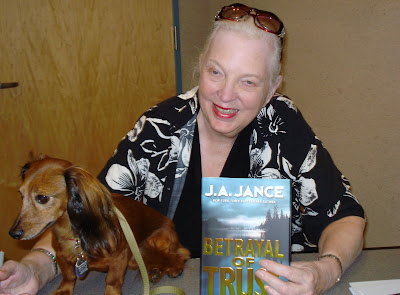
Arizona favorite, J.A. Jance, recently appeared at the Foothills Branch
Library in Glendale. The introduction for New York Times bestselling
mystery author J.A. Jance said she has 10 million books in print. Jance
said she thinks someone at her publishing house doesn't do math. Betrayal
of Trust is her 44th book, and there are 250,000 of each in print.
That comes to more than 10 million.
Jance wanted to be a writer since she was in second grade when she read The
Wizard of Oz. While other readers saw a wizard hiding behind a
curtain, she saw Frank Baum hiding behind the words.
As an adult she applied to be in the creative writing class at the
University of Arizona, but the professor said he wouldn't allow a woman in
the class. Her husband was allowed in the class that was closed to her. In
1968, he told her there would only be one writer in the family. He died of
chronic alcoholism at the age of 42, a year and a half after she divorced
him. He worked hard at that, and he was good at dying. He was right about
one thing, though. There was only one writer in the family. He never
published anything. Both Jance's ex-husband and the professor who wouldn't
allow her in the class were dead when J.A. Jance's first book was
published. And, her latest book, Betrayal of Trust, debuted at #9
on the New York Times bestseller list.
J.A. Jance introduced her dachshund, Bella, to the audience. She pointed
out that people had petted Bella for an hour while Jance signed books
before the program, and she was friendly and didn't bark. But, an hour
earlier they had been in the lobby at the Ritz-Carlton. A man reached down
to pet her, and she went straight up in the air, barked, and turned away
from him. Later the desk clerk told Jance and her husband that that man
had been hanging out, and was really weird. Jance said she wrote a short
shorty about a dog in Naples that started to bark at a couple. Bella is
cut from the same cloth. She knew something was wrong with that man.
Jance admitted she's always referred to small dogs as "Wastes of
fur." She's accustomed to big dogs, and she was not a dog person.
That was until October of the past year. At the time, she had a
thirteen-year-old Golden Retriever. She had been shopping with her
daughter, and her grandson, Cody, in Bellevue, Washington. They were
southbound when they saw a dachshund running northbound in the middle of
the road. If you've ever seen a dog running after a car that left her,
that's how desperately the dog was running. Jance's daughter got out, and
started flagging down oncoming traffic to stop it from hitting the dog.
And, Jance was out of the car, heading northbound with her grandson
hollering, "Animal Rescue! Go Gram!"
Jance chased the dachshund the better part of a mile, uphill. She was
fast, but short. Finally, two young men helped her herd the dog out of
traffic, and then one handed her the wet, little, sad dog. They went
straight to her daughter's vet, where she was wanded, and found not to
have a chip. Jance and her daughter even went door-to-door in the
neighborhood, thinking someone would recognize the dog. There was no luck.
Then, Jance called her husband, Bill, to tell him they had a stray dog
issue.
Jance didn't want to say any more to her husband. Many years ago, shortly
after Noah and the Great Flood, Bill had a date with the woman who became
his first wife. Those were the days when on a first date, the young man
went to the house to meet the parents. And, in the house was the family
dog, Moxie, a male dachshund. He took one look at Bill and thought, you
are evil and attacked Bill's Achilles tendon, drawing blood, and wrecking
Bill's socks and pants.
J.A. Jance went home and handed the dog to Bill. And, it certainly proved
there is love at first sight. He said, "Well, you're not going to the
pound." Colt kept talking about the dog as "Fella," and
Bill said that's a boy's name. This is Bella.
Jance and her husband always took their dogs to the same academy for
training. When they took Bella for her intake interview, they found out
she had bad breath because her teeth were rotten. She only weighed seven
pounds, and it probably hurt her to eat. She went through two weeks of
boot camp, and when they picked her up, they had removed fourteen chips,
and put in a chip. So Jance had a dachshund. Within two months, she was
flying first class from Seattle to Tucson. A true rags to riches story.
Bella is terrified of most men, including the man who takes care of
Jance's dogs, so they couldn't leave her at home. When Jance went on her
January book tour, Bella went with them. She spent five days during the
cold snap in January living at the Ritz-Carlton on Camelback. They decided
Belle must have lived somewhere with an elevator. Most dogs are afraid of
them, but she understands elevators. You face the wall; it opens; you get
in and turn around. Then the wall opens again, and you get off.
Jance told us it's hard to find restaurants to take puppies. So, they were
in the room enjoying room service when there was a knock on the door. The
concierage stood there with a sweater for Bella, since it was cold.
Three weeks ago, Jance and her husband went to New Orleans for a
convention. They thought they'd try leaving Bella at home. But, she
wouldn't do anything when she went outside. And, she left what they can't
call accidents. They call them deliberates. So, Bella is on this book
tour, too.
Jance turned Bella over to Bill, and then said, that was the preview of
the actual talk. Think of it as a trailer.
The first Detective Beaumont was published in 1985. J.A. Jance started it
in 1982. They've been together as author/character for thirty years, way
longer than she was with her first husband. Bill, her husband now, says
his life is perfect since her life with her first husband was so bad. With
Bill, it's happily ever after. But, she knew so much about her first
husband, that, from the point of view of a novelist, she has a gold mine
of material.
For six months, Jance tried to write that story from the wrong point of
view. In 1983, she sent her kids to camp, and she went to Portland to
visit a friend. She took her notebooks and pens on the train. She thought
she'd try to write through the detective's point of view. She started to
write, and after the first two sentences, she was at the crime scene,
seeing it through J.P. Beaumont's eyes. They've been like that ever since.
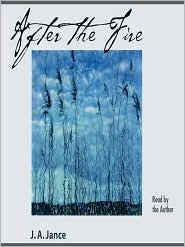 Jance
told us After the Fire is her autobiography, a book of poetry that
chronicles the years with her first husband. He died of chronic alcoholism
at 42. He was hospitalized nine times in six years. He came to a tee ball
game for one of their kids, and afterward, he was so sick he had to crawl
to the car. It was at that point, after eighteen years of loving him,
Jance realized she couldn't save him. She divorced him to save her and the
kids. Jance
told us After the Fire is her autobiography, a book of poetry that
chronicles the years with her first husband. He died of chronic alcoholism
at 42. He was hospitalized nine times in six years. He came to a tee ball
game for one of their kids, and afterward, he was so sick he had to crawl
to the car. It was at that point, after eighteen years of loving him,
Jance realized she couldn't save him. She divorced him to save her and the
kids.
In 1982, she was in Seattle, trying to write. She was a single parent with
two kids, working full-time for an insurance company. She wrote every
morning from four to seven because that was teh only time she had to
write. When she hears people say they want to be a writer, but it isn't
the perfect time, she knows they'll never write because writers write when
life is imperfect.
Beaumont is told from a man's point of view. While Jance was trying to
understand why her husband would rather be in a bar than home with her,
she would go to the bars and listen to the men talk. It was research. She
learned what made men tick.
They always say write what you know. Beau did the kind of drinking that
Jance lived with for years. Jance was in Portland at a B.Dalton's, signing
the fourth book, Taking the Fifth, when a woman came up to her. She
said, J.P. Beaumont drinks every day. It's interfering with his work. Does
he have a problem? She answered. "These are books." Jance said
the author is the last person to know, but alcoholism is a disease of
denial.
 In the
sixth book, Beaumont has his first blackout. He wakes up with splints on
his hands, and doesn't know how he got them. In the eighth book, he goes
into treatment. Now, J.A. Jance is in Glendale, Arizona in 2011, with Betrayal
of Trust, the twentieth book. Beaumont has been sober for twelve books
longer than he was drinking. Still there are people who say they liked him
better as a drunk. Jance worries about them. In the
sixth book, Beaumont has his first blackout. He wakes up with splints on
his hands, and doesn't know how he got them. In the eighth book, he goes
into treatment. Now, J.A. Jance is in Glendale, Arizona in 2011, with Betrayal
of Trust, the twentieth book. Beaumont has been sober for twelve books
longer than he was drinking. Still there are people who say they liked him
better as a drunk. Jance worries about them.
Years ago, Jance was at the Texas Book Festival, and she could see a young
guy waiting in line with a little girl in a stroller, and he was grinning
at her. When he finally got up to her, he said, "My name is
Rob." He was in Rosehill Junior High when he first encountered
Beaumont. He wanted to be a cop after he read the frist Beaumont. He went
into the service, and served as an MP. He became a raging alcoholic, but
he still wanted to be a police officer. He was hired, but knew he had to
get sober. So, the day he graduated from the police academy, he went into
treatment. He's now the police chief of that town. And, he introduced her
to his daughter, Morgan. He said, "My wife wouldn't let me name her
J.P." There are unintended consequences of books.
J.A. Jance said she always read murder mysteries. She read the Hardy Boys
and Nancy Drew. She read John D. MacDonald as an adult. He taught her it
was possible to write a series of books for adults. But, even though she
read John D. MacDonald, there was something irksome about Travis McGee. He
never got smarter. He always went for the wrong women. He'd get into
fights, and two pages later he'd be fine. That was irksome.
Jerry Janc was Jance's first husband. When his forebears landed at Ellis
Island, the last name was longer, but it was shortened. The family got
tired of people pronouncing it wrong, so in 1983, they went to court and
bought a vowel for $400, and Janc became Jance. Four years later, when
Bill asked her to marry him, she said yes, but she had just paid for a new
name, and wanted to keep it.
When Jance took her first manuscript to her agent, she knew it was about a
40-some male homicide cop. She retyped it, and put the name J.A. Jance on
the manuscript for Until Proven Guilty. When the publisher read it,
he said that guy was a good writer. When the agent said, what if I said
the author was a woman, he said, I'd say she's a hell of a good writer.
Jance thought she was writing a standalone until the contract came and it
was for a series. Then marketing became involved. Jance's first name is
Judy. Marketing said they wanted to keep the initials, J.A. Jance. She
said, "God love them!" It's a gender-neutral name, and her real
name is Judith Ann Jance.
The first six Beaumonts were published with no author photo/biography. In
Seattle, a retired homicide cop was rumored to have written the books.
When the seventh book came out with her photo, rumors were that she was
just the cover for a retired homicide cop who had written the books.
In the next five years, Jance wrote two Beaumonts a year. By book
nine, she was tired of Beaumont. In Until Proven Guilty, he makes a
Travis-McGee like mistake and falls for the wrong woman. They're together
just for days, and then he leaves his life changed. They married, and then
she committed suicide by cop after the wedding, using Beaumont to pull the
trigger.
At that time, Beaumont didn't trust his partner, Ron Peters. On the
wedding night, after Anne Corley died, Peters comes back to the apartment,
and finds the leftover wedding cake. He takes the wedding cake, and puts
it down the garbage disposal. Beaumont knows they'll be good partners and
friends. The problem with Anne Corley, though, is she didn't hang around
long enough to be annoying.
Jance went to Bisbee High School, and Doug Davis was two years ahead of
her in school. He was smart and athletic and handsome. From Bisbee, he
went to West Point, and then Vietnam. He came home in a body bag.
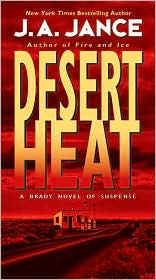 After
nine Beaumonts, Jance wrote Hour of the Hunter. Then the Beaumonts
became fun again. Then her agent suggested maybe she wanted to alternate
with Beau. She did know about being a single parent, and knew a lot about
the desert. So, that became Joanna Brady's background. In Desert Heat,
Joanna Brady's husband is dead. He's buried in Graveside Cemetary in
Bisbee, the same cemetary where Doug Davis is buried. In Caifornia,
someone read that book. A woman came up to Jance two years later at a
signing, and asked, "Have you ever been to Bisbee?" When Jance
said she went to school there, she asked her if she knew Doug Davis. Jance
said she had. The woman said, my sister was engaged to marry him, and she
was packed to join him for R & R when he died. When she bought Desert
Heat, and read the scene at the cemetary, she thought the author might
have known Doug Davis. She carried the book around with her for two years.
J.A. Jance and Bonnie became friends. Bonnie didn't know any of Doug's
Bisbee friends, so she was able to learn about his life there from Jance.
She married after losing Doug, but the marriage didn't last. Her husband
couldn't compete with the legend of a dead guy. After
nine Beaumonts, Jance wrote Hour of the Hunter. Then the Beaumonts
became fun again. Then her agent suggested maybe she wanted to alternate
with Beau. She did know about being a single parent, and knew a lot about
the desert. So, that became Joanna Brady's background. In Desert Heat,
Joanna Brady's husband is dead. He's buried in Graveside Cemetary in
Bisbee, the same cemetary where Doug Davis is buried. In Caifornia,
someone read that book. A woman came up to Jance two years later at a
signing, and asked, "Have you ever been to Bisbee?" When Jance
said she went to school there, she asked her if she knew Doug Davis. Jance
said she had. The woman said, my sister was engaged to marry him, and she
was packed to join him for R & R when he died. When she bought Desert
Heat, and read the scene at the cemetary, she thought the author might
have known Doug Davis. She carried the book around with her for two years.
J.A. Jance and Bonnie became friends. Bonnie didn't know any of Doug's
Bisbee friends, so she was able to learn about his life there from Jance.
She married after losing Doug, but the marriage didn't last. Her husband
couldn't compete with the legend of a dead guy.
She tells this story because J.P. Beaumont couldn't let go of his wife's
legend. He only had a brief relationship with her, but it hung on.
Jance told us Beaumont does talk to her. She'll be writing along, and
he'll say something that makes her laught. She'll write it, but he said
it.
In the last Beaumont book, Fire and Ice, he was attending a family
reunion at Disneyland. He has a motion sickness problem, but he went on
the Teacups. He ended up at the infirmary after riding them, and the nurse
asked, if you know you have motion sickness, why did you go on the
Teacups. His answer? My granddaughter asked me.
J.A. Jance had just fnished an Ali Reynolds book. She writes boooks, and
Bill writes checks. She watches characters. He watches the cash flow,
which can have peaks and valleys. She had just sent the manuscript off to
her editor on a Friday afternoon. At dinner that night, Bill asked, is
what he thought was an inoffensive fashion, have you given any thought to
the next Beaumont book. She said, as a matter of fact, it's going to be
about the Washington state governor. He wasn't impressed, but she started
writing it on Monday. It's about the Washington state governor. It took
her two months to write it. Don't discount the effect of a head of steam
when mad. The next Ali Reynolds took her nine months to write. Betrayal
of Trust took two.
Jance needed two points of information from Beaumont's past for this book.
But, she had written nineteen books about him, and these were unimportant
details. She writes a blog on her website, www.jajance.com.
She writes about one a week. Think of it as Erma Bombeck for free. She put
an S.O.S. on her blog. She needed Beau's mother's given name, and the name
of his English teacher, and told the readers whoever answered her would
become characters in the book. So, the book is dedicated to Joan and
Rebecca, and they are also worked into the story in return for helping
her.
The next Ali Reynolds book, Left for Dead, will be out in January
or February. Nobody tells her since she's just the author. She's working
on next summer's Joanna Brady. Writing four sets of characters in four
locales keeps it fresh and interesting for her.
She said someone always asks if she outlines. She met outlining in sixth
grade geography class, and hated it then. Nothing has changed. She has a
terminal fear of Roman numberals, and you can't fear them and outline. She
starts the books with somone dead, and spends the rest of the book finding
out who did it and why.
J.A. Jance writes out deadline. She told us when she's hit by lightning,
we can assume there will be no more books. There are no manuscripts piled
up somewhere.
Jance ending by reminding us After the Fire is her book of poetry.
It's her autobiography about the years with her first husband while he was
dying of booze. It's published by the University of Arizona Press. When
asked, she tells people that Hour of the Hunter is her favorite
book. The main character wants to be a writer. Her husband is dead. He was
allowed in the creative writing class she wasn't allowed in. And, a former
professor of creative writing from teh University of Arizona is the crazed
killer.
J.A. Jance's website is www.jajance.com.
Betrayal of Trust by J.A. Jance. HarperCollins. ©2011. ISBN 9780061731150
(hardcover), 352p.
lholstine@yahoo.com
book blog: http://lesasbookcritiques.blogspot.com
Twitter @LesaHolstine
|
|
Hounded by Kevin Hearne

Review
by: Lesa Holstine Glendale Daily Planet Book
Topics Editor
I'm a big fan of Jim Butcher's Dresden Files, but
Jim Butcher doesn't write fast enough. I just discovered a new author,
though, whose first urban fantasy book introduced two characters that were
just as much fun as Harry Dresden and Bob. In fact, there's more wordplay
and humor in Kevin Hearne's first book in The Iron Druid Chronicles than
in the Dresden Files. Make no mistake. Hearne takes his story, the
mythology, and the action seriously. But, his characters are two of the
best characters I've ever read about in a fantasy novel. Hearne's Hounded
sold me, and I've already picked up the second book, Hexed. I'm
quite content to read about Atticus O'Sullivan and his Irish Wolfhound,
Oberon.
 Atticus
O'Sullivan is a Druid who has lived for twenty-one centuries, but looks to
be twenty-one, a perfect appearance for living in a college town. He now
resides in Tempe, Arizona, where he owns an occult bookshop, Third Eye
Books and Herbs. He's perfectly content to operate his store, spend time
with his Irish Wolfhound, Oberon, and hang out at his favorite Irish pub, Rúla
Búla. Unfortunately
for Atticus, one of the Celtic gods, Aenghus Óg, is not happy that
Atticus has a magical sword, Fragarach.
Aenghus Óg has been tracking Atticus for centuries, and, with the help of
some witches, nightmarish creatures, and even some local police, he's
found him. Atticus is going to have to call on his own power from the
earth, along with his lawyers; a werewolf and a vampire, and a few
semi-friendly Celtic gods in order to survive the wrath of an angry god. Atticus
O'Sullivan is a Druid who has lived for twenty-one centuries, but looks to
be twenty-one, a perfect appearance for living in a college town. He now
resides in Tempe, Arizona, where he owns an occult bookshop, Third Eye
Books and Herbs. He's perfectly content to operate his store, spend time
with his Irish Wolfhound, Oberon, and hang out at his favorite Irish pub, Rúla
Búla. Unfortunately
for Atticus, one of the Celtic gods, Aenghus Óg, is not happy that
Atticus has a magical sword, Fragarach.
Aenghus Óg has been tracking Atticus for centuries, and, with the help of
some witches, nightmarish creatures, and even some local police, he's
found him. Atticus is going to have to call on his own power from the
earth, along with his lawyers; a werewolf and a vampire, and a few
semi-friendly Celtic gods in order to survive the wrath of an angry god.
Atticus
O'Sullivan is a wonderful hero for an urban fantasy with his love of the
earth, his wisdom gained over centuries, and his wicked sense of humor. He
has a power and longevity unusual for a Druid. And, Atticus combines his
love and connection to the earth with the power he built over years into a
protective iron amulet. And, then there's his relationship and
conversations with his Irish Wolfhound, Oberon. The conversations are
funny, and witty. Fantasy lovers will think Oberon reminds them of Bob,
the skull in the Dresden Files. Mystery lovers will be reminded of Chet,
the wonderful dog in the Chet and Bernie series by Spencer Quinn.
Hearne has a wealth of material with the gods
and goddesses of Celtic myth. And, Arizona is a perfect landscape for an
urban fantasy series, with a college community on the edge of desert and
mountain terrain. Hounded was the best urban fantasy discovery I've
made since I first read Jim Butcher years ago, before he was popular. I
already have Hexed, the second in the series, and I'm waiting for
the third, Hammered, which was just released. And, I was so
impressed with the first book that I've invited Kevin Hearne to appear for
Authors @ The Teague.
Congratulations to Kevin Hearne, an Arizona
author and high school English teacher. I hope his Iron Druid Chronicles
are as successful as the Dresden Files.
Kevin Hearne's website is www.kevinhearne.com
Hounded by Kevin Hearne. Del Rey. ©2011.
ISBN 978034552474 (paperback), 304p.
lholstine@yahoo.com
book blog: http://lesasbookcritiques.blogspot.com
Twitter @LesaHolstine
|
|
No Rest for the Dead

Review
by: Lesa Holstine Glendale Daily Planet Book
Topics Editor
In introducing No
Rest for the Dead, David Baldacci said, "The lineup of
writers who have contributed to this mystery is akin to the
Murderers' Row of the 1927 New York Yankees." He's right.
Twenty-six authors, including Arizona favorites J.A. Jance and
Diana Gabaldon, along with Jeffery Deaver, Tess Gerritsen, Jeff
Lindsay, Kathy Reichs, and Jonathan Santlofer joined forces with
editors Andrew F. Gulli and Lamia J. Gulli to tell one story.
 Former
homicide detective Jon Nunn introduces the story, ten years
after Rosemary Thomas' execution for her husband's murder. And,
although Nunn's testimony helped send her to death row, he's not
convinced she actually killed her husband. After Rosemary's
death, Nunn's obsession with the case cost him his job and his
marriage. So, when the invitation arrives from a board member at
San Francisco's McFall Art Museum to attend a memorial service a
decade after Thomas' execution, Nunn is eager to see all the
players back in one place. Former
homicide detective Jon Nunn introduces the story, ten years
after Rosemary Thomas' execution for her husband's murder. And,
although Nunn's testimony helped send her to death row, he's not
convinced she actually killed her husband. After Rosemary's
death, Nunn's obsession with the case cost him his job and his
marriage. So, when the invitation arrives from a board member at
San Francisco's McFall Art Museum to attend a memorial service a
decade after Thomas' execution, Nunn is eager to see all the
players back in one place.
The book is divided into two parts. The 1998 section tells the
story of the crumbling marriage between Rosemary Thomas and her
cheating, crooked husband, Christopher, curator at the McFall
Art Museum. Each author adds a little bit more to the story,
revealing Christopher's schemes and character, leading up to his
disappearance and the discovery of the decaying body in a Berlin
museum. While Nunn investigates, he grows to like Rosemary, but
can do nothing when all evidence points to her guilt.
Ten years later, the detective has lost everything but his
conviction that an innocent woman was executed. When the board
president invites all the players back to the museum for a
memorial service, the stage is set for a final confrontation.
But, remember, this is a book written by twenty-six of the
prominent authors in the crime fiction business. There will be a
number of surprising twists before the reader learns what really
happened to Christopher Thomas.
I was surprised at how well this story worked with twenty-six
writers. And, at times, their distinct styles were very evident,
particularly in the first half of the book. Some of the authors
created much more readable episodes than others. As a fan of
cold cases, I particularly appreciated the second half of the
book in which the characters looked back at the case from a
ten-year perspective. I found Marcus Sakey's concluding chapter
a little outrageous, but, considering the characters, even that
fit in the story. And, Jon Nunn's diary entries served to tie
the story together.
Looking for a fast-paced, intriguing mystery for a quick summer
read? No Rest for the Dead should serve nicely. And,
proceeds from the book benefit the Leukemia & Lymphoma
Society.
No Rest for the Dead. Simon & Schuster. ©2011. ISBN
9781451607376 (hardcover), 272p.
lholstine@yahoo.com
book blog: http://lesasbookcritiques.blogspot.com
Twitter @LesaHolstine
|
|
Robert Dugoni for Authors @ The
Teague

Story and Photos by: Lesa Holstine Glendale Daily Planet Book
Topics Editor
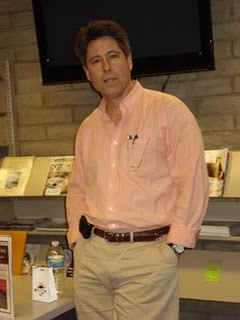 Robert
Dugoni appeared at the Velma Teague Library on his book tour for
Murder One. He told us the Phoenix area was his last stop
on an extensive tour. He spoke at the library, and he was
speaking for the Poisoned Pen Conference over the weekend,
ending the trip with a class on the craft of writing on Sunday.
Then he was heading home to Washington state. Robert
Dugoni appeared at the Velma Teague Library on his book tour for
Murder One. He told us the Phoenix area was his last stop
on an extensive tour. He spoke at the library, and he was
speaking for the Poisoned Pen Conference over the weekend,
ending the trip with a class on the craft of writing on Sunday.
Then he was heading home to Washington state.
He did get to lay by the pool on Thursday, but it was a
difficult trip. There were a number of changes in flights due to
all the storms in the south. One night, when his flight was
canceled, he was faced with sleeping in the Charlotte Airport.
The hotels had no vacancies at 1:30 in the morning. When a
Holiday Inn van came around, he jumped in with a bunch of other
people. The others put their baggage in the bag, but Bob knew
they'd have to wait to unload their baggage, so he held onto
his. He hurried into the hotel, and, even then, was fourth in
line. He kept hearing the question, "Do you have a
reservation?" When he got to the front, and was asked,
"Do you have a reservation," he pleaded with the line
from the Steve Martin/John Candy film, Planes, Trains, and
Automobiles, "Have mercy." They found him a room,
and he went to sleep at 2:30, only to get up at 5:30 to get to
the airport. He had a 7:40 flight to Hilton Head. Then, that was
canceled, so he had two flights out of Charlotte canceled.
Dugoni said he never thought he'd write a series. When he wrote
the first David Sloane book, The Jury Master, he never
thought he'd see the character again, so he tortured him. Then,
when it hit the New York Times Bestseller list, his
editor told him they wanted more David Sloane. Murder One
is the fourth one in the series. It's had fabulous reviews, and
even Publishers Weekly liked it. He's had a number of starred
reviews. Bob did a large amount of research for this book.
According to Dugoni, the book you see isn't what he started to
write. He starts with a big idea, but he takes it down to the
personal level. You used Wrongful Death as an example. He
had a friend whose child died due to a toy. So, Bob researched
the toy industry. But, Wrongful Death became the personal
story of someone who wanted justice, and contacted David Sloane,
the lawyer who couldn't lose, to try to get justice.
 With
Murder One, Dugoni researched the Russian mafia, since
it's very big in Seattle. He thought Sloane was going to take it
on. He researched about the fall of Russia, the drug trade. The
Russian mafia viewed capitalism as a legal way to steal. Four or
five months after he started his research, the catalog copy for
Robert Dugoni's new book came out. Bob read it, and contacted
his editor, telling her that's no longer what the book is about.
His editor, who is also his publisher, said, talk to me. Bob
said the book is a personal story about a woman who lost her
daughter to a drug overdoes. She asks Sloane to go after the
Russian mafia in a civil case. Dugoni told his editor he saw it
as a cross between Presumed Innocent and Basic Instinct.
Afterward, Bob thought, "Oh, my God. What did I just
do?" The book has to be a criminal trial book. Sloane is a
civil lawyer. He doesn't do criminal law. Robert Dugoni doesn't
do criminal law either. With
Murder One, Dugoni researched the Russian mafia, since
it's very big in Seattle. He thought Sloane was going to take it
on. He researched about the fall of Russia, the drug trade. The
Russian mafia viewed capitalism as a legal way to steal. Four or
five months after he started his research, the catalog copy for
Robert Dugoni's new book came out. Bob read it, and contacted
his editor, telling her that's no longer what the book is about.
His editor, who is also his publisher, said, talk to me. Bob
said the book is a personal story about a woman who lost her
daughter to a drug overdoes. She asks Sloane to go after the
Russian mafia in a civil case. Dugoni told his editor he saw it
as a cross between Presumed Innocent and Basic Instinct.
Afterward, Bob thought, "Oh, my God. What did I just
do?" The book has to be a criminal trial book. Sloane is a
civil lawyer. He doesn't do criminal law. Robert Dugoni doesn't
do criminal law either.
There was a capital murder case being tried in King County just
at that time. It was a horrific crime. A young man slaughtered
two women and two children. It was unusual for King County to
have a trial with four capital murder charges because Washington
is a liberal state. The senior prosecutor was a friend of
Dugoni's, and he was able to get in to watch the trial. For
three months, he sat in the back and watched it. A criminal case
is like a play on stage. When the jury is out, everyone is quite
casual, with jackets off, and talking together. When the jury
comes back in, jackets are on, ties are up, and it's
business-like. Dugoni recommended that the audience see a
criminal trial if they get the chance. Part-way through the
trial, the judge called counsel into his chambers and asked, who
is the guy in the back taking notes. He was told it was a
novelist who wasn't writing about that case, but needed
information.
Eventually, Bob was able to go to lunch with Brad Porter, the
homicide detective from the case. He walked him through the
investigation. Then, he said, "But, you know, you really
should talk to a CSI homicide detective. So, he toured the
Washington Crime lab. Then, someone said, "But, you know,
you really should talk to Kathy Decker, a man-tracker." She
can look at vegetation, and tell when someone walked through it.
She worked on the Green River case. So, he met her at Starbucks.
She was quite tan, and he asked her if she played sports. No,
she had her tan from working outdoors. She spends a lot of time
looking for bodies. She can look at footprints on a lawn, and
say how long they've been there, the weight of the person who
made them, and, if there are overlapping footprints, who stepped
there first.
Then, she said, "But, you know..." The investigators
would have brought a dog. So, she hooked him up with a sergeant,
a man nicknamed Ziggy, who handles canines. And, he told him he
should see the dogs in action, so he was to meet them at
midnight at a warehouse. The dogs actually scent skin cells.
They can even scent people in water. Then, when Dugoni thought
he was done at 2 a.m., he was told, "But, you
know...," you need to talk to a ballistics expert.
So, Bob was to meet the head guy for the Washington State
Criminal Lab at a Starbucks. And, he got there, and waited, and
finally he saw a guy who looked about 14 watching him, and he
asked, "You, Bob?" He was in his forties, but when he
got out of school with a degree in English, he couldn't find a
job. So, he got a low-paying job with the criminal lab, and it
turned out he was good at blowing things up and shooting things.
He has a talent for simulating shootings. But, he told Bob there
was a lot of stuff they needed for the lab, so he was hoping Bob
would put the stuff in his book so they could get it. There were
so many people that helped him with the research for Murder
One.
Even with all that help, Dugoni still had to find a way to get
David Sloane into criminal court. Then he realized this is the
fourth book in the series, but really a sequel to Bodily Harm.
David is coming out of grieving. He connects with Barclay Reid,
the attorney he was up against in Bodily Harm. Now, she's
a mother who lost her duaghter.
In thirteen states there is a "Drug dealer liability
act." You don't have to show why a drug dealer is
responsible for a death, just that the guy deals heroin, for
example, and you can go after him. But, Washington doesn't have
that law. Barclay has been lobbying for the legislature to pass
it, but the system fails her. So, she goes to David, the
attorney who can't lose, and asks him to sue in civil court.
Before he can take action, the drug dealer she blames ends up
death, and all evidence points to Barclay. She insists that
Sloane take the case, and he agrees to defend her.
This is the story Dugoni sent his editor, and then he waited.
Finally, he got a phone call saying it was great. Murder One
has received great reviews. But, Bob's favorite came from a
blogger in Washington who said the book is a cross between Presumed
Innocent and Basic Instinct. Dugoni is happy with the
book, and happy he didn't shy away from criminal court.
One question from the audience referred to the man-tracker. They
wanted to know who she was teaching her skills to. Dugoni said
she's part of the search-and-rescue team in Washington. Homicide
there is divided into six divisions. It takes 1200 hours of time
in class and working before you can be certified as a
man-tracker. It's a job that is mostly finding bodies. And,
sometimes the bodies have been dead for decades, as in the case
of the Green River killer.
Dugoni modeled the homicide detective, Kinsington Rowe, in Murder
One, on Brad Porter, the detective that helped him. He's
contemplating doing a second series. He'd like to bring back
Kinsington Rowe. He also had the chance to meet Washington's
only female homicide detective, and she was honest, telling him
how no one wanted to work with her. If he does that second
series, he'd do two books a year.
Bob has started another book, but it's hard to write on the
road. That book would be out in June 2012. It's another David
Sloane. This time, though, his publisher made him work from an
outline. That book will be Jake's story, the story of Sloane's
son. He realized they have parallel lives. Both Jake and David
watched their mothers die violently at a young age. He's going
to deal with the psychological and legal elements.
With Bodily Harm, Dugoni took a leap of faith that his
readers would follow him. Other authors told him not to kill off
Sloane's wife. But, Dugoni never intended to write a series, and
he doesn't ever want to write the same book over and over. He
won't cheat the reader with a cheesy ending. Every book has to
stand on its own, and he doesn't want readers to say they could
predict the ending. He wrote Bodily Harm when he himself
was dealing with grief because he had lost his father that year.
Everyone has to deal with grief sometime, and he wanted his
character to have to go through the same thing. In that book,
Sloane showed that he could be vulnerable, angry, rage, and want
revenge.
Asked about writing time, Bob said he doesn't follow a certain
schedule; he just writes. He starts as early as he can, and just
goes, without setting limits. He may go until 3, when it's time
to pick the kids up. He's a father of two who are involved in
sports, and he enjoys sports. In the evening, he'll work on
Facebook and Twitter.
He said his characters do talk to him. He might go through a
book forty times. He views it as a blank canvas for an artist,
and each time he goes through it, the details become clearer. He
didn't see at first that Jake and Sloane were leading parallel
lives.
In closing, asked about the writing classes, Bob Dugoni
closed by saying this weekend he was teaching a class on
creative pageturners, how to maintain suspense. He said the
characters need to entertain, not the writer. The number one
purpose of the writer is to entertain.
Bob Dugoni's website is www.robertdugoni.com
Murder One by Robert Dugoni. Simon & Schuster. ©2011. ISBN
9781451606690 (hardcover), 374p.
lholstine@yahoo.com
book blog: http://lesasbookcritiques.blogspot.com
Twitter @LesaHolstine
|
|
Jane K. Cleland and Rosemary
Harris
for Authors @ The Teague

Story and Photos by: Lesa Holstine Glendale Daily Planet Book
Topics Editor
 |
| Left
to right - Jane Cleland and Rosemary Harris Photo by Bette Sharpe
- Glendale Daily Planet |
Like Avery Aames and Kate Carlisle, Jane Cleland
and Rosemary Harris frequently do book tours together, so they played off
each other beautifully for their Authors @ The Teague presentation. Jane
kicked off the program by saying her latest book, Deadly Threads,
is the sixth in her Josie Prescott series, but you can read any of them
without starting at the beginning. She said Deadly Threads is about a cat
that fetches, betrayal, and vintage clothing.
 Cleland
wanted to start by telling us about the cat in the story, Hank. Jane
needed a cat that would fetch as part of the story, and Maine coon cats do
fetch. When Jane first received the cover art from her publisher last
summer, she said she loved the cover art, but the cat in the artwork was a
tabby, and not a Maine coon cat. So, she sent them a picture of her own
cat, Louie, who is a Maine coon cat. The next time the saw the artwork, it
was Louie's picture on the front, but Louie had been photoshopped and made
thinner. Cleland
wanted to start by telling us about the cat in the story, Hank. Jane
needed a cat that would fetch as part of the story, and Maine coon cats do
fetch. When Jane first received the cover art from her publisher last
summer, she said she loved the cover art, but the cat in the artwork was a
tabby, and not a Maine coon cat. So, she sent them a picture of her own
cat, Louie, who is a Maine coon cat. The next time the saw the artwork, it
was Louie's picture on the front, but Louie had been photoshopped and made
thinner.
Why is the cat named Hank? Cleland's husband is a musician. He's playing
right now for The Lion King. For quite a while, he played with the
touring production of Les Mis. When Jane would visit her husband,
she would also visit with a cat named Hank who traveled with the show.
Steve, an electrician with the company, owned an orange tabby named Hank,
and the top of the electrician's trunk would open up with a place for Hank
at the top. When the tour moved from city to city, Steve and Hank would
board the crew bus together. Well, a new crew member joined the tour, and
he was allergic to cats, so Hank got booted from the bus. Hank needed a
ride to Fresno, and since Jane was visiting, she and her husband, Joe,
were driving a car to Fresno, and Joe said, sure, they'd take Hank. When
the day came, Steve, this big teamster, brought Hank in his carrying case,
gave him a kiss, and said, "Be a good boy, Hank. It's your only
chance." So, now whenever the tour moves on, Hank gets a ride with
someone going by car.
Jane got to thinking. Steve's been with the show for eight years, with
Hank as his constant companion. And, lonely travelers need someone to keep
the lonely buggers at bay. It reminded Jane of her character, Josie
Prescott. At the beginning of the series, she's a stranger at a difficult
time. She had left New York for the rugged coast of New Hampshire, and
she's trying to find a community, trying to fit in. Hank is now part of
her community.
 Rosemary
Harris pointed to her book jacket for Slugfest and said you'll
notice there is no pet slug on the cover. In fact, she had to fight for
the title. Her Dirty Business mystery series has a gardening thread. She
said her books don't contain gardening tips and details for gardening in
Arizona, but she does know that slugs are a fact of life anyplace. Rosemary
Harris pointed to her book jacket for Slugfest and said you'll
notice there is no pet slug on the cover. In fact, she had to fight for
the title. Her Dirty Business mystery series has a gardening thread. She
said her books don't contain gardening tips and details for gardening in
Arizona, but she does know that slugs are a fact of life anyplace.
Rosemary said she has volunteered at the information booth for the
Philadelphia Flower Show for ten years. People bring in samples, and, now,
even small pictures on their cell phone, and expect the volunteers to be
able to look at those and tell them what happened to their plant. Asking
if anyone had seen the movie Best in Show about the dog show world,
Harris said people can be just as neurotic at flower shows. She's seen
people at 7 a.m. with their misters and cuticle scissors so they can tend
their plants.
Slugfest is the fourth book in Harris' series. This time, she takes
her amateur sleuth, Paula Holliday, to New York City. It's helpful to take
an amateur sleuth out of their small town once in a while. She said she
knew the audience all knew about Cabot Cove Syndrome in small towns. It's
pushing the envelope to have so many dead bodies in small towns. So Paula
helps a friend out at a fictional flower show. That allows Harris to
introduce an interesting cast of characters, somewhat edgier than they
might be in a small town.
Rosemary said the box of chocolates I gave her from Ceretta's reminded her
of the beginning of her story. She had already received the Authors @ The
Teague mug on a previous visit, so this time I gave her a box of candy. A
box of candy was the trigger for her first book, Pushing Up Daisies.
Harris read an article about a mummified body being found, and, just like
an amateur sleuth, she snooped. She was lucky enough to have a telephone
interview with the doctor who autopsied the body, and he said it wasn't
100% identified. But, he did say it was found with a box of chocolates.
That was Rosemary's "what if" moment. She thought that box of
chocolates had to be a clue, and she was hooked from that.
Jane told us with the publication of Deadly Threads, she's holding
a contest on her website to give away a vintage Pucci purse. No one has to
guess the right answer. It's just a random drawing at the end of the
month. Her website is www.JaneCleland.net.
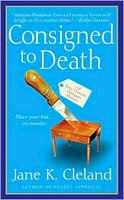 Cleland's
character, Josie Prescott, is originally from New York. Asking us if we
remembered the price fixing scandal involving auction houses a few years
ago, Jane said that happened to Josie, and she was the whistleblower Cleland's
character, Josie Prescott, is originally from New York. Asking us if we
remembered the price fixing scandal involving auction houses a few years
ago, Jane said that happened to Josie, and she was the whistleblower
.Cleland
once owned a rare book store in Portsmouth when she was in her 20s. She
was asked to appraise books once for a woman, and, going to her house,
found that every inch of wall was covered in art. Her breath was taken
away by a Rembrandt, a self-portrait. And, the woman said, "That's a
little something my brother brought back from the war." She didn't
think much more about it until twenty years later when stories came out
about ill-gotten gains from the Nazis. Elizabeth Taylor was sued over a
painting, although she won the case. The Nazis stole 1/3 of all Western
art. They knew what they were doing, and boxed it up. But, there are over
100,000 pieces missing yet. All of that came together. Cleland thought,
what if Josie discovered art that had been stolen by Nazis. That
became her first mystery, Consigned to Death.
 Harris
remarked that both authors were inspired by news features. Harris' Dead
Head came about because of a story she read about a California woman
yanked from her Lexus in her driveway. She was a fugitive from the law who
had three kids, and an upper middle class lifestyle. But, someone informed
on her. She was an escaped convict whose grandfather had helped her flee
prison. But, it was easier to create a new life in the 80s. Harris
researched how you could disappear yourself. Cleland said she once read a
book about how to hide assets and disappear forever. Harris
remarked that both authors were inspired by news features. Harris' Dead
Head came about because of a story she read about a California woman
yanked from her Lexus in her driveway. She was a fugitive from the law who
had three kids, and an upper middle class lifestyle. But, someone informed
on her. She was an escaped convict whose grandfather had helped her flee
prison. But, it was easier to create a new life in the 80s. Harris
researched how you could disappear yourself. Cleland said she once read a
book about how to hide assets and disappear forever.
Going back to the covers, Harris said she would have at least liked a
silvery slug trail on the cover of Slugfest, indicating people
leave trails wherever we go. She usually has input into the covers.
Harris said she has no input as to the cover. She does a clause saying
she's to be consulted about the covers. She likes a more serious,
photographic style, as in the latest book. When she received the artwork
for Consigned to Death, she wrote the publisher saying she liked
the color, but not the cover. It was too cartoony. She heard back from the
publisher. "We're glad you liked the color."
Rosemary said they both had ended up with the dreaded pink cover on one of
their books. For some reason, publishers want women's books to be pink.
But, to her it's a signal that it's girly chick-lit, not as serious as
most mysteries are. Rosemary said she's funny, but she takes the
investigation of a murder seriously. Jane said she herself is likable, but
not funny. Mysteries are serious.
How did they start writing? Cleland wrote four nonfiction books in the
field of business communication since she's a trainer. Her last one, Business
Writing for Results, included a number of anecdotes, and her agent
said maybe you want to try your hand at fiction. Jane only reads murder
mysteries. So, she wrote one about a hot male P.I. in New York. She loved
it. But, her agent sent it out, and after four or five rejections, she
asked her to withdraw it. She kept hearing the same thing. No one was
interested in male private investigators in New York in the early 2000s.
But, one editor did say, if she wrote about a female amateur, not in New
York, he'd like to see it. Jane worked hard on the first twenty pages, and
asked the agent to send that because she wasn't going to continue if she
wasn't on the right track. The editor said yes. It took her ten months to
write it. That book became Consigned to Death.
Rosemary said that article about the mummified body is what inspired her
to write. She thought, I'll write a story about that. She had never
written anything longer than an email or a thank you note. But, she wanted
to write that story and see how it went. She wrote and rewrote it. A
friend said she thought it was publishable. At the time, Harris thought
that was an insult, but now knows it was a compliment. She had three
rejections from agents. Then she went to the public library, and looked in
the front of mysteries that seemed similar to hers. She sent letters to
ten agents who represented those books telling them why they should
represent her.
Cleland told us she and Harris have very different writing styles. Jane
writes notes on little pieces of paper or cocktail napkins, but that's the
last thing she writes out. Everything else is done on a computer. She's
finishing book seven in the Josie Prescott series now, tentatively called Dolled
Up for Murder. She has a computer folder called "Extra
Stuff," and she can search the folder by keyword search.
On the other hand, Rosemary writes with pencil on a legal pad. She does
everything in longhand. She'll write one chapter at a time, and then put
it on the computer.
Jane Cleland recently interviewed four bestselling authors for an article
about the writing process, Lee Child, Charlaine Harris, Gayle Lynds, and
Wendi Corsi Staub. None of them does anything similar in the writing
process. Jane writes the plot first, then goes back to write exposition
and emotion, and then to tweak it. Rosemary gets the story down. Then
she'll go back over it for humor. Then, she does character and
description, but Harris doesn't include a lot of description. She has a
character, Babe, a former backup singer who now runs the diner where Paula
hangs out. At a recent library event, people around the room gave their
ideas of Babe's appearance. They described her as looking like Goldie
Hawn, Susan Sarandon, and even Pam Greer, a black actress.
Jane said she also goes through her work for timing. You can't mess that
up. People will call you on timing and distance - you can't get to that
place in that amount of time. Rosemary said a man wrote to her who now
lived in North Carolina, but once lived in Connecticut. He took exception
to the height of a mountain in one of her books, saying there was no
mountain that high in the area. Harris actually hadn't given the height.
Cleland has a funny story about Paul Revere's abacus, and a reader. She's
a devoted fan of Rex Stout's Nero Wolfe, and she often integrates trivia
from the Nero Wolfe books into her stories. In one of the stories, Archie
Goodwin has to get in to see a man who won't talk to him, but he knows the
man collects silver, so he says he has Paul Revere's abacus. When she used
that in one of her books, a man called and told Jane that Paul Revere
never made an abacus. Cleland asked him how he knew that. A lively
conversation ensued.
What's really in their books? The books feature antiques and gardening,
and they're fiction. Rosemary said in one of her books she made a
wisecrack, "There is actually a state of Connecticut, and a
University of Connecticut, but everything else is fiction." Someone
even argued with her about where Springfield, Connecticut is located.
There isn't one in Connecticut, although it's the most common city name in
the country. She likes it, though, that people read her books so closely.
Jane admitted she was called on a time zone problem for Silent Auction,
but Harris said that was something an editor should have caught.
The authors were asked if writing mysteries was a lucrative business. They
said there are a handful of authors who make a lot. But, most authors pay
for their own tours. They get by. They drag their husbands along as
chauffeurs. It's not that lucrative.
Jane and Rosemary discussed the economics of the business. Jane said she
gets an advance, half when she signs the contract, and then half when the
book is delivered. Then, you get royalties. She gets a share when it's
picked up by book clubs, or large print. You start with a small advance.
You don't want a big advance that doesn't earn out, meaning the publisher
loses money on you.
Rosemary said the big authors don't always earn out, though. Her husband
is a publisher with Random House, and, since he was in the audience, he
admitted the publisher can still make a profit. There may a small printing
cost, and the publisher gets the difference between the cost of printing,
and the sale price. The author might not earn out, but the publisher does
OK on the big authors anyways.
Harris told us most mystery authors are not in it for the money. They love
writing mysteries, and they love the mystery community. She always wants
to write a better book. It's a great gig. She's met wonderful people, and
then some like Jane. (Great deal of laughter there.) They've traveled all
over together. Jane has family all over the country.
So, the next question was, what makes a big name author successful. That's
the $64 million dollar question, the number Rosemary used, saying Janet
Evanovich was able to get that figure from HarperCollins. Luck has a great
deal to do with it. Something strikes a chord with readers. Some of it is
timing.
However, Lee Child set out to write a bestseller. He looked at Greek myths
and fairy tales that endured, and saw that many involved the lone man who
rides into town, cleans it up, and leaves. So, Jack Reacher was born.
Harris mentioned the never-ending Jane Austen thing. Janet Evanovich
writes humorous mysteries. She has a distinct voice, and people responded.
But, she said, if writing a bestseller was easy, everyone would do it.
Characters resonate with people. Lee Child's Jack Reacher resonates. He
says when he's in Germany, people say, Reacher's really German, isn't he.
And, when he's in Australia, they say, he's really an Aussie. It's Lee
Child's voice. When he was first published it was probably Robert Ludlum's
spy novels and Robert B. Parker's Spenser books topping the bestseller
lists. Child was fresh.
Cleland went back to the Jane Austen reference, saying she was named after
Jane Austen, her mother's favorite author. Rosemary said her mother was a
reader of mysteries and Harlequins, because they were inexpensive and
quick reads.
Jane said her Deadly Threads has actually been reviewed as a
romance, love gained and love lost. She didn't do that on purpose, though.
That reminded Rosemary of Malice Domestic, a mystery conference held in
the D.C. area with over 100 authors. She and Cleland teamed up for
Malice-Go-Round, in which they talk about their books for a minute and a
half and move on to the next table. By the end, they know each other's
pitches.
The audience knew that Jane Cleland's next book is Dolled Up for Murder,
so they wanted to know about Rosemary's next one. She hopes that it will
be The Fifth Woman, a standalone mystery set in a neighboring town.
Paula Holliday is a secondary character in it. And, there are some other
favorite characters. But, it's a different story, and she had to write it.
She hopes it's her next one. But, her publisher might disagree. Readers
often want the next one in the series, and the publisher has invested in
the series. The next Paula Holliday one will be Burning Bush, in
which the crime is arson.
Jane has written a murder mystery play, "Back to Jack," about
three women who dated a guy named Jack. He disappeared for a while, and
now he's back. He also drives them to drink Jack Daniels. He's murdered at
the end of Act 1. Cleland has been working on her MFA in playwriting,
partially titled, "Women Who Love Men They Hate." Harris' latest
project? She hopes to get back to her garden. She tours for 90 to 100
days, usually in the spring, and misses her garden.
For me, the perfect ending of this program was Jane Cleland's signature in
my copy of Deadly Threads. That might be a picture of her cat,
Louie, on the cover of the book, but it looks just like my beloved Nikki.
Jane's note was a perfect Mother's Day weekend signature. "For
Nikki's mom, from Louie's mom! Thank you, Lesa."
Jane K. Cleland's website is www.janecleland.net
Deadly Threads by Jane K. Cleland. St. Martin's Minotaur. ©2011. ISBN
9780312586560 (hardcover), 279p.
Rosemary Harris' website is www.rosemaryharris.com
Slugfest by Rosemary Harris. St. Martin's Minotaur. ©2011. ISBN
9780312569969 (hardcover), 275p.
lholstine@yahoo.com
|

Story and Photos by: Lesa Holstine Glendale Daily Planet Book
Topics Editor
 |
| Deborah
Coonts, Juliet Blackwell and Sophie Littlefield |
There were so many authors coming into
town before Tucson's Festival of Books that we were able to host
two days of Women in Crime for Authors @ The Teague. Juliet
Blackwell, Deborah Coonts and Sophie Littlefield starred in the
first panel.
Juliet Blackwell served as moderator, and started by thanking me.
She said I am a big supporter of the authors, a "huge
player" in the mystery field. She told the audience about my
blog, saying most authors slowly build a reputation, and it helps
to have someone with name recognition in your corner. She went on
to say that most authors have love affairs with their local
libraries. They know what an influence libraries have on kids. And
it was so wonderful to see the community really using the Velma
Teague Library. The library has been busy every time she and
Sophie have visited.

As moderator, Juliet said Sophie has an outstanding record of
writing. They met two years ago at a mystery conference in Alaska.
They both live in the Bay Area, but they met in Anchorage. They
met in the bar because that's where mystery writers connect with
others. Sophie told her she had written nine books, and Juliet was
impressed. Then Sophie went on, but none are published yet.
It wasn't long before she landed a multi-book contract.
The first two books in that series are out, A Bad Day for Sorry
and A Bad Day for Pretty. The next one, A Bad Day for
Scandal, is due out in June. Then, Sophie wrote a young adult
novel, Banished.

Sophie's latest book is Aftertime.
Littlefield wanted to try another genre. That novel is part
apocalyptic, with zombies. The zombies aren't the focus of the
novel though. It's about how one goes about reconstructing
society. Sophie and Juliet laughingly referred to Aftertime as
The Stand in bra and panties.
Blackwell also reminded the audience that Littlefield won the
Anthony Award for Best First Novel for A Bad Day for Sorry.
 In
introducing Deborah Coonts, Blackwell mentioned that Kirkus
Book Reviews is notorious for not liking any books. Their
reviews are always negative. But, they referred to Deb Coonts'
debut novel, Wanna Get Lucky? as "Deliciously
raunchy," and went on to say, "Although Agatha Christie
is probably spinning in her grave." But that fits the setting
since Coonts writes about Las Vegas. The second book in Deb's book
is Lucky Stiff. In
introducing Deborah Coonts, Blackwell mentioned that Kirkus
Book Reviews is notorious for not liking any books. Their
reviews are always negative. But, they referred to Deb Coonts'
debut novel, Wanna Get Lucky? as "Deliciously
raunchy," and went on to say, "Although Agatha Christie
is probably spinning in her grave." But that fits the setting
since Coonts writes about Las Vegas. The second book in Deb's book
is Lucky Stiff.
Juliet said she managed to publish her first novel. Her first
series was written with her sister, under the name Hailey Lind.
That was the Art Lovers' Mystery series. It was set in San
Francisco, and featured Annie Kincaid, an ex-art forger, now a
faux finisher. She said Annie legitimately gets entangled in art
crimes. And, she said, "I think Lesa referred to them as
caper novels." Sophie pointed out that Juliet did the cover
of the fourth book in the series, Arsenic and Old Paint.
 Juliet
also writes two paranormal series. The third book in her
witchcraft mystery series will be out in June. They feature Lily
Ivory who runs a vintage clothing store in Haight-Ashbury, and
she's a witch. Blackwell tries to be careful, presenting
traditional beliefs in her books. Juliet
also writes two paranormal series. The third book in her
witchcraft mystery series will be out in June. They feature Lily
Ivory who runs a vintage clothing store in Haight-Ashbury, and
she's a witch. Blackwell tries to be careful, presenting
traditional beliefs in her books.
If Walls Could Talk was the first book in the Haunted Home
Renovation series. Mel Turner is a reluctant contractor. She
renovates high end homes in San Francisco. The second book in that
series will be out in December.
The authors were asked how they find time to write. Deb has a
writing schedule. She goes to the gym, writes until she can't
write anymore, has breakfast, then writes more. She tries to write
1,500 to 2,000 good words a day.
Juliet said it isn't the writing. Authors have to find time for
marketing. They're expected to be on Facebook and Twitter. Twenty
years ago, writing was a private profession, not a public one.
Most authors like to write in a room alone. There's an amount of
pressure to be in constant contact with readers and reviewers
through Twitter or Facebook. That isn't a natural fit for many
authors.
Deb wanted to be a writer. She wanted to be published. She said
for her first promotional event, she had an audience of 150
people. She was handed a microphone and told, "Go out, and be
funny."
Sophie said she's naturally introverted. But, she can talk to
readers. But, she has a hard time doing radio. It's hard to carry
on a conversation with just one person on the radio, when that
person might not be a reader. In discussing a writing schedule,
though, she said she made a promise that her kids would always
come first. Some things can go, and usually it's sleep that can
go. Littlefield is grateful every day that she's still employed as
a writer.
Coonts said she's on the opposite end of the spectrum from the
others, just starting out as an author, trying to dig in when the
business of publishing is imploding. Sophie and Deb met at
Bouchercon, the mystery convention. Sophie said she's seen Deb's
book all over. It had nice promotion. Coonts mentioned that Sophie
wrote the blurb for Deb's latest book. "Lucky Stiff has
outrageously imaginative characters, high-stakes action, sizzling
love affairs, deadly enemies, naughty humor, and
never-saw-it-coming twists. Irresistible."
That was Juliet's segue to ask about the sex and romance in Deb's
books. Coonts answered that she was going through a divorce when
she wrote Wanna Get Lucky? She thought she was writing a
stronger romance novel, and the mystery was just there. She's
proud of the relationships in the books. But, her publisher didn't
know where to put her book. Coonts said just put me where Janet
Evanovich is. Deb's been called "The Janet Evanovich of Las
Vegas."
Deb's interested in her characters and having them grow. Sophie
asked if Coonts shoots, and she said yes; she was raised in Texas.
Her significant other is from New York, and he hadn't ever seen a
gun. So, when he saw one at her place, he asked, "Who knows
how to use that?" According to Coonts, in Las Vegas, you can
shoot anything. In her third book, she has her character, Lucky
O'Toole go to a shooting range with Dane, the security guard, and
he thinks lucky doesn't know how to shoot. Deb finds it a funny
scene.
So, what scenes do they love to write? Deb said in Wanna
Get Lucky? porn stars and swingers are in town at the same
time. The climax is at a swingers' party in Spanish Trail where
Coonts lives. Her father told her about wife-swapping parties in
the '70s and some of the games played. Deb was still nervous about
setting the party in her neighborhood until one of the neighbors
said, oh, the neighbor a couple doors down holds a swingers' party
once a month.
Since Juliet writes about witchcraft, she's always at risk of
offending people. With witchcraft, you're walking a fine line. In
the Bay Area, there are a number of people with Wiccan beliefs.
And, different segments have different beliefs, so you can't
please everyone. But, she hears how well she represents the
community. Blackwell does lots of research. And, she likes to
write about vintage clothes. She's not interested in long
description. She won't stick around to read long narrative in a
book. It's a difficult balance. How much narrative is enough.
Blackwell went on to say her books are cozies.
Deb asked Sophie about her heroine, because she's pretty edgy.
Littlefield said she's the only writer of bondage cozies. Her
character, Stella Hardesty, is fifty. She's a plain, everyday gal.
She was a victim of domestic violence, and now she has a business
correcting abusers, bad guys who hurt women. Sophie had to do
quite a bit of research on devices, so when she was in a shop, she
knew all the devices for bondage. She said as a mystery writer
there's a whole body of knowledge that you never knew you had. She
had the same discovery when she did research for her apocalypse
novel, Aftertime. Sophie was a homemaker before she started
writing. Every day she's learning something new. After her
apocalypse book, she knows how to make gasoline from plants. She
said, "My job is a joy."
When Deb said her stories about characters, not the story of
Vegas, Sophie agreed. Littlefield said Aftertime is a story
of characters, not the zombies, although they are important to the
story. The book shows how lonely her character was. But, that book
is the first of hers with a sex scene. In cozy mysteries, you
write, "They gently closed the bedroom door." But, her
father came to see her on tour, and this was the one book she
didn't want him to read. Aftertime is the first of a three
book series.
Juliet mentioned that the authors all wrote books in which the
places are almost characters. Coonts said she lives in Las Vegas
because she did what every parent does. She allowed her
fifteen-year-old son to pick where they would live. He picked
Vegas because he was into golf, and wanted to be the next Tiger
Woods. Now, she's glad he isn't.
But, Deb found magic in Vegas. It can be naughty, but, as she
pointed out to the audience, that can happen right off Grand
Avenue. There are shows, and silly things people do. They let
their hair down in Vegas, and enjoy themselves. They're relatively
sane. Vegas is a character in the books. The setting is a
fictional hotel/casino. It's over-the-top. Coonts said Lucky isn't
going anywhere because you have no imagination if you can't find a
story in Vegas.
Asked about the story ideas, Deb said the porn stars do come to
Vegas for the annual video awards, as in Wanna Get Lucky?
Coonts went, and sat in the back, and couldn't believe how
seriously they took the awards. She said her son did go with her
when she did research for the latest book. In Lucky Stiff,
a female oddsmaker ends up in the shark tank at Mandalay Bay. Deb
asked the attendant what would make the sharks attack a body. That
was enough for her son. He never accompanied her again.
Littlefield's Bad Day series is set in rural Missouri. Sophie
lived there for eighteen years, grew up there. Her new series is
set in California. She's lived there for the last
eighteen/nineteen years. Sophie said she can't do what Juliet
does, though. Juliet gets all the city details right.
The apocalypse series is set in California's central valley.
There's not a lot of vegetation there. Then, as you go toward the
Sierras, you come to the foothills, gold country. Then it's
forested. So, in a short time, you go from stark to lush. The
vegetation and livestock is killed off in the book, and the
characters have to find shelter. Sophie said authors ask, how can
we punish our characters the most? What can we take away that
hurts the most? So, in this series, Littlefield's character is a
botanist, suffering from the loss of the plants. She knows the
California wildflowers, the sense and smells. The plants will
return in the course of the books.
When Blackwell maybe she writes about the Bay Area because
everyone says, "Write what you know." Deb responded she
prefers, "What can you imagine?" Juliet bases her
stories on enough local detail to give the books the flavor of the
area, a flavor of San Francisco. For instance, Blue Bottle Coffee
is the current local favorite, replacing Peet's. There are coffee
wars in the area between people who favor different brands.
Juliet's witchcraft series is set in Haight-Ashbury, hippie
central in 1968. That gives a bit of flavor to the books, but
hippies can't afford to live there now. She hates the term gutter
punks, but that's what local street kids call themselves. They act
like hippies, but have no social agenda. It's a local thing.
Deb Coonts said the locals are pleased that she's written a
positive book about Las Vegas. She puts real places and people in
her books, and they like that. Blackwell admitted she uses real
places because she lacks imagination for some things. Deb did
worry about setting a murder in Mandalay Bay, but that's the only
shark tank in Vegas. She does give the Vegas police department a
hard time in her books, because Vegas police are rude.
Since Coonts hadn't had the chance to introduce her character, I
asked her to tell us about Lucky O'Toole. Lucky's in her early
30s. She was raised in a whorehouse. Her mother, Mona, owns the
bordello. Mona's a real pill. Lucky never knew who her father was.
At fifteen, she lied about her age and got a job as a cabana girl
at a casino. She calls herself the chief problem solver at the
Babylon, a position that doesn't really exist. As Head of Customer
Relations, she handles guests and handles problems. Her best
friend, Teddy, is a female impersonator who wants to get the girl.
That's Lucky.
Deb said Vegas is defined by what's in town. There's the World
Series of Poker, NASCAR, bull riders. Lucky deals with the
fall-out. She's vulnerable, and doesn't trust people easily, but
she wants someone in her life.
Deborah Coonts' third book is done, and turned in. The next one is
called So Damned Lucky. What's it about? A magician
disappears in the book. The UFO people are in town, and it
involves Area 51. And, there's 300 miles of storm drains under
Vegas, with people living underneath the city. And, there's a
French chef.
Sophie Littlefield's A Bad Day for Scandal is due out in
June. It's Sophie's favorite of her three books. The second in her
apocalypse series, Reapers, is due out in July. And, her
second young adult book will be out in October.
 The
third book in Juliet Blackwell's witchcraft series is due out in
June, Hexes and Hemlines. Dead Bolt, the second in
her Haunted Home Renovation series, will be out in December. The
third book in Juliet Blackwell's witchcraft series is due out in
June, Hexes and Hemlines. Dead Bolt, the second in
her Haunted Home Renovation series, will be out in December.
The authors were asked about their investment in their characters.
Do the characters talk back?
Coonts admitted the French chef held her third book hostage. He
was going to be the comic relief. She found herself stuck in the
middle of the book. Then, one night, she was lying in bed in a
fleabag hotel in San Antonio, and the French chef told her who he
was. The book went fine then.
Juliet agreed, saying she's been in a weird place in her books.
She knows where the story is going, but the characters wouldn't do
that, or say that. In her first Art Lovers' Mystery, the landlord
took over. He was just supposed to be the landlord, but he became
a love interest for Annie. Blackwell said that's exciting. It
feels like art, as if something is coming out.
Sophie said that is exciting. She has proposed a new YA series.
While writing, she had difficulty with a plot point. When she
understood the motivation, the entire plot followed from that. She
likes to know her characters.
Characters need a backstory, a history, according to Juliet. But,
it's important to know how much to tell the reader. There's
a whole history readers may never see.
Asked about outlining, the authors said there are two schools of
thought. There are outliners, and there are pantsers, writing by
the seat of your pants. Once you're established as an author, you
can submit a proposal, and have it accepted. Until then, you may
have to follow an outline.
Sophie pointed out that Jeffery Deaver spends eight months
outlining. Thriller writers tend to outline more than traditional
mystery authors. They get everything worked out, and then just
plug in dialogue. Authors who write character-based novels tend to
be more pantsers.
Blackwell turns in an outline. Then, she gets a little money. When
she turns in a manuscript, she gets a little more money. She's
keeping her stories in San Francisco. She'd love to shift the
stories to Oakland, where she lives. She's tried that, but her
Manhattan editors say, I don't think so. She said it's a great
discovery when you realize editors are working in publishing
because they love books. They're not in it for the money. They're
rooting for your books. They're not in it to give authors a hard
time.
Deb said she completely wings it when writing her books. They're
character-driven. Juliet knows her characters, and knows what
would be fun.
Fun. That's an afternoon spent listening to Sophie Littlefield,
Deborah Coonts, and Juliet Blackwell talk about books.
Juliet Blackwell's website is www.julietblackwell.net
Deborah Coonts' website is www.deborahcoonts.com
Sophie Littlefield's website is www.sophielittlefield.com
lholstine@yahoo.com
book blog: http://lesasbookcritiques.blogspot.com
Twitter @LesaHolstine
"Remember, books have no calories, they last longer than a latte and
you can
enjoy them again and again. The police won't stop you if you go on a book
bender." - Elaine Viets
|
|
Zoë Sharp,
Libby Hellmann and Cara Black at the library!

Story and Photos by: Lesa Holstine Glendale Daily Planet Book
Topics Editor
|

|
|
Left to right - Cara Black, Libby
Hellmann and Zoë Sharp
|
Usually, that heading says for Authors @ The
Teague or at The Poisoned Pen, but since I not only hosted Zoë Sharp,
Libby Hellmann and Cara Black at the library, but also went to see them at
The Poisoned Pen, this is a lengthy combined post.
Libby Hellmann acted as panel moderator, saying
when she and Cara toured together, they usually referred to it as the
Thelma and Louise tour. But, Zoë said she really didn't want to
play the Brad Pitt role.
 Cara
Black started by discussing her new book, Murder in Passy, the
eleventh book in the Aimée Leduc series. All of her books are set in
Paris. This one is set in the 16th arrondissement, a
neighborhood so large it has two zip codes. And, it's so chic that
the maids wear pearls. Cara
Black started by discussing her new book, Murder in Passy, the
eleventh book in the Aimée Leduc series. All of her books are set in
Paris. This one is set in the 16th arrondissement, a
neighborhood so large it has two zip codes. And, it's so chic that
the maids wear pearls.
Cara picked this arrondissement
because of her interest in the Basques. She lives in San Francisco, near a
Basque center. When Black's son was young, the family did a house exchange
and went to France. They stayed in Basque country, and found everyone warm
and welcoming. But, then they decided to go to Spain for a day to have
tapas. And, they became lost in the Pyrenees in the days before GPS. All
the street signs in that area had been defaced by Basque nationalists.
And, they came across the rubble of a house that had been bombed by the
ETA, the Basque nationalist and socialist group. The signs of violence in
such a peaceful setting was disturbing. When Cara learned there had once
been a Basque cultural center in the 16th arrondissement,
she knew she had found her next story. She wanted to write about overtones
of Basque terrorism in the elite neighborhood.
 Zoë
Sharp was next to discuss her latest book, Fourth Day. That's the
eighth book in the Charlie Fox series, featuring the female bodyguard.
This one is set in California. Sharp wanted to do a book about cults. But,
she wanted to twist expectations as to what a novel about cults would be.
The cult in this book isn't a normal cult. And, she went at the story from
a different angle. Sharp read about Waco and Ruby Ridge. And, she
talked to law enforcement about those places, asking what they would have
done. Zoë
Sharp was next to discuss her latest book, Fourth Day. That's the
eighth book in the Charlie Fox series, featuring the female bodyguard.
This one is set in California. Sharp wanted to do a book about cults. But,
she wanted to twist expectations as to what a novel about cults would be.
The cult in this book isn't a normal cult. And, she went at the story from
a different angle. Sharp read about Waco and Ruby Ridge. And, she
talked to law enforcement about those places, asking what they would have
done.
Zoë
picked California for her setting because it had the type of geography she
wanted. It's partially set in a desert location. It's a story about
Charlie's search for redemption. The Fourth Day cult believes that people
can't be rebuilt until they're broken. And, Charlie's searching for
answers. Sharp mixed all of this into her book.

Libby Hellmann told us Set the Night on Fire is
her seventh novel. She writes two series. They feature Ellie Foreman and
Georgia Davis. Libby wanted to write a standalone thriller, an adrenaline
filled book. So, she tried to think of the most frightening thing that
could happen to people, while avoiding threats to children and pets. What
if you were being followed and someone was trying to kill you, and you
don't know who or why? That's what happens to Lila Hilliard. While she
tries to answer that question, she uncovers information about her parents'
past that she never knew.
Lila's parents' story goes back to the '60s in
Chicago, including 1968 and the Democratic convention. There were six
young people who lived together. The story of what happened then is the
mid-section of the book. Two parts are set in the present, and one part of
the book in the past. Hellmann said she found it most exciting that she
had permission to use four lines from the Doors' Light My Fire as
the epigraph, and it didn't cost her a fortune.
Libby asked the authors to tell us about their
latest books. Cara started with Murder in Passy. Aimée's
relationship with her godfather, Morbier, has always been uneasy. He keeps
secrets from her about her family's past, including stories of her mother
as a terrorist. In this book, Morbier is accused of murdering his
girlfriend, and Aimée doesn't know if she trusts him to tell her the
truth. This book explores the issues of trust.
Black said Passy was a village until 1860 when it
became part of Paris. Empress Eugénie III, wife of Napoleon III, used to
go to Passy to take the waters. Balzac hid there to escape his creditors,
drinking fifty cups of coffee a day as he frantically wrote. The village
feeling still exists in Passy. Cara has a friend whose great aunt was a
maid in village. When they picked her up to take her to a retirement home,
she was crying, "I want to die in Passy!" She didn't want to
leave the village. Asked why there was a Basque cultural center there,
Cara answered that it wasn't always expensive to live in Passy. It had
proletarian roots.
In Fourth Day, Sharp's novel, Charlie and
her partner, Sean, are hired to go into Fourth Day to extract Thomas
Witney who went in five years earlier to prove that Randall Bane, the
charismatic leader, murdered Witney's son. Now, Thomas says Randall didn't
kill his son. But, soon after Witney comes out, he meets a tragic end. So,
his ex-wife wants to know if he was brainwashed. What happened to Witney
while he was there? And, she wants to know if a child in there is Thomas'
grandson.
So, Charlie goes in to Fourth Day. She's looking
for redemption, and thinks she might be able to find the truth if she goes
into that environment. What is the truth? The book goes against
preconceptions.
Zoë did a great deal of research about Waco and
Ruby Ridge. She enjoys doing research, but then you throw 90% of it away
when you write. She learned little points. There were hundreds of federal
agents at Waco. There were also two members of the British SAS there as
observers. When the ATF agents prepared to go in, the military knew they
weren't suited for the job. So, they told them to write their blood group
on their neck or forearm. Can you imagine a job so dangerous, you had to
write that on your body? Sharp used that in her book.
Libby Hellmann said people ask her why she wrote
about the '60s. She's originally from D.C., although she's lived in
Chicago for the last thirty years. But, when you grow up in D.C., and talk
about the neighbors, you're talking politics. Libby was in college in 1968
when Martin Luther King, Jr. was assassinated. And, her college boyfriend
had been tapped to head the youth for Robert Kennedy campaign. So, Libby
planned to drop out of college in the fall, and work for him. She was home
for the summer, and turned on the TV to learn Kennedy was shot. Her
friends were being drafted. She thought, why work through the system if it
didn't work for us. So, writing about those two years was an exorcism for
Hellmann.
Libby said she and her friends didn't succeed or
change anything. The system and the government are what it always was.
But, she's not the person she was at that time. She loved writing about
the '60s, finishing the book, and putting it behind her. It was an
exorcism. Zoë said someone said, "Whoever you vote for, the
government always gets in."
Cara said when she told Libby she was writing
about the Basques, Libby said she'd been friends with a Basque exchange
student in D.C. Elizabeta spent the '60s in Spain under Franco. She was
part of the protests, and spent time in prison for protesting. The Basques
wanted to keep their own language. Eventually, she fled to France by boat
to hide out. Sharp said there's no substitute for finding a person who was
there, even in the days of the Internet.

The authors were asked how they keep their series
fresh. Zoë answered that you take characters you care for, and create
conflict. There's pressure testing the character. So, she takes Charlie
Fox and tests her, or creates conflict. Charlie taught self-defense. So,
in Second Shot, Sharp had her shot twice on the first page. She
doesn't have her physical self-assurance. She spends half the book on
crutches. Each of Sharp's books is a standalone with the story of that
book. At the same time, she's relating the journey of the character in the
series. The individual story is the length of one book, but the
character's journey goes on.
 In
Murder in the Bastille, Cara Black asked how she could hobble Aimée
Leduc, and still allow her to do her job. Cara said a woman in her writing
group was blinded for eight months because of a virus. She eventually got
her eyesight back. So, in this book, Aimée is blinded. But, Black was
thirty pages into the writing of it, and felt like a fraud. How can she
describe Paris when Aimée can't see it? So, René, a dwarf, and Aimée's
business partner, had lots of pages seen through his eyes. In
Murder in the Bastille, Cara Black asked how she could hobble Aimée
Leduc, and still allow her to do her job. Cara said a woman in her writing
group was blinded for eight months because of a virus. She eventually got
her eyesight back. So, in this book, Aimée is blinded. But, Black was
thirty pages into the writing of it, and felt like a fraud. How can she
describe Paris when Aimée can't see it? So, René, a dwarf, and Aimée's
business partner, had lots of pages seen through his eyes.
Black's character continues to grow. She's
searching for her mother. What happened to her father. In Murder in Passy,
she's pulled into defending her godfather, Morbier, because no one else
will.
Libby said she keeps her series fresh by starting
new ones. She calls her four Ellie Foreman books a cross between Desperate
Housewives and 24. Ellie was a video producer, as Hellmann was.
And, after a while, Libby was having a hard time finding credible reasons
for a video producer to be involved in murder investigations.

But, in book two in the Ellie Foreman series,
Hellmann introduced a cop named Georgia Davis. And, she knew Georgia would
have her own book someday. That book became Easy Innocence. Georgia
had been suspended at the end of book three. She became a private
investigator in Easy Innocence. Doubleback brings Ellie and
Georgia together. Readers don't know Georgia as well as Ellie. Georgia has
baggage. Ellie's the type that will tell you everything. But, it is
Georgia's job to investigate crimes. Readers do find out a little more
about her background in the third book. Hellmann will be going back to
Georgia eventually.
An audience member asked the women what they're
background was before they started writing. Hellmann went to grad school
in film, but ended up working in network news. Her last job in news was at
the overnight desk at NBC News in D.C. She quit that to take a job in P.R.
in Chicago. She did that for eight years, and fell into writing. It took
her four months to write her first book, the worst book ever written. Now,
it takes her eighteen months to write a book. She has more control over
words than she did film.
Cara Black came from a family of readers. They
went to the library every Saturday morning. Even at the end of his life,
when her father had Alzheimer's, Cara's father read seven books a week.
Her father once suggested she read P.D. James, and she kept saying no.
After school, Black went to Europe, and backpacked. When she came home,
she became a preschool teacher. Then, she stayed home with her son.

Why write? A friend took Cara to an apartment in
the Marais in Paris, and told her that was where her mother lived during
the German occupation. She wore a yellow star, and lived there alone,
since her parents had been taken. She later learned her parents had died
in Auschwitz. Black wanted to tell that story.
Once Black put her son in preschool for two hours
a week, her husband said she should take that extra time to take writing
classes. She learned the detective novel provided a great structure for
her to tell her story. It took her 3 1/2 years to write her first book, Murder
in the Marais.
Zoë told us she was embarrassed to say she opted
out of mainstream education at the age of twelve. Then, she decided at
fifteen that it was time to get a job. She did everything, including
delivering yachts. Sharp did lots of strange stuff, but nothing is ever
wasted as a writer. For example, they were in New York at Christmas, and
she cut her finger with a knife. It was a deep cut that bled all over. She
realized how hot blood is, and that she must use that experience some day.

Sharp had a short lived job selling advertising
for a newspaper. She hated the job, and asked if she could write for the
newspaper. They said no, she wasn't qualified, so she became a freelancer,
and was paid to write for four years. She wrote for magazines. When she
writing freelance for one job, there was a time whenever her photo would
appear that she would get death threats. The police never found who sent
them. So, Zoë decided to take it a step further. What would it be like to
be followed whenever you went out? That scenario became the idea for
Charlie Fox, and the first book, Killer Instinct.
Libby's first book published was actually her
fourth written. After the second book, she got an agent in New York, and
thought she was on her way. Six months later, he told her he couldn't sell
her book. He suggested she change the voice, her plots, her characters,
and, by the way, her agent. He didn't want to represent her anymore. But,
then one short story she wrote did well. It was set in the 1930s, so
she thought maybe she could do something with that. But, she didn't want
to write about the '30s, so she took the story, moved it sixty years in
the future, and made it about her character's daughter, Ellie Foreman. So,
she really needs to thank that literary agent who dropped her for starting
her literary career.
Sharp said the editor who refused to take her on
at the newspaper because she wasn't qualified, later took her to an
expensive lunch and offered her the editorship of a newspaper. After
enjoying the lunch, she told him he couldn't afford her.
Asked about the writing process and writer's
block, Zoë answered that she doesn't get it. She often finds solutions to
problems in the shower. She does outline her books, and uses those
outlines as a road map. She knows her destination. Then, she can enjoy the
journey.
Sharp's books are a first person narrative. She
has to get inside Charlie's head. So, she writes the jacket copy first,
and tells her agent what it says to see if she likes the idea. That jacket
copy provides the focus of the book, and helps Sharp pull the book back
into focus if she gets lost half way. She does a huge outline, writing
everything from everyone's point of view. Then, she does an outline only
from Charlie's point of view, showing just what Charlie knows.
Cara is a seat of the pantser writer. She has to
find a part of Paris that intrigues her, bothers her. She starts with a
sense of place. What makes that area unique? Why would a crime happen
here? Black mentally "Lives there for a year." Why would Aimée
Leduc be involved? It's more important that Aimée be personally involved.
Why would she be involved?
After finding that sense of place, Cara goes back
to her preschool days, and does a timeline on butcher paper. The timeline
begins with Monday, and where her characters are. She uses post-its on the
butcher paper. By page 100, she needs to know who the most important
character is, the villain. When the villain enters the story, a crime
happens. Why is the villain doing this? Learning all of that is like
peeling an onion.
Libby is also a seat of the pantser. She uses
notes. She thinks she knows who did it, but there may be changes. She's
had a person she thought did it, but he didn't because he was just too
good. She couldn't have that person do it. So, she called Cara, and talked
through her characters until she discovered who did it. Hellmann
knows her characters. She knows them well because she wrote backstories
for them. The plot sort of falls into place. There's conflict and action.
Libby has an innate sense of pacing that comes from her film background.
Zoë outlines to know the structure of the
plot. She doesn't plan the reactions of her characters, though. She said
there is no secret to writing. Everyone does it differently. Sharp's
characters surprise her. New characters introduce themselves to Charlie.
Sharp doesn't do backstory for her characters.
Black said she's a tactile person, and needs
materials. She goes to flea markets and picks up items, or brings back
napkins from restaurants. Those help her to bring back the time and place
in Paris. She mentioned that Elizabeth George does chapters of backstory
for her characters. Cara gave us an example of using tactile materials.
She found an old wallet in a thrift shop, and she sees it as Morbier's.
She put things in it that Morbier would carry.
As to voice, Zoë said she tried writing Charlie
in third person, and it just wouldn't come. Libby wrote the Ellie books in
first person, and that provided an intimacy. Now, she mostly uses third
person. Cara uses third person and multiple points of view. But, it's a
close third person. Sharp experiments with voice in short stories. She has
a story set in second and third person, present tense, for the next
Mystery Writers' of America anthology.
Do they become better writers over time? They
said their craft gets better. Zoë said when her first book was reissued,
she could have made changes, but decided not to, since she would have
entirely rewritten the book. She wouldn't have used foreshadowing in the
book, that "Had I but known."
Cara admitted she did get to change things in Murder
in the Marais, for the twenty-fifth anniversary publication. After
that book came out, she had a man come up to her, tell her he liked her
book, but he was a Baudelaire scholar, and she had Baudelaire buried in
the wrong cemetery. So, she changed it in the new edition. When she first
wrote the book, she told Aimée's age on the first page. But, French women
don't tell their age. She thinks of Aimée as ageless. So, she got to
change that. She's written eleven books, and only covered four years.
Sharp mentioned that when Robert B. Parker first
wrote the Spenser books, he made Spenser a veteran of the Korean War. As
the series went on, he never mentioned that in later books.
Asked how they got started, and how they first
published, Libby said it's important to get an agent first. After she
wrote the first Ellie book, she revised and revised it. She's been with
the same writers' group for fifteen years. She found a new agent, and that
agent sold the first Ellie book in a three book deal. Hellmann had been
writing for five years at that point, building her craft. She said it was
important to find a writing group. Her group meets weekly, and they read
out loud, seven or eight pages. But, you have to have a thick skin. Libby
said when she was the new person in the group, she felt as if they went
after her.All three authors are in writing groups. Zoë said someone once
said, "Writers have to take more criticism in a year than most people
take in a lifetime." And, she closed the program on the perfect note,
saying a writer has to be passionate to tell the story.
|

|
|
Left to right - Cara Black, Libby
Hellmann, Lesa Holstine, and Zoë Sharp
at the Velma Teague Library (photo by Andy Butler)
|
After dinner with Zoë and her husband, Andy, I
was in the audience at the Poisoned Pen for the evening program, when
Barbara Peters interviewed Black, Hellmann and Sharp. She started out by
asking the audience how they learned of the program, and most people
answered through the newspaper. Peters said they had some good reaction to
social media, such as Facebook.
Because much of the material was covered in the
morning, the Poisoned Pen recap will touch on highlights, topics not
covered earlier in the day.
Peters and Cara Black share a French connection.
Peters studied French at Stanford, and corresponds with Cara in French.
Cara's first book, Murder in the Marais, was set in November 1993.
Eleven books later, Murder in Passy, is set in November 1997. It's
Aimée Leduc's first day back to work after the ending of Murder in the
Palais Royal. Her godfather, Morbier, asks a favor of her. He's a
suspect in his girlfriend's murder, and no one believes he's innocent.
This novel has everything from a Basque connection to a Spanish princess.
In 1997, the Basque ETA were in the news. Now, most people who were in the
ETA live in Bilbao, Spain.
Peters said one problem with police sleuths is
that they are limited to one area. By writing about private eyes, these
authors' characters can go anyplace.
Zoë Sharp's Charlie Fox is British ex-army.
She's a bodyguard who works for a firm out of New York. She chose
California as a setting for Fourth Day because she wanted to
subvert people's expectations of a cult. She went at it from a different
angle. This story works on several levels. Charlie and Sean are asked to
do a straightforward extraction, taking Thomas Witney out of the Fourth
Day cult five years after he went in to try to prove that Randall Bane
killed his son. This book strips Charlie back to her roots to find out
what she's made of. She has to go out into the desert to do that. The
basic tenet of Fourth Day is that you can't be rebuilt until you're
broken.
Peters mentioned that Sharp's books were supposed
to come out from Busted Press, but that was dissolved on the death of the
owner. The books are tied up in probate, and no one knows what will
happen. She said that is one role e-books can play, when publication of
books are held up or the books disappear. For instance, the leading e-book
title for Poisoned Pen Press is Monkey on a Chain by Harlen Campbell, a
book that disappeared after it was published.
Peters went on to say that in the 1990s,
mysteries were big. And, there's an inevitable cycle. They're coming back,
but many of the books are in different forms. Following a little industry
talk, Hellmann said all of her books are on ebooks. In talking about her
characters, Libby said Ellie Hatcher is an amateur sleuth, who was a film
producer as Libby was. She lives in a suburb of Chicago, as does Hellmann.
Ellie has a teenage daughter, as Libby did at the time. There are four
books in that series. Now, Hellmann is writing historical thrillers. She
said she was a history major, and there is history in all of her books.
Cara Black mentioned that Soho Press actually has
The Aimée Leduc Companion to
download. It includes maps of the district, a glossary, and a list of
characters. She said her next book will be set in a small Chinatonw in
Paris. Rhys Bowen, who was in the audience, just set her most recent Molly
Murphy book, Bless the Bride, in Chinatown in New York. Black said
there are four Chinatowns in Paris. The people that live in the three to
four blocks Black is writing about are not political exiles, but business
people.
When Peters said Paris and London aren't
recognizable as the same cities they were, with the large influx of
immigrants, Zoë said she still lives in a place that is British, but it's
300 miles north of London. It's countryside, and you can still see the
stars there at night.
Cara was asked about Morbier's name. It seems
Morbier is a famous cheese. She laughed and said Morbier is the "Big
Cheese" at the police station. Then, she was asked about René, the
dwarf who is Aimée's business partner. Black said he's a brilliant
computer hacker. But, people only notice his size. She wanted to play with
what people can do. She had such an experience when she was on a hiring
committee, and failed to hire a woman. She realized later she was looking
at her disabilities, and not her abilities.
Zoë Sharp's Charlie Fox has been compared to a
female Jack Reacher. She's smart, tough, and combat ready. Sharp loved
reading thrillers, such as Alistair MacLean. But, the only women in those
books fainted, or were weak traitors. Zoë wanted to write about a woman
who was in the rescue party, not needing rescuing.
Sharp wrote her first book at fifteen, and it
received rave rejections. Her father typed it on his electric typewriter,
and he still threatens to get it out and put it online. But, what she
really wanted to write was nonfiction. Zoë became a freelance writer, but
she started to receive death threats cut out of newspapers. That was
scary. But, although the notes said they knew where she lived, the letters
went to the magazine's address in London. The first Charlie Fox book came
from that.
Asked if the SAS trained women, Sharp
responded that she never said Charlie was SAS. Charlie was Special Forces.
Speicial Forces were undercover in northern Ireland, but not the SAS. She
said the SAS places a high value on the mercenary market. There was
discussion of domestic terrorism that led to Libby Hellmann's comment that
she has a trailer on her website, thirty seconds of footage from the
Democratic National Convention that she was allowed to use by the artist.
In speaking of 1968, Sharp said her father was a
textile consultant who traveled all over the world. He was sitting in a
New York diner when the news flashed up, "King assassinated."
And, he asked, "King of where?"
Peters said anyone who saw The King's Speech
knows that those speeches on the radio were a major rallying point for the
country. Now radio technology is so old. The discussion of technology led
to an enthusiastic discussion of ebooks. Peters concluded the program by
reminding the audience that all of the authors, along from staff from the
Poisoned Pen, would be at the Tucson Festival of Books over the weekend.
Cara Black's website is http://www.carablack.com/
Libby Hellmann's website is http://www.libbyhellmann.com/
Zoë Sharp's website is http://www.zoesharp.com/
lholstine@yahoo.com
book blog: http://lesasbookcritiques.blogspot.com
Twitter @LesaHolstine
"Remember, books have no calories, they last longer than a latte and
you can
enjoy them again and again. The police won't stop you if you go on a book
bender." - Elaine Viets
|
Donis
Casey for Authors @ The Teague

Story and Photos by: Lesa Holstine Glendale Daily Planet Book
Topics Editor
Donis Casey's appearance for Authors @ The Teague
attracted an audience that was particularly interested in her mystery
series because the books are set in Oklahoma. They recognized the settings
of her mysteries, Boynton. So, Donis introduced herself by saying she and
her husband moved to Arizona from Oklahoma about twenty-five years ago.
She worked as a librarian at Arizona State University, and when she felt
like quitting, she opened a business in Tempe, a gift shop that
specialized in items from Scotland and Ireland. But, she'd always wanted
to write a mystery, so she closed her business with plans to write.
However, her sister asked her to wait to write the mystery until she gave
the family a gift by writing a family history for her siblings, since
Casey had already done some genealogical work.
As Donis researched, she also remembered her family history, and stories
of the family, stories she remembered from growing up in Oklahoma. Her
grandfather owned a barber shop in Boynton. Her grandmother ran Mrs.
Casey's Cafe. Donis' other grandparents had a farm, the farm described in
her mysteries. And, she remembered how they lived on the farm, with no
electricity, no running water, but they were self-sufficient. And, even
her husband, who grew up at the edge of town in Enid, Oklahoma, grew up
with no indoor toilet. Donis saw her grandmother do laundry in the
backyard over a big old iron kettle, using blueing, and hanging the sheets
on the line or draping them over bushes. It's a scene she used in
her first book, The Old Buzzard Had It Coming. She included a lot
of detail as to the laundry. She uses many of the stories of her
family in the books.
www.doniscasey.com
Crying Blood by Donis Casey. Poisoned Pen Press, ©2011. ISBN
9781590588314 (hardcover), 250p.
lholstine@yahoo.com
|
Snare
by Deborah J. Ledford

Story and Photos by: Lesa Holstine Glendale Daily Planet Book
Topics Editor
Deborah J. Ledford, an Arizona author who lives in
Maricopa County, has been nominated for the Hillerman Sky Award, a mystery
that best portrays the Southwest.
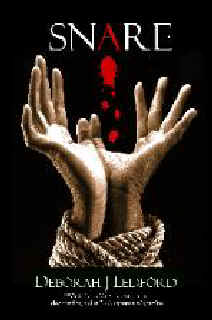 I
don't read mysteries or thrillers for the frantic pace. I read for
character and plot, which is why I don't read many thrillers. But
Deborah J. Ledfords' Snare offers a depth of character, and an
eerie feeling of atmosphere that isn't always present in thrillers.
It's tense, but, at the same time she allows the story to develop at a
natural pace, without forcing the suspense. The book deserves its
nomination for this year's Hillerman Sky Award. I
don't read mysteries or thrillers for the frantic pace. I read for
character and plot, which is why I don't read many thrillers. But
Deborah J. Ledfords' Snare offers a depth of character, and an
eerie feeling of atmosphere that isn't always present in thrillers.
It's tense, but, at the same time she allows the story to develop at a
natural pace, without forcing the suspense. The book deserves its
nomination for this year's Hillerman Sky Award.
From page one, we're drawn into the tragedy of young Katina Salvo's life
as she listens to her mother's last fight with her abusive father.
And, even at twenty-three, fifteen years later, she's fleeing from her
past. It's no wonder the successful Native American
singer/songwriter has never appeared in public. But, that's about to
change, and her first concert will be in North Carolina, where Deputy
Steven Hawk is charged with keeping her safe. It's too bad neither
Hawk nor Katina know all the reasons someone might want her dead.
Despite all precautions, Katrina and Hawk are caught in a trap the night
of the concert. When Hawk is seriously injured, something prevents a
greater tragedy, a presence they both sense. While Hawk has to recover
physically, Katrina has to recover emotionally from the events of that
night. She turns to her past, her aunt's home on the Taos Pueblo
Reservation in New Mexico for answers, and Hawk accompanies her, not
knowing if he's looking for her father or a man from the reservation who
comes and goes like a ghost. But, both of them sense that answers
will only be found there.
Ledford's novel is so much more impressive than so many thrillers, with
its depth of character. Hawk is fully developed as a black deputy,
very much aware of some feelings against him in North Carolina. At
the same time, his strong family ties gives him a grounding, a safety net
in life that Katina lacks. It's Katina's story that slowly unfolds
in the course of the story as the true tragedy of her life is told.
Ledford even tells the parallel story of Katrina's father, an ex-con who
only learns of his daughter's success after he's out of prison.
The story has an atmosphere of impending doom that hangs over the entire
book. Some of that comes from the use of nature and symbols. Ledford
shows a great respect for spiritual beliefs of Katina's people and Hawk's.
Those beliefs are essential to the story, beliefs in spirits and their
roles after death, beliefs in the messages sent by the birds and nature.
The beauty of the two settings, North Carolina and the Taos Pueblo
Reservation, are in stark contrast to the dark atmosphere hanging over
Katina's life.
With its atmosphere and strong characters, Snare is a gripping
story of a woman trapped by her past, and the past of her dead mother.
It's also the story of a lawman who chose his profession to make a
difference in his community. For once, he has to leave his life, to help a
young woman survive, and find her own community.
Deborah J. Ledford's website is www.DeborahJLedford.com
Snare by Deborah J. Ledford. Second Wind Publishing, ©2010. ISBN
9781935171577 (paperback), 325p.
lholstine@yahoo.com
book blog: http://lesasbookcritiques.blogspot.com
Twitter @LesaHolstine
"Remember, books have no calories, they last longer than a latte and
you can
enjoy them again and again. The police won't stop you if you go on a book
bender." - Elaine Viets
|
A
Poisoned Pen Press Party
January 31, 2011
Story and Photos by: Lesa Holstine Glendale Daily Planet Book
Topics Editor
Saturday evening Barbara Peters hosted a
Poisoned Pen Press Party at the Poisoned Pen bookstore in
Scottsdale, celebrating the publication of books by four of the
publishing house's authors. Donis Casey's new book is Crying
Blood. The third book by Jeffrey Siger is Prey on
Patmos. Dana Stabenow flew in from Alaska, arriving at the
airport at 4:30 for the 5:00 program. She was celebrating two
books. Though Not Dead is just out from St. Martin's Minotaur,
and Poisoned Pen Press just republished the first book in her Kate
Shugak series, A Cold Day for Murder. The program also
marked the debut of a new author, Tina Whittle, with The Dangerous
Edge of Things.
 |
| Left
to right - Dana Stabenow, Donis Casey and Barbara Peters |
It was fun to mingle and listen to audience comments before the
program. Donis Casey's latest book includes details of
butchering hogs, and one woman said she didn't think she'd be as eager
to try the recipes in this book. Frederick Ramsay, the Poisoned
Pen Press author of the Ike Schwartz mysteries told Barbara he always
shows up to see Donis. And, Deborah Ledford, author of Snare,
gave me a copy of the book, which has just been nominated for the
Hillerman Sky Award to be presented next month at Left Coast Crime to
the mystery that best represents the southwest.
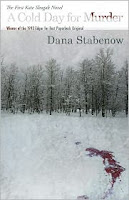
Barbara Peters kicked off the program by asking
Jeffrey Siger, "man-about-town, resident of Greece, where he
hangs out on the beach," to open the champagne. Then, she
started giving us a little background, and told us why Dana Stabenow
was included in the group. Dana's first book won the Edgar for
Best Paperback Original. The first three books in the series
only came out in paperback, and, now, eighteen years later, number two
through nine in the series are out of print. Only
that first one, A Cold Day for Murder remained in print
because it won the Edgar, and kicked off a series. But, Poisoned
Pen Press is publishing the first three books as hardcovers, and the
first one was just out.
Peters said the hardcover's introduction includes Stabenow's comments
as to how it felt to win the Edgar. Barbara said that was the
first time she met Dana. Peters, Lisa Scottoline, Nevada Barr
and Stabenow all met in the restroom. The new book also includes
a map of the Park.
Barbara went on to introduce two people from the Poisoned Pen Press
staff. Nan Beams is the person responsible for the appearance of
the books, with the blood spots on the book jackets. Peters
said people have complained that the quality of the Book News has
deteriorated since Nan and Barbara are no longer doing it. She
said Nan was her editor because even an editor needs an editor.
She also introduced Jessica Tribble, Associate Editor, saying she was
responsible for lots of things.
 |
| Tina
Whittle and Jeffrey Siger
|
She ran through a quick introduction of the
other authors, before asking each of them to speak. Peters said
we already knew Jeffrey Siger lived in and wrote about Greece. The
Dangerous Edge of Things was Tina Whittle's first novel.
The book received starred reviews from everyone. But, people
didn't know exactly how to review it. Some compared it to
Evanovich, and Peters said no. Someone else said Meg Gardner or
Karen Slaughter. Since Gardner and Slaughter are nothing like
Evanovich, it's obvious Whittle is unique.
Peters said she uses Amazon because it's the world's largest card
catalog. And, she checks to see who they're using to compare
Poisoned Pen authors. Dana hasn't had a comparison, but recently
someone said C.J. Box or another Poisoned Pen author, Steven Havill.
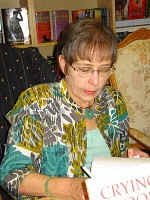 Peters herself has used Donis Casey's work when describing Ann
Parker's. She went on to say Donis' first book had the best
title they've ever published, The Old Buzzard Had It Coming.
Peters liked the second title, Hornswoggled, because it was a
word her father always used. Donis went on to write The Drop
Edge of Yonder, The Sky Took Him, and, now, Crying
Blood. Tony Hillerman was a fan. He blurbed her
books, saying her character, Alafair Tucker, reminded him of his
mother. Carolyn Hart and Margaret Maron have recently blurbed
her books.
Peters herself has used Donis Casey's work when describing Ann
Parker's. She went on to say Donis' first book had the best
title they've ever published, The Old Buzzard Had It Coming.
Peters liked the second title, Hornswoggled, because it was a
word her father always used. Donis went on to write The Drop
Edge of Yonder, The Sky Took Him, and, now, Crying
Blood. Tony Hillerman was a fan. He blurbed her
books, saying her character, Alafair Tucker, reminded him of his
mother. Carolyn Hart and Margaret Maron have recently blurbed
her books.
 Then,
she asked Jeffrey Siger to tell how they met. Jeffrey said he
was shopping his first book, Murder in Mykonos. He said
his agent wanted the book to go to a bigger house, and Jeffrey
suggested Poisoned Pen Press. The agent wanted to wait.
But, Siger insisted they send an inquiry,
and Poisoned Pen Press liked it. However, his agent tried to
kill the deal. However, Jeffrey is a lawyer, and he shut up his
agent. In the meantime, a publisher in Greece fell in love with
the book, and wanted to publish it in Greece. Poisoned Pen Press
agreed the other publisher could publish it there. Murder in
Mykonos went to #1 for English books published in Greece.
The Greek version was in the top ten. Assassins of
Athens, the second book, was also in the top ten. Prey
in Patmos hasn't been published there yet. Then,
she asked Jeffrey Siger to tell how they met. Jeffrey said he
was shopping his first book, Murder in Mykonos. He said
his agent wanted the book to go to a bigger house, and Jeffrey
suggested Poisoned Pen Press. The agent wanted to wait.
But, Siger insisted they send an inquiry,
and Poisoned Pen Press liked it. However, his agent tried to
kill the deal. However, Jeffrey is a lawyer, and he shut up his
agent. In the meantime, a publisher in Greece fell in love with
the book, and wanted to publish it in Greece. Poisoned Pen Press
agreed the other publisher could publish it there. Murder in
Mykonos went to #1 for English books published in Greece.
The Greek version was in the top ten. Assassins of
Athens, the second book, was also in the top ten. Prey
in Patmos hasn't been published there yet.
Peters said Siger is the only one who was a success in writing about
modern Greece. His books are a painful examination of the
problems in Greece. He predicted the current problems, and where
they would occur. He said if you life in Greece, you know the
problems. His current book, Prey on Patmos, deals with
a monastery in an ancient area whose financial scandal is undermining
the Greek economy. That's the beginning of the book. A
year ago, in Vanity Fair, Michael Lewis discussed that exact
same subject that Siger had already written about.
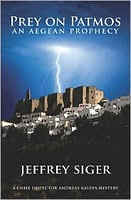 Siger's
first book dealt with sexual religious hysteria. The second, Assassins
of Athens, dealt with hubris. And this third book focused
on how the church deals with issues. They are masters of
manipulation. Prey on Patmos deals with how the church
and other people react to threats to the church. Siger's
first book dealt with sexual religious hysteria. The second, Assassins
of Athens, dealt with hubris. And this third book focused
on how the church deals with issues. They are masters of
manipulation. Prey on Patmos deals with how the church
and other people react to threats to the church.
The subheading on the book jacket says, "An Aegean
Prophecy." The English publisher, Little, Brown, liked that
with the connection to prophecies about the end of the world in 2012
and Patmos, the location where St. John wrote the Book of
Revelation. The book starts with a murder in Holy Week in
Patmos. Siger said it's prophetic, and the events surrounding
one character will come to be true some day.
Asked why an outsider can write better about a place than someone
bound to it, Siger answered that he lives in Greece for seven months a
year. He meets with politicians, crooks, and other people in the
middle of the night in bars. And, he'll only speak English with
them, so they are forced to give him the straight stuff, the essence.
He doesn't have to put up with two hours of a story.
Peters said the first book, Murder in Mykonos, had a serial
killer, someone who was irrational and emotional. Assassins of
Athens had a serial murderer. Police have a better chance
of finding that kind of killer because there is a pattern.
Jeffrey Siger is a lawyer who did well enough to retire to Greece to
write. His main character is Chief Inspector Andreas Kaldis.
Peters told Jeffrey she liked the banter he had in this book with the
woman in his life. Siger responded that Barbara Peters inspired
him. The femme fatale in this book is named Barbara.
Peters thought that was funny, saying Barbara was fun to read, and
maybe Peters will be a cougar.
Jeffrey said he has finished the next book, but doesn't know the
title. It will be "something" in Sparta. Again,
his concept is prophetic, reminiscent of recent events in Tunis.
It has to do with individuals who believe certain acts of behavior can
overturn the government. The incineration of six people in a car
at the beginning of the book is right out of the headlines. He
said he doesn't know what he's tapping into to write these stories
before they happen.
Siger's fifth book will be a straight police procedural dealing with a
secret treasure on an island in Greece. When people give gifts
to the church, where do they go?
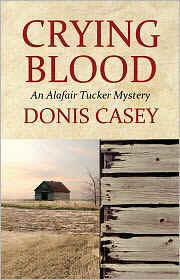 Turning
to Donis Casey, Peters told us Donis' books almost moved too fast in
time for her. She told her to slow down the time. This
one, Crying Blood, takes place only a few months after The
Sky Took Him. Turning
to Donis Casey, Peters told us Donis' books almost moved too fast in
time for her. She told her to slow down the time. This
one, Crying Blood, takes place only a few months after The
Sky Took Him.
Casey makes a departure in this one. It doesn't feature one of
the children. It revolves around Alafair Tucker's husband, Shaw.
In Sept. 1915, Shaw and the men in the family go quail hunting.
Donis said they were camping on land that had been abandoned by Shaw's
stepfather. Shaw's always melancholy in the fall. It
reminds him of the time when he was a little boy and hunted with his
father. And, in this book, he's also sad because his children
are growing up. One of the hunting dogs finds an old skeleton.
The kids think it's a great adventure, but Shaw's disturbed. He
doesn't think they should have disturbed the grave. And, then
something follows them home. There are things in the dark.
The past gets in your head, and you don't know whether it's real.
Shaw plunges into the dark after it.
Peters said this book makes you think about people who put themselves
at risk, and the people that are left behind. One of the most
powerful sentences in the book deals with Alafair preparing herself to
face life as a widow. Alafair is usually the person placing
herself at risk. But, there's a role reversal in this story. She
always threw herself into danger. The book resonates with real
emotions. Barbara said there are real emotions in all of Donis
Casey's books.
She told her she couldn't go on marrying off her daughters in every
book. Peters thought the best plot had to do with flim-flam when
Alafair went to Enid in the last book, The Sky Took Him.
Donis admitted that book wrote itself. Casey's husband is from
Enid, Oklahoma. They were visiting, and took her sister-in-law
out to lunch. On the wall in the restaurant were pictures of
Enid in 1915, including a street scene of two women going into Kraus'
Department Store. Donis knew that was Alafair and her daughter,
Martha, walking in. That was the first scene written for the
book.
Casey said she did a lot of research on oil wells and nitroglycerin
for the books. Asked if she was afraid she'd be put on a watch
list, she said that's why she did her research on nitroglycerin at the
library.
When everyone laughed, Barbara Peters said mystery authors have rich
life we don't. She said David Baldacci once was on a train, and
forgot he was in a crowd. He was on the phone talking about
murder, and the conductor came to escort him off.
She asked Jeffrey about that, and he said he was taking pictures of
the Greece National Headquarters, never thinking he was taking
pictures with men with guns watching. While working on his
second book, he had his camera in a cab, and he was surrounded by
terrorists. One man came up to the car, and demanded his camera,
and he told the taxi driver to just go. But, when he looked, there
were eight men around him. The driver explained he was a writer.
But, you get in a zone, and forget where you are.
Going back to Crying Blood, Peters said Casey's book has
lengthy descriptions of hog butchering, and Barbara told her it was
too detailed and needed to go in the Appendix. Casey said they
got so much from the hog, soap, as well as food. She said she
always has that problem. She does so much research, and has to
decide how many details to put in the book, and how much in the
appendix. She admitted after doing that much research, she wants
to put it in.
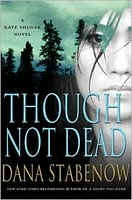 When it was Dana Stabenow's turn, they discussed her book from St.
Martin's, Though Not Dead. Dana said it's her longest
book, and her favorite. She never thought she'd write a history
of Alaska. There are three tracks in this book. A
character died at the end of the last book, and he sent Kate Shugak on
a treasure hunt. There's the Alaskan history. And, Jim,
one of her characters, has a life elsewhere in the book. And, in
one scene, a character hitches a ride with Dana's dad. She said
it's her favorite book.
When it was Dana Stabenow's turn, they discussed her book from St.
Martin's, Though Not Dead. Dana said it's her longest
book, and her favorite. She never thought she'd write a history
of Alaska. There are three tracks in this book. A
character died at the end of the last book, and he sent Kate Shugak on
a treasure hunt. There's the Alaskan history. And, Jim,
one of her characters, has a life elsewhere in the book. And, in
one scene, a character hitches a ride with Dana's dad. She said
it's her favorite book.
Tina Whittle and Barbara Peters met because Tina submitted her book to
Poisoned Pen Press. Whittle told us she was from Georgia.
She was a composition instructor at a college, and one of the
perks was that she could take classes for free. So, she took a
mystery fiction class. And, a story she wrote for that class
took first place in a short story competition. She had a great
character in that story that stayed with
her. Tina went back to teaching, and then read about stroke
victims who were unable to speak, but are
better at telling if someone is telling lies or the truth than others.
So, she paired him up with her heroine
for the short story. That pairing was the basis of The
Dangerous Edge of Things. Peters said she picked the title
from a Robert Browning poem.
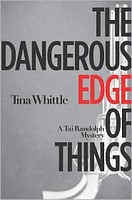 Tai
Randolph inherits a gun shop in Atlanta,
and her brother disappears. Peters said she liked
Tai, but there is a lot of interest in the male character, Trey.
Tina said he's the dangerous edge. He's traumatized and
physically broken, a broken man. But, he puts his life back
together, and he's a security guard. He thinks in black and
white. Whittle admits she finds him fascinating. She went
on to talk about events in the news recently, the shooting of
Gabrielle Giffords. She said each brain injury is different, and
each recovery is different. The brain has a remarkable way of
working around what is lost. What is the same is that someone is
not going to be the same person coming out of the injury. Tai
Randolph inherits a gun shop in Atlanta,
and her brother disappears. Peters said she liked
Tai, but there is a lot of interest in the male character, Trey.
Tina said he's the dangerous edge. He's traumatized and
physically broken, a broken man. But, he puts his life back
together, and he's a security guard. He thinks in black and
white. Whittle admits she finds him fascinating. She went
on to talk about events in the news recently, the shooting of
Gabrielle Giffords. She said each brain injury is different, and
each recovery is different. The brain has a remarkable way of
working around what is lost. What is the same is that someone is
not going to be the same person coming out of the injury.
Whittle's mystery is set in Atlanta.
She said her husband is from there, so she visited Atlanta a lot.
It's the hardest city to capture though, because it shifts identity.
Sherman set it on fire, but the citizens took the rest of the city
down. They knocked it down and created a glorious landscape.
The melting pot never took there, and it has different communities.
It's a commercial and modern city.
There's lots of history in Georgia. It was the only penal colony
in the United States, the place the British sent prisoners before they
sent them to Australia. It's the setting of Gone with the
Wind. Tina said you can set any kind of story in Atlanta.
Whittle's protagonist, Tai, bounced around in her 20s. Then she
inherited a Confederate themed gun shop. Whittle said
authenticity is important for Confederate reenactors, and lots of her
family does that. Reenactments are huge for historic purposes,
and the authenticity is important. But, the Confederacy is a
divisive part of Atlanta's history. Inheriting that shop will
change Tai's life. Tina asked, "How do you be a
liberal feminist gun shop owner? Do you want to keep the shop, or how
do you dispose of it?" The gun culture is strong, and
regional in Atlanta. There are moral and ethical issues along
with the inheritance.
Peters mentioned that Tai's missing brother is a psychiatrist, and
there are other interesting characters in the book. Whittle and
Peters agreed it's important to have strong supporting characters.
She pointed to Fred Ramsay in the audience as an example. His
Ike Schwartz books have a great group of deputies and their families.
Dana's books feature family members. Stabenow said good crime
fiction in a series is about the ensemble. You have to have it
to maintain a series. She gleefully admitted she kills off
anyone she wants to, whenever she wants to.
Peters mentioned that Left Coast Crime has an awards category this
year called the Watson, for the best sidekick. Barbara said she
nominated the dog in Dana's series, Mutt, but Mutt was beat out.
It was also pointed out that Deb Ledford, a nominee for the Hillerman
Sky Award was in the audience. Peters said she was reviewing
Deb's book, Snare, in the next Book News.
Tina said she bonded her two characters together. It was
necessary for them to work together. They both have deficits,
and they complement each other. She liked the relationship
professionally. Barbara Peters said there would be another book
in the series. She said there's nothing worse than introducing
readers to a new author, and letting them wonder if there will be a
second book.
Peters said although one series is a police procedural series set in
Athens; one series features a gun shop owner in Atlanta; the third is
set in Oklahoma at the turn of the century, and the fourth series
ranges around Alaska, they have one thing in common. They are
all about identity, who are we and how does life shift. Siger's
Andreas is resolving his life. Jeffrey said Tim Hallinan told
him, "The return to order in a broken society is the basic
underpinnings of every crime novel." He said that wasn't
original with Hallinan. Siger said mysteries are optimistic.
Barbara agreed, except for noir, where there is a spiral downward.
Someone said the quote might have originated with Agatha Christie, and
said the victim and perpetrator were both out of order, and the
sleuth's job was to restore order. Dana said Dorothy L. Sayers,
in a couple books, allowed Lord Peter and Harriet to have a discussion
whether crime fiction was worthwhile, and Lord Peter always came down
on the side that it was.
When an audience member mentioned that he had to leave soon, Peters
said she feels they owe the audience a performance and interaction,
but, after one and a half hours, she knew the chairs became butt
killers. Then, there was one final question before the book
signing. Someone mentioned the mystery writers did a good job
not giving away the endings of their books. Are you different
from other writers, such as nonfiction authors, who can reveal
everything? Dana answered for the group. She said she
hopes there is a revelation or discovery in every book. No. She
isn't going to give away the ending. You have to read the book
for yourself.
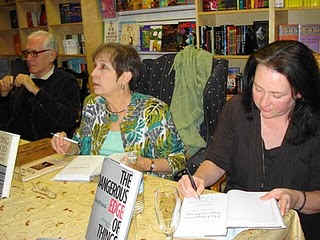 |
| Jeffrey
Siger, Donis Casey and Tina Whittle |
--
Lesa Holstine
lesa.holstine@gmail.com
|
Crying
Blood by Donis Casey
January
31, 2011
by: Lesa Holstine Glendale Daily Planet Book
Topics Editor

Tempe resident Donis Casey has taken an unusual
turn in this fifth book in her Alafair Tucker series. The
mysteries tell the story of Alafair, her husband, Shaw, and their ten
children in the early twentieth century in rural Oklahoma. Each
of the earlier books found one of Alafair's older children involved in a
murder, with the protective mother taking over in order to keep her
child from harm. And, in each book, we learn a little more about
ranch life in the 1900s from the woman's viewpoint, cooking, doing
laundry. Casey is a master at providing details that bring the
time period to life. But, Crying Blood departs from that
pattern. In this book, we see life from the male point of view,
and Shaw takes center stage. Fans of this series should be very
pleased to get to know the husband and father of the Tucker family as he
becomes the sleuth.
Shaw, his two sons, his brother, and his sons, went hunting in the fall
of 1915 on property that belonged to Shaw's stepfather. But, the
first day they flushed quail, one of the dogs returned with a boot with
bones in it. When they followed the dog to the burial site, they
found a body, shot in the head. And, Shaw, for some reason he
didn't understand himself, took a snake necklace from the site.
That night, while the others slept, Shaw saw moccasins outside the tent,
and heard his name called. He didn't find anyone. The next
day, after reporting to the sheriff, the men went home early, but
someone followed them. And, Shaw remained uneasy, questioning his
stepfather, only to hear that the land was haunted, and they stay away
from it.
Trying to forget about that body isn't too hard, when there is
butchering to do for the winter, and Casey does her usual excellent job
of providing the details of everyday life. But, that night, after
the first day of butchering and preparing meat, someone takes a hunk out
of one of the hogs. Shaw tracks the thief, returning home with a
young Indian boy of 15, who tells a story of a white haired man who
murdered his brother. Before Shaw can learn more, the boy he
thought was called Crying Blood is murdered in the barn that night.
Shaw suggests Alafair accompany his cousin, the sheriff, to find the
minister who raised the boy, while he, unbeknownst to Alafair, sets out
to avenge the boy's death.
Donis Casey excels at the details of ordinary life in Oklahoma.
She's told us stories of doing laundry, cooking for a large family,
preparing for a funeral. Now, she gives us hunting trips,
butchering hogs, and preparing the meat, along with breeding horses.
And, she puts Shaw, the son of a Cherokee mother, on the trail of a
killer, in a story about the Indians and land claims in Oklahoma.
Crying Blood is a fascinating glimpse into the past, and, for a change,
into the life of Shaw Tucker.
Donis Casey's website is http://www.doniscasey.com/
Crying Blood by Donis Casey. Poisoned Pen Press, ©2011. ISBN
9781590588314 (hardcover), 250p.
|
Susan
Pohlman - Authors @ The Teague From January 22, 2011
Story and Photo by: Lesa Holstine Glendale Daily Planet Book
Topics Editor
Susan Pohlman, author of Halfway to
Each Other: How a Year in Italy Brought Our Family Home, is
one of the most inspirational authors I've ever heard. Her
program for Authors @ The Teague was a treat.
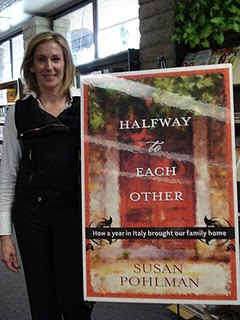 Pohlman
said she didn't expect any of those experiences to happen to her,
from the story in the book, to writing the book, so she was just
going to speak from her heart. She and her family were
living in Los Angeles. Her husband was in the radio
business. They had been married for sixteen years, together
for five before that. They had two kids, and their marriage
had just run its course. There comes a time in so many
marriages when they've just run its course. And, that hurt.
Susan was a teacher who devoted her life to supporting families.
So, she was heartbroken, but, without telling her husband, Tim,
she went to a lawyer. Pohlman
said she didn't expect any of those experiences to happen to her,
from the story in the book, to writing the book, so she was just
going to speak from her heart. She and her family were
living in Los Angeles. Her husband was in the radio
business. They had been married for sixteen years, together
for five before that. They had two kids, and their marriage
had just run its course. There comes a time in so many
marriages when they've just run its course. And, that hurt.
Susan was a teacher who devoted her life to supporting families.
So, she was heartbroken, but, without telling her husband, Tim,
she went to a lawyer.
Then her husband came home and asked if she
wanted to go with him on an incentive trip to Italy. Before
the economy went bad, radio and TV stations offered incentive
trips. If you spent X amount of money, you'd be taken on a
trip. So, they would be entertaining clients on this trip.
Susan didn't think it was a good idea to go on the trip with
things falling apart. But, her husband kept pushing, and at
the last minute she decided she could suffer through Italy and go
on the last trip. They were taking forty clients for six
days. They arrived in Florence, and it just knocked her
sideways; it was so beautiful. There was something spiritual
about it with the ancient streets and building, and the artwork.
Pohlman said she was overwhelmed at feeling
so alive. In LA, you can get caught up in all the nonsense,
and lose your soul. But, she was knocked off her axis in
Florence. Tim felt the same way. On day four, they
went to Liguria in northwestern Italy. It's a tiny area, and
they were in the town of Santa Margherita. It was a free
day, and Tim and Susan had to spend the day together. They
planned to rent Vespas, but when they arrived at the Vespa store,
it never opened. So, they walked back along the water, and
Tim said, "I could live here," and, she agreed, and
thought, but not together. And, he repeated, "No, I
could REALLY live here," with a look in his eyes that said
let's move her. Susan said that's not a good idea, but he
wouldn't let up. They had a conversation, asking what
happened to us. He said he would quit his job if she'd
consider it. She knew how serious he was because he was in
his early 40s, in charge of six radio stations, what he'd worked
for his entire life. So, she said, if there's an American
school, I'll consider it.
They headed to Genoa, the largest city in
the area, a very Italian city. They found the American
school, and the principal was even there that late in the day.
He said they were really crowded, but when he heard their children
were 11 and 15 at the time, he said, what a coincidence.
Those were the only two classes with openings. So Tim and
Susan agreed they only had one day to find a place to live.
If they could do that, they would move there. There's only
one realtor for the area, and the realtor said there was one
apartment, but they couldn't see it until 5 at night. And,
the whole time, Susan's mind was saying no, but her heart was
saying yes. It was a very spiritual moment. When they
arrived at the apartment, they found a seven-story building with a
very tiny elevator. And, Susan said, if it's a dump, we're
not staying. They agreed, if it wasn't a dump, they'd stay.
And, all along she thought it's going to be a dump. The
apartment was on the top floor, and when they stepped in, they
were hit by a wall of glass overlooking the Ligurian Sea, just a
beautiful place with wooden floors. So, they agreed they'd
have to do this. Against all intelligence, Susan Pohlman
signed her name to a lease in Italian that she couldn't read.
She was forty-four. Her family was falling apart. The
stress of his job was killing her husband. And, they decided
to take a risk.
They went back to LA. Susan's husband
quit his job. They sold their house (at a time when houses
still sold), and sold other stuff. That's what they lived
on. Within eight weeks, they had packed up their kids, Katie
and Matt, and were living in Italy. They decided to put
their lives in God's hands, and see what happened. They
experienced adventure and the Italian culture. Tim and Susan
didn't work for a year, and when school started the kids were in
school. They saved their family, and renewed their marriage.
This was in 2003, the same year Elizabeth
Gilbert was there working on Eat, Pray, Love. That
was the summer there was a heat wave, and thousands of people died
in Europe. They were all hot and sweat. They had two
kids with them. They were all displaced and didn't speak the
language. They put all the pettiness aside, and built a home
again. They travelled extensively, but never took the kids
out of school. The kids blossomed there. They had no
car. And, the kids developed a deep friendship, something
that might not have happened in this country with the two of them
in different schools, different sports, and going different
directions.
Pohlman said they had the emotional space
there to start over, and they found each other. Americans
live exhausting lives. But, the Pohlmans ran out of money
eventually. They couldn't work there, so they came back to
LA. It was a harder transition coming back to our culture
than it was going there. But, they started over, and did it
peacefully, after seeing the downside of abundance. In a
nutshell, that's what the book, Halfway to Each Other, is
about. The book ends the day they leave Italy.
Asked how the book came about, Pohlman said
before they went to Italy, she had been learning to write
screenplays. She studied it, and how to write scenes.
One girlfriend told her not to go, that it was a big mistake.
But, others asked her to write and tell them what it was like,
with no holds barred. So, Susan wrote to her friends,
telling about moments, and writing them in scenes. Soon she
had a little following. The family arrived in Italy in July.
In November, a friend who worked for the Washington Times
wrote, saying he thought she should quit sending the scenes
because she just might have a book. So, she kept writing
those series of moments. When she finished writing, she
tried to find an agent, which is like trying to find a needle in a
haystack. When she did, the agent tried to sell it, but it
was hard to sell after Eat, Pray, Love.
The book has finally started taking off a
little because it's striking a chord. People are struggling
in this economy. Families are struggling, and people are
losing everything. They are finding great hopefulness in
this story.
Asked about her daughter, who didn't want to
leave Italy at the end of the book, Susan reminded us that Katie
was fifteen when they got there in July. By the end of
October, she was settled in with friends. She just
blossomed, turning into a woman. With the buses and trains,
she could travel without her mother driving. She had friends
from all over. For the first time, she had relationships not
based on social pressure. There was no materialism in those
friendships, just young people having fun.
It was hard for Katie when they got back.
They immediately put her into school, and it was the same culture
as when they left. She was in a school with kids with lots
of money. And, they were mean girls. Katie was now a
junior, and everyone was mean to her. So, they moved her to
a larger school, with a more diverse population, and it clicked.
She's twenty-two now, living in San Francisco. She's going
to be a teacher, and she minored in Italian. She's going to
bring a global view to her classroom.
Matthew was the easygoing one, so he was
happy to be anywhere. He's going to be attending Ohio State.
They had returned home, and neither Tim nor
Susan had jobs. Tim said he'd like to start his own
business. It would take the last of their savings, but Susan
said she'd learned the secret to surrendering. Within six
months, he had a partner, and bought two radio stations in
Phoenix, and two in Las Vegas. She got a job as an assistant
principal. And, then it started all over again. Tim
was never home, since he had to travel. So, she said, they
needed to honor their family, and move to one of the markets.
They moved to this area, but he eventually lost the business as
the economy went to hell. So, here they were in Arizona, and
neither of them had jobs. But, now Tim runs the three CBS
radio stations here. She said she wouldn't have changed it
all all. They like it here in Arizona.
Asked if they've been back, Susan said they
can't stay away. They've been back to Italy three times.
They took clients. Katie went to school in Florence, and
they went then. They still know people there. Facebook
and Skype has helped, and they remain friends.
When she was asked if they picked up the
language, Pohlman said somewhat by the time they left. She
found it hard. It took a while to pick up enough to
understand. The kids had it in school, so it was easier for
them. Susan still couldn't really learn it. She said
she could understand and use nouns. It's a tough language.
One question was about health care.
She said they have socialized health care, so you can go right to
the hospital and they'll take care of you. Her daughter got
sick, and they took care of her. But, there are private
clinics, too, where they speak English. And, doctors still
make housecalls. When Matt ran a high fever, the doctor came
to the house with his little black bag.
One couple was particularly interested in
going to Italy, so Pohlman recommended Untour.com, a company her
parents use. It covers the hidden infrastructure. It
finds you a place to live, a car, the what happens if. It's
a safety net while you stay in another country.
Asked what next, Pohlman said they're going
to be empty nesters with their son going to college. She's
writing another book. She's developed her voice. And,
she thinks she's more savvy about the marketplace. Marketing
her book is the hardest thing she's ever done. And, she
knows she has to look at evergreen topics. So, she's found a
topic that people want. Pohlman just turned fifty.
It's a transition. So, she's writing about it. It's a
topic that should be attractive to book buyers.
Susan said they stay the same place
everytime they go back to Italy. They learned to relax about
life. Here, we worry about wasting time. There, she
learned not to mind about wasting time. It was important
just to be there, and live that life.
She admitted the only thing she would have
done differently was probably learn the language a little earlier
before going, but they only had eight weeks to get ready, so there
really wasn't time.
Susan Pohlman had an important message for
closing. "If you have an adventure in your heart, DO
IT!"
You never know who will be at
AUTHORS AT THE TEAGUE!
|
Halfway to
Each Other by Susan Pohlman
Authors
@ The Teague on Saturday, January 22
By Lesa
Holstine Glendale Daily Planet Book Topics Editor
 I
originally picked up Susan Pohlman's Halfway to Each
Other because her story intrigued me, and she's
appearing for Authors @ The Teague on Jan. 22.
But, I wasn't too far into the book when I fell for her
beautiful writing, and began to care deeply about her
family. Susan Pohlman's memoir is a
thoughtful, poignant look back at the year she and her
family spent in Italy, a trip to save a marriage, a
family, and to find a lost faith. I
originally picked up Susan Pohlman's Halfway to Each
Other because her story intrigued me, and she's
appearing for Authors @ The Teague on Jan. 22.
But, I wasn't too far into the book when I fell for her
beautiful writing, and began to care deeply about her
family. Susan Pohlman's memoir is a
thoughtful, poignant look back at the year she and her
family spent in Italy, a trip to save a marriage, a
family, and to find a lost faith.
After
eighteen years of marriage, Susan and Tim Pohlman were
on the verge of divorce. Tim was a
successful radio executive, though, who took potential
clients on trips, including a trip to Italy. As a
dutiful wife, Susan went along, thinking it would be
their last trip together. But, together, the two
fell in love with Italy, and made a rash decision to
sell everything, pack up their two kids, and move to
Genoa for a year to try to salvage their family.
The woman who had married to the Gospel passage from
Matthew 6:25-34 about reliance upon God, and how he
would take care of us as well as he took care of the
lilies of the field, had lost faith. So, for one
last time, she decided to listen to God's voice, and try
to find the faith that her marriage and her family would
survive.
In the time
before Katie, 14, and Matt, 11, started school at the
American International School, the Pohlmans found
themselves relying on each other for companionship,
spending all of their time together. They
experienced a great deal of culture shock, from
differences in shopping to riding buses. But, they
came together as a family to solve problems.
And, once Katie and Matt started school, Tim and Susan
had days to themselves to travel, and learn to enjoy
each other all over again.
Pohlman's
book is the story of a year in a beautiful country, a
place where the family learned to relax, and listen to
each other. But, she doesn't gloss over the
difficulties. The children had a hard time at
first, and then a hard time leaving. Tim and Susan
took their problems with them to Italy, and had to learn
to talk to each other. But, they took their faith,
and their hope for their future, and tried one last time
to make it work.
I love
doorways. I even take pictures of doorways, of the
possibilities and secrets behind them. So, the
cover of Susan Pohlman's book drew me in. Halfway
to Each Other: How a Year in Italy Brought Our Family
Home is everything that cover promises.
It's a journey into someone's life, a strange world
behind that door. It's a beautiful memoir, and,
unlike so many popular stories, it has a happy ending.
Readers who enjoy travel memoirs might want to pick this
one up. And, you might want to join us for Authors
@ The Teague on Saturday, January 22 at 2 PM at the
Velma Teague Library.
Halfway to
Each Other: How a Year in Italy Brought Our Family Home
by Susan Pohlman. Guideposts, ©2009. ISBN 9780824947804
(hardcover), 272p.
|
|
|
|
.
Arizona Mystery
Author Donis Casey
Is “Crying
Blood” at the Library Feb. 26
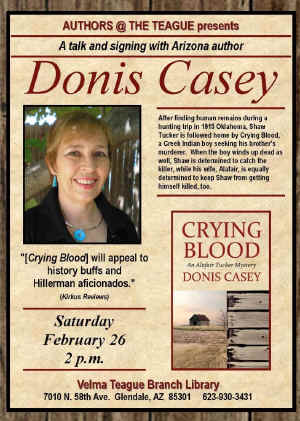
GLENDALE,
Ariz. – Arizona author
Donis Casey will discuss and sign her fifth Alafair Tucker mystery,
“Crying Blood,” during the upcoming Authors @ the Teague event
at 2 p.m. on Saturday, February 26, at Velma Teague Branch Library,
7010 N. 58th Ave.
After finding human remains during a hunting trip in 1915
Oklahoma, Shaw Tucker is followed home by Crying Blood, a Creek
Indian boy seeking his brother’s murderer. When the boy winds up dead as well, Shaw is determined to
catch the killer, while his wife, Alafair, is equally determined to
keep Shaw from getting himself killed too.
A fascinating, authentic account of turn-of-the-century farm
life and Native American history, “[this book] will appeal to
history buffs and Hillerman aficionados.” (“Kirkus Reviews”)
Originally a
third-generation farm girl from Tulsa, Oklahoma, Casey worked as an
academic librarian and a shopkeeper before becoming a full-time
writer. She and her
husband now live in Tempe. For
more information, see http://www.doniscasey.com.
The
program is free. Books
will be available for purchase and signing.
For more information, please call 623-930-3439.
|
|

 Dietrich
wrote nonfiction to make a living, books about the
Columbia River, plants. But, he had a hankering to do
fiction. He covered science for the Seattle Times,
and had been to Antarctica twice under the auspices of
the National Science Foundation. He wanted to write
about it. The Nazis had sent an expedition to
Antarctica before World War II. They wanted to claim a
piece of it for Germany. They hoped to get sperm whale
oil for fighter engines, because it was the best oil.
That was the kernel of Bill's first novel, Ice
Reich. It went from Alaska to Germany to
Antarctica.
Dietrich
wrote nonfiction to make a living, books about the
Columbia River, plants. But, he had a hankering to do
fiction. He covered science for the Seattle Times,
and had been to Antarctica twice under the auspices of
the National Science Foundation. He wanted to write
about it. The Nazis had sent an expedition to
Antarctica before World War II. They wanted to claim a
piece of it for Germany. They hoped to get sperm whale
oil for fighter engines, because it was the best oil.
That was the kernel of Bill's first novel, Ice
Reich. It went from Alaska to Germany to
Antarctica.
 Bill
told us Heinreich Himmler was the second most powerful
man in German. He was also a mystic, and a romantic.
He was a fan of King Arthur, and thought he himself
was the reincarnation of a medieval king. There seemed
to be a connection between Germany and Tibet because
the swastika was based on the Hindu and Buddhist
symbol of good luck. In Blood of the Reich, he
sends a research team of SS men to Tibet to test his
wacky theories.
Bill
told us Heinreich Himmler was the second most powerful
man in German. He was also a mystic, and a romantic.
He was a fan of King Arthur, and thought he himself
was the reincarnation of a medieval king. There seemed
to be a connection between Germany and Tibet because
the swastika was based on the Hindu and Buddhist
symbol of good luck. In Blood of the Reich, he
sends a research team of SS men to Tibet to test his
wacky theories.
























































 The
DVD has two thirty minute lessons, “A Day
with the Dinosaurs” and “Reach for the
Stars”.
The
DVD has two thirty minute lessons, “A Day
with the Dinosaurs” and “Reach for the
Stars”.
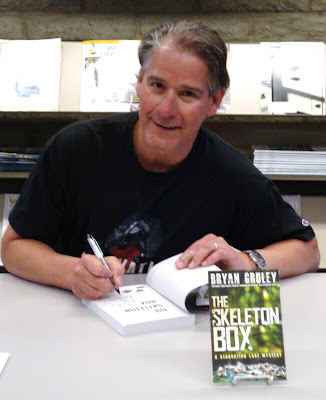
 Then,
he started his program with a story designed to win the heart of any
librarian or book lover. He said he seldom read to the audience, but he
was going to read to us from a favorite book. He said, this is The
Crisscross Shadow by Franklin W. Dixon, an author you might recognize.
This is a Hardy Boys mystery. Bryan highlighted this book as an important
book in his life. He grew up in a blue collar suburb of Detroit. He was
over at a friend's house, and the friend was going on and on about this
book he read, and the villain named Brett. Bryan thought in order to be
cool, he'd have to read the book. So, he asked his mom for the book. It
was probably the first chapter book he ever read. Bryan was enamored of
the Hardy Boys. He even made up his own version, the Anderson twins. He
wrote and illustrated them, and then read them to the second grade class.
His mother encouraged him to write. She also knew he was a hot dog, and
liked to have the attention on him. So, by eight or nine Bryan knew he
wanted to write.
Then,
he started his program with a story designed to win the heart of any
librarian or book lover. He said he seldom read to the audience, but he
was going to read to us from a favorite book. He said, this is The
Crisscross Shadow by Franklin W. Dixon, an author you might recognize.
This is a Hardy Boys mystery. Bryan highlighted this book as an important
book in his life. He grew up in a blue collar suburb of Detroit. He was
over at a friend's house, and the friend was going on and on about this
book he read, and the villain named Brett. Bryan thought in order to be
cool, he'd have to read the book. So, he asked his mom for the book. It
was probably the first chapter book he ever read. Bryan was enamored of
the Hardy Boys. He even made up his own version, the Anderson twins. He
wrote and illustrated them, and then read them to the second grade class.
His mother encouraged him to write. She also knew he was a hot dog, and
liked to have the attention on him. So, by eight or nine Bryan knew he
wanted to write. Starvation
Lake came out in 2009. It deals with the death of a hockey coach
relating to a snowmobile accident. Years later, the snowmobile parts who
up, in a different lake in which it supposedly went down.
Starvation
Lake came out in 2009. It deals with the death of a hockey coach
relating to a snowmobile accident. Years later, the snowmobile parts who
up, in a different lake in which it supposedly went down. Once
Bryan's characters have names they come to life. He named the victim
Gracie McBride. She was found hanging in a shoe tree. Why did it matter to
Gus? She was his second cousin. She was also Darlene's best friend.
Darlene is Gus' on-again, off-again girlfriend. And, Gracie had been
fooling around with Soupy, the greatest hockey player ever to come out of
Starvation Lake. He threw his career away on drugs and drinking. He is
also Gus' best friend. That became The Hanging Tree, which has been
optioned for a movie.
Once
Bryan's characters have names they come to life. He named the victim
Gracie McBride. She was found hanging in a shoe tree. Why did it matter to
Gus? She was his second cousin. She was also Darlene's best friend.
Darlene is Gus' on-again, off-again girlfriend. And, Gracie had been
fooling around with Soupy, the greatest hockey player ever to come out of
Starvation Lake. He threw his career away on drugs and drinking. He is
also Gus' best friend. That became The Hanging Tree, which has been
optioned for a movie. This
image got Bryan going. The Skeleton Box, his latest book, is set in
March 2000. Starvation Lake was set in 1998, and The Hanging
Tree in 1999. This book starts with a series of burglaries. The
newspaper calls them "Bingo Night Break-Ins" because someone
knew the people would be out playing bingo. What was odd is that they
didn't take anything, but went through the houses, as if looking for
something. There were four or five burglaries, and then one burglary went
bad. Darlene's mother was murdered. She was the best friend of Gus'
mother, Bea. Darlene's mother died in Bea's house, and Gus has to look
into it.
This
image got Bryan going. The Skeleton Box, his latest book, is set in
March 2000. Starvation Lake was set in 1998, and The Hanging
Tree in 1999. This book starts with a series of burglaries. The
newspaper calls them "Bingo Night Break-Ins" because someone
knew the people would be out playing bingo. What was odd is that they
didn't take anything, but went through the houses, as if looking for
something. There were four or five burglaries, and then one burglary went
bad. Darlene's mother was murdered. She was the best friend of Gus'
mother, Bea. Darlene's mother died in Bea's house, and Gus has to look
into it.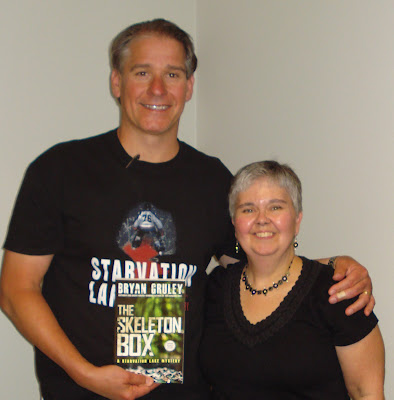




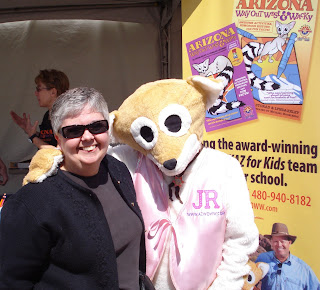



 Rhys said she and
Cara also see the same things in the universe. Last year, Bowen's Molly
Murphy book, Bless the Bride, came out, and it was set in New
York's Chinatown. Cara's new book is set in a Parisian Chinatown. Rhys is
anxious to see how the experiences compare.
Rhys said she and
Cara also see the same things in the universe. Last year, Bowen's Molly
Murphy book, Bless the Bride, came out, and it was set in New
York's Chinatown. Cara's new book is set in a Parisian Chinatown. Rhys is
anxious to see how the experiences compare. Rhys
said she's lucky to use the various environments of New York for her
books. She can explore the deep dark parts of the city, such as opium
dens, for one book. Then, she set this year's book in what she calls New
York's Downton Abbey. The cottages in Newport, Rhode Island were
actually summer palaces for families such as the Astors and Vanderbilts.
They were fabulous homes, without many bedrooms. They enjoyed parties, but
didn't want people to spend the night. Those mansions, used only for six
weeks or so in the summer, are all along a spit of land in Newsport.
Rhys
said she's lucky to use the various environments of New York for her
books. She can explore the deep dark parts of the city, such as opium
dens, for one book. Then, she set this year's book in what she calls New
York's Downton Abbey. The cottages in Newport, Rhode Island were
actually summer palaces for families such as the Astors and Vanderbilts.
They were fabulous homes, without many bedrooms. They enjoyed parties, but
didn't want people to spend the night. Those mansions, used only for six
weeks or so in the summer, are all along a spit of land in Newsport. Cara Black joked
that she always follows Rhys. In her latest Aimée Leduc Investigations, Murder
at the Lanterne Rouge, Aimée is finally back in the Marais. Marais,
which means marsh in French, was once a swamp until it was drained for
houses for the aristocrats. The fourth and third
Cara Black joked
that she always follows Rhys. In her latest Aimée Leduc Investigations, Murder
at the Lanterne Rouge, Aimée is finally back in the Marais. Marais,
which means marsh in French, was once a swamp until it was drained for
houses for the aristocrats. The fourth and third  Hellmann did an
enormous amount of research about the Iranian Revolution. She said the
mystery community is very close and supportive. She put out the word that
she was looking for Iranian-Americans who were there during the
revolution, and within a few weeks, had contact information for five of
them. One was a woman from Cara's book group. She had such an intriguing
story that Libby used some of that in A Bitter Veil. She had her
vet the manuscript to make sure it was right. Her publisher had it vetted
again, and then they had someone check on the pronunciation to ensure it
was right for the audio.
Hellmann did an
enormous amount of research about the Iranian Revolution. She said the
mystery community is very close and supportive. She put out the word that
she was looking for Iranian-Americans who were there during the
revolution, and within a few weeks, had contact information for five of
them. One was a woman from Cara's book group. She had such an intriguing
story that Libby used some of that in A Bitter Veil. She had her
vet the manuscript to make sure it was right. Her publisher had it vetted
again, and then they had someone check on the pronunciation to ensure it
was right for the audio. In
Murphy's Law, Molly accidentally kills the man, the son of the
landowner, who was trying to rape her. She flees, taking another woman's
name. But, when she gets to Ellis Island, there is a murder, and that name
is the name of the prime suspect. When she set it in Manhattan, she
thought I've just committed myself to doing research for every book for
the rest of my life because she didn't know New York history. Hush Now,
Don't You Cry is the eleventh book in the series. Molly is four years
older, a little wiser. She just got married. She's still imprudent,
though, and doesn't think things through.
In
Murphy's Law, Molly accidentally kills the man, the son of the
landowner, who was trying to rape her. She flees, taking another woman's
name. But, when she gets to Ellis Island, there is a murder, and that name
is the name of the prime suspect. When she set it in Manhattan, she
thought I've just committed myself to doing research for every book for
the rest of my life because she didn't know New York history. Hush Now,
Don't You Cry is the eleventh book in the series. Molly is four years
older, a little wiser. She just got married. She's still imprudent,
though, and doesn't think things through. Ten
years later, Cara was in France with her family. She put her son to bed,
and walked down the street, thinking what would these cobblestones say.
What would have you done to survive? It took her three and a half years to
write the first
Ten
years later, Cara was in France with her family. She put her son to bed,
and walked down the street, thinking what would these cobblestones say.
What would have you done to survive? It took her three and a half years to
write the first 
 I've
never been to Paris, but every time I read one of Cara Black's Aimée
Leduc Investigations, I feel immersed in the city and the culture. The
stories are rich with detail, dense, complicated mysteries in which
Paris comes to life. In Murder at the Lanterne Rouge, Black takes
us into one of the four Chinatowns in the city in January 1998.
I've
never been to Paris, but every time I read one of Cara Black's Aimée
Leduc Investigations, I feel immersed in the city and the culture. The
stories are rich with detail, dense, complicated mysteries in which
Paris comes to life. In Murder at the Lanterne Rouge, Black takes
us into one of the four Chinatowns in the city in January 1998.
 On
the jacket of Betty Webb's latest Lena Jones mystery, Desert Wind,
David Morrell is quoted as saying, "A must-read." It is. Webb
has tackled tough subjects before, everything from polygamy to genital
mutilation on young girls, but Desert Wind may be her most
controversial and powerful book yet. It's a book that should scare
everyone living in the Southwest.
On
the jacket of Betty Webb's latest Lena Jones mystery, Desert Wind,
David Morrell is quoted as saying, "A must-read." It is. Webb
has tackled tough subjects before, everything from polygamy to genital
mutilation on young girls, but Desert Wind may be her most
controversial and powerful book yet. It's a book that should scare
everyone living in the Southwest.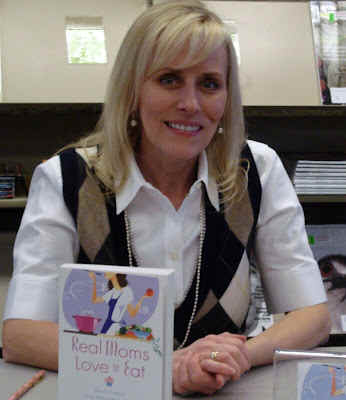
 Aldrich's
book contains a ten part plan to help people have a love affair with food,
yet still lose weight or maintain the weight they want to be. The book's
content will help readers enjoy food, but not become caught up in the
food.
Aldrich's
book contains a ten part plan to help people have a love affair with food,
yet still lose weight or maintain the weight they want to be. The book's
content will help readers enjoy food, but not become caught up in the
food.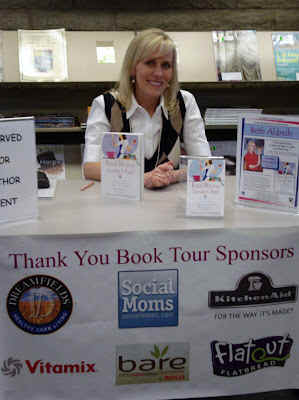

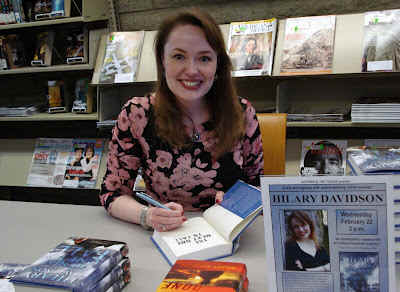




 Author
Rebecca Cantrell is right. When Jeri Westerson appears for an author
event, she brings cool toys. She recently appeared for Authors @ The
Teague on her Troubled Bones tour. Anyone who wanted to handle
her medieval weapons was welcome to try them out. Jeri does a terrific
program, fun and informative.
Author
Rebecca Cantrell is right. When Jeri Westerson appears for an author
event, she brings cool toys. She recently appeared for Authors @ The
Teague on her Troubled Bones tour. Anyone who wanted to handle
her medieval weapons was welcome to try them out. Jeri does a terrific
program, fun and informative.

 London
becomes another character in Westerson’s books. Each book deals with
a religious relic or venerated object. Troubled Bones, the
latest book, deals with relics at Canterbury Cathedral, the bones of
Thomas à Becket. Crispin got in some trouble in London, and the
sheriff offered him options, go to jail or do a job for the Archbishop
of Canterbury. So, Guest agreed to guard the bones of Thomas à
Becket. The Archbishop was afraid the Lollards would steal them.
Lollards were members of a reformist movement, and they didn’t
believe in relics. While Crispin was in the cathedral, a pilgrim was
murdered.
London
becomes another character in Westerson’s books. Each book deals with
a religious relic or venerated object. Troubled Bones, the
latest book, deals with relics at Canterbury Cathedral, the bones of
Thomas à Becket. Crispin got in some trouble in London, and the
sheriff offered him options, go to jail or do a job for the Archbishop
of Canterbury. So, Guest agreed to guard the bones of Thomas à
Becket. The Archbishop was afraid the Lollards would steal them.
Lollards were members of a reformist movement, and they didn’t
believe in relics. While Crispin was in the cathedral, a pilgrim was
murdered.
 When
Westerson was young, her parents took the family to lots of museums.
For a family of five, it was cheap entertainment because admission was
free. One they visited was the Huntington Library. It had a Gutenberg
Bible. There was one of Shakespeare’s quartos, and one of his bad
quartos. And, there was the Ellesmere Manuscript. It was commissioned
after Chaucer’s death. It was written by hand, and contains
illustrations of all the pilgrims and Chaucer.
When
Westerson was young, her parents took the family to lots of museums.
For a family of five, it was cheap entertainment because admission was
free. One they visited was the Huntington Library. It had a Gutenberg
Bible. There was one of Shakespeare’s quartos, and one of his bad
quartos. And, there was the Ellesmere Manuscript. It was commissioned
after Chaucer’s death. It was written by hand, and contains
illustrations of all the pilgrims and Chaucer.
 Thomas
à Becket was murdered in Canterbury Cathedral. At one time, he was
King Henry II's best friend. Henry II was the father of Richard the
Lionheart and King John. Becket was Chancellor of England. Henry II
had a problem with the Church. He wanted to try clerics in court, and
the Archbishop of Canterbury told him no. They had to be tried in
Church courts. Then, the Archbishop died, and Henry seized the
opportunity. He had Thomas made Archbishop, even though he wasn’t a
priest.
Thomas
à Becket was murdered in Canterbury Cathedral. At one time, he was
King Henry II's best friend. Henry II was the father of Richard the
Lionheart and King John. Becket was Chancellor of England. Henry II
had a problem with the Church. He wanted to try clerics in court, and
the Archbishop of Canterbury told him no. They had to be tried in
Church courts. Then, the Archbishop died, and Henry seized the
opportunity. He had Thomas made Archbishop, even though he wasn’t a
priest.

 Jeri
Westerson's next book, Blood Lance, has jousting in it. She'll
have a powerpoint in which she’s on a 2000 pound Percheron dressed
as a knight. It’s hard to see with the helm. But, the knight on that
horse would plow through foot soldiers.
Jeri
Westerson's next book, Blood Lance, has jousting in it. She'll
have a powerpoint in which she’s on a 2000 pound Percheron dressed
as a knight. It’s hard to see with the helm. But, the knight on that
horse would plow through foot soldiers.



 Roni
kicked off the program saying Desert Sleuths is the state-wide Sisters
in Crime chapter for Arizona. Sisters in Crime was started twenty-five
years ago to promote the work of women crime writers. Sara Paretsky
and the other founders saw a discrepancy in the treatment of female
writers. Today, the group consists of authors, readers, and people who
love both.
Roni
kicked off the program saying Desert Sleuths is the state-wide Sisters
in Crime chapter for Arizona. Sisters in Crime was started twenty-five
years ago to promote the work of women crime writers. Sara Paretsky
and the other founders saw a discrepancy in the treatment of female
writers. Today, the group consists of authors, readers, and people who
love both.








 Who
wouldn't like a mystery that features cupcakes? I'll admit there are a
number of reasons I enjoy Jenn McKinlay's Cupcake Bakery mysteries.
They're set in Scottsdale, Arizona, and I recognize a number of the
sites in the books. It's hard to resist all those recipes for cupcakes.
It’s fun to watch the three protagonists challenge each other to movie
quotes. I know and like Jenn, a fellow librarian. But, the best
reason to read her third book in this series, Death by the Dozen?
It’s the best yet, with great characters, and a terrific, tightly
written plot.
Who
wouldn't like a mystery that features cupcakes? I'll admit there are a
number of reasons I enjoy Jenn McKinlay's Cupcake Bakery mysteries.
They're set in Scottsdale, Arizona, and I recognize a number of the
sites in the books. It's hard to resist all those recipes for cupcakes.
It’s fun to watch the three protagonists challenge each other to movie
quotes. I know and like Jenn, a fellow librarian. But, the best
reason to read her third book in this series, Death by the Dozen?
It’s the best yet, with great characters, and a terrific, tightly
written plot.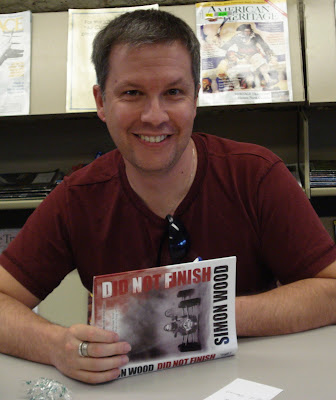


 All
of Simon Wood's books have been standalones until now. Did Not Finish
is the first in a series. It's set in the racing world. Racing is
expensive, and people are willing to compromise. It's a competitive
world with rule-bending. Dick Francis took readers into the world of
horse racing. This series is an inside point of view of motor sports.
All
of Simon Wood's books have been standalones until now. Did Not Finish
is the first in a series. It's set in the racing world. Racing is
expensive, and people are willing to compromise. It's a competitive
world with rule-bending. Dick Francis took readers into the world of
horse racing. This series is an inside point of view of motor sports.
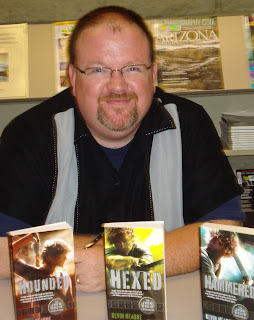
 Kevin
said the first three books came out so fast it was bewildering.
That’s how quickly books can come out in a series. Hounded was
accepted in 2009, but the publishers wanted two more books to be
published right away. Hearne had to write two more books in one year
to meet the schedule. But, the publishers (Del Rey) thought it was
better to get three books on the shelf immediately, so readers could
dive right in, and really get involved. There were seven months
between the books. The fourth book, Tricked, is due out in April.
Kevin has started the fifth, Trapped. That’s due in Dec. 2012. The
sixth book will be Hunted.
Kevin
said the first three books came out so fast it was bewildering.
That’s how quickly books can come out in a series. Hounded was
accepted in 2009, but the publishers wanted two more books to be
published right away. Hearne had to write two more books in one year
to meet the schedule. But, the publishers (Del Rey) thought it was
better to get three books on the shelf immediately, so readers could
dive right in, and really get involved. There were seven months
between the books. The fourth book, Tricked, is due out in April.
Kevin has started the fifth, Trapped. That’s due in Dec. 2012. The
sixth book will be Hunted.
 In
Hexed, there were numerous languages used. Hearne was lucky in that he
had native speakers to consult from Poland and Germany. He had a
German exchange student a the school who told him how to say things.
And, he had a fellow from Germany who he corresponded with. He wanted
to know how to curse in German, but then it wasn’t used.
In
Hexed, there were numerous languages used. Hearne was lucky in that he
had native speakers to consult from Poland and Germany. He had a
German exchange student a the school who told him how to say things.
And, he had a fellow from Germany who he corresponded with. He wanted
to know how to curse in German, but then it wasn’t used.
 Atticus
wears an Iron necklace he uses for protection. Hearne was asked where
the inspiration for that came from. He said he built it backwards. He
wanted to write a book about a man and his dog, and he wanted them to
communicate telepathically. How much easier would it be if you could
tell your dog what to do mentally? So, he created Atticus and Oberon.
His research indicated a Druid might be the type of magical being who
could form a bond with an animal. And, he found out that Fragarach was
the sword given to Conn of the Hundred Battles, but it was never
returned. So, he created a story about what happened to Fragarach and
how Atticus got it. And, he's been fleeing from Aenghus Óg because
the god wanted the sword. So, he had to come up with a way for Atticus
to have dodged him for 1000 years. Some gods helped him.
Atticus
wears an Iron necklace he uses for protection. Hearne was asked where
the inspiration for that came from. He said he built it backwards. He
wanted to write a book about a man and his dog, and he wanted them to
communicate telepathically. How much easier would it be if you could
tell your dog what to do mentally? So, he created Atticus and Oberon.
His research indicated a Druid might be the type of magical being who
could form a bond with an animal. And, he found out that Fragarach was
the sword given to Conn of the Hundred Battles, but it was never
returned. So, he created a story about what happened to Fragarach and
how Atticus got it. And, he's been fleeing from Aenghus Óg because
the god wanted the sword. So, he had to come up with a way for Atticus
to have dodged him for 1000 years. Some gods helped him.



 It
was while covering the Chinese community that Hamilton found the
background for her first Eve Diamond mystery, The Jasmine Trade. She
learned that Chinese families come to the U.S., buy houses, enroll
their they go back to China, and the kids live by themselves,
sometimes with an older sister or their mother, sometimes a nanny,
sometimes just by themselves.This came to light when a boy was
kidnapped, and held for $1 million ransom. Instead of paying, his
father in Taiwan went to Interpol, and the boy was found and returned.
Hamilton's editor thought she made up the story.
It
was while covering the Chinese community that Hamilton found the
background for her first Eve Diamond mystery, The Jasmine Trade. She
learned that Chinese families come to the U.S., buy houses, enroll
their they go back to China, and the kids live by themselves,
sometimes with an older sister or their mother, sometimes a nanny,
sometimes just by themselves.This came to light when a boy was
kidnapped, and held for $1 million ransom. Instead of paying, his
father in Taiwan went to Interpol, and the boy was found and returned.
Hamilton's editor thought she made up the story. Denise
wrote five books in the Eve Diamond series. Then she was called by a
publisher asked her to edit a short story collection, Los Angeles
Noir. They wanted the stories set in different neighborhoods with
seventeen different authors, including Hamilton. She knew she wanted
Michael Connelly, the dean of LA crime stories. The first volume had
seventeen contemporary crime and short stories about LA. Susan
Straight, a literary writer, even won the Edgar Allan Poe award for
her contribution.
Denise
wrote five books in the Eve Diamond series. Then she was called by a
publisher asked her to edit a short story collection, Los Angeles
Noir. They wanted the stories set in different neighborhoods with
seventeen different authors, including Hamilton. She knew she wanted
Michael Connelly, the dean of LA crime stories. The first volume had
seventeen contemporary crime and short stories about LA. Susan
Straight, a literary writer, even won the Edgar Allan Poe award for
her contribution.
 Damage
Control involves a politician whose new social media expert is found
murdered. He didn't kill her, but he was the last one seen with her.
They had a meeting to discuss Twitter, and then he drove her to her
apartment. He was the last one to see her. He hires a PR firm, the top
damage control firm in LA, not because he did it, but because he needs
guidance so he doesn't say the wrong thing.
Damage
Control involves a politician whose new social media expert is found
murdered. He didn't kill her, but he was the last one seen with her.
They had a meeting to discuss Twitter, and then he drove her to her
apartment. He was the last one to see her. He hires a PR firm, the top
damage control firm in LA, not because he did it, but because he needs
guidance so he doesn't say the wrong thing. I've
read Denise Hamilton's Eve Diamond books since the series started, so I
jumped at the chance to host her for Authors @ The Teague Wednesday, Sept.
14 at 2 p.m. She's on tour for her latest standalone, Damage Control.
It was a little intimidating, though, to agree to interview a journalist.
I've
read Denise Hamilton's Eve Diamond books since the series started, so I
jumped at the chance to host her for Authors @ The Teague Wednesday, Sept.
14 at 2 p.m. She's on tour for her latest standalone, Damage Control.
It was a little intimidating, though, to agree to interview a journalist. Damage
Control is a political thriller about a female PR executive who
finds herself representing a U.S. Senator whose beautiful young aide has
been found strangled. It deals with celebrity culture, surf noir, and
the powerful bonds between two high school girls whose friendship is
destroyed when something awful happens on a beach one night. Fifteen
years later, my protagonist walks into the high-rise conference room at
her firm to meet her new client the Senator and realizes he's the father
of her long-lost friend. And then the plot thickens.
Damage
Control is a political thriller about a female PR executive who
finds herself representing a U.S. Senator whose beautiful young aide has
been found strangled. It deals with celebrity culture, surf noir, and
the powerful bonds between two high school girls whose friendship is
destroyed when something awful happens on a beach one night. Fifteen
years later, my protagonist walks into the high-rise conference room at
her firm to meet her new client the Senator and realizes he's the father
of her long-lost friend. And then the plot thickens.
 Denise
Hamilton takes readers into the world of the rich and powerful, a world
where celebrities can pay for media control, where ordinary people can
be used to cover-up the sins of the wealthy. It's the world of Damage
Control.
Denise
Hamilton takes readers into the world of the rich and powerful, a world
where celebrities can pay for media control, where ordinary people can
be used to cover-up the sins of the wealthy. It's the world of Damage
Control.
 Jance
told us After the Fire is her autobiography, a book of poetry that
chronicles the years with her first husband. He died of chronic alcoholism
at 42. He was hospitalized nine times in six years. He came to a tee ball
game for one of their kids, and afterward, he was so sick he had to crawl
to the car. It was at that point, after eighteen years of loving him,
Jance realized she couldn't save him. She divorced him to save her and the
kids.
Jance
told us After the Fire is her autobiography, a book of poetry that
chronicles the years with her first husband. He died of chronic alcoholism
at 42. He was hospitalized nine times in six years. He came to a tee ball
game for one of their kids, and afterward, he was so sick he had to crawl
to the car. It was at that point, after eighteen years of loving him,
Jance realized she couldn't save him. She divorced him to save her and the
kids. In the
sixth book, Beaumont has his first blackout. He wakes up with splints on
his hands, and doesn't know how he got them. In the eighth book, he goes
into treatment. Now, J.A. Jance is in Glendale, Arizona in 2011, with Betrayal
of Trust, the twentieth book. Beaumont has been sober for twelve books
longer than he was drinking. Still there are people who say they liked him
better as a drunk. Jance worries about them.
In the
sixth book, Beaumont has his first blackout. He wakes up with splints on
his hands, and doesn't know how he got them. In the eighth book, he goes
into treatment. Now, J.A. Jance is in Glendale, Arizona in 2011, with Betrayal
of Trust, the twentieth book. Beaumont has been sober for twelve books
longer than he was drinking. Still there are people who say they liked him
better as a drunk. Jance worries about them. After
nine Beaumonts, Jance wrote Hour of the Hunter. Then the Beaumonts
became fun again. Then her agent suggested maybe she wanted to alternate
with Beau. She did know about being a single parent, and knew a lot about
the desert. So, that became Joanna Brady's background. In Desert Heat,
Joanna Brady's husband is dead. He's buried in Graveside Cemetary in
Bisbee, the same cemetary where Doug Davis is buried. In Caifornia,
someone read that book. A woman came up to Jance two years later at a
signing, and asked, "Have you ever been to Bisbee?" When Jance
said she went to school there, she asked her if she knew Doug Davis. Jance
said she had. The woman said, my sister was engaged to marry him, and she
was packed to join him for R & R when he died. When she bought Desert
Heat, and read the scene at the cemetary, she thought the author might
have known Doug Davis. She carried the book around with her for two years.
J.A. Jance and Bonnie became friends. Bonnie didn't know any of Doug's
Bisbee friends, so she was able to learn about his life there from Jance.
She married after losing Doug, but the marriage didn't last. Her husband
couldn't compete with the legend of a dead guy.
After
nine Beaumonts, Jance wrote Hour of the Hunter. Then the Beaumonts
became fun again. Then her agent suggested maybe she wanted to alternate
with Beau. She did know about being a single parent, and knew a lot about
the desert. So, that became Joanna Brady's background. In Desert Heat,
Joanna Brady's husband is dead. He's buried in Graveside Cemetary in
Bisbee, the same cemetary where Doug Davis is buried. In Caifornia,
someone read that book. A woman came up to Jance two years later at a
signing, and asked, "Have you ever been to Bisbee?" When Jance
said she went to school there, she asked her if she knew Doug Davis. Jance
said she had. The woman said, my sister was engaged to marry him, and she
was packed to join him for R & R when he died. When she bought Desert
Heat, and read the scene at the cemetary, she thought the author might
have known Doug Davis. She carried the book around with her for two years.
J.A. Jance and Bonnie became friends. Bonnie didn't know any of Doug's
Bisbee friends, so she was able to learn about his life there from Jance.
She married after losing Doug, but the marriage didn't last. Her husband
couldn't compete with the legend of a dead guy. Atticus
O'Sullivan is a Druid who has lived for twenty-one centuries, but looks to
be twenty-one, a perfect appearance for living in a college town. He now
resides in Tempe, Arizona, where he owns an occult bookshop, Third Eye
Books and Herbs. He's perfectly content to operate his store, spend time
with his Irish Wolfhound, Oberon, and hang out at his favorite Irish pub,
Atticus
O'Sullivan is a Druid who has lived for twenty-one centuries, but looks to
be twenty-one, a perfect appearance for living in a college town. He now
resides in Tempe, Arizona, where he owns an occult bookshop, Third Eye
Books and Herbs. He's perfectly content to operate his store, spend time
with his Irish Wolfhound, Oberon, and hang out at his favorite Irish pub,  Former
homicide detective Jon Nunn introduces the story, ten years
after Rosemary Thomas' execution for her husband's murder. And,
although Nunn's testimony helped send her to death row, he's not
convinced she actually killed her husband. After Rosemary's
death, Nunn's obsession with the case cost him his job and his
marriage. So, when the invitation arrives from a board member at
San Francisco's McFall Art Museum to attend a memorial service a
decade after Thomas' execution, Nunn is eager to see all the
players back in one place.
Former
homicide detective Jon Nunn introduces the story, ten years
after Rosemary Thomas' execution for her husband's murder. And,
although Nunn's testimony helped send her to death row, he's not
convinced she actually killed her husband. After Rosemary's
death, Nunn's obsession with the case cost him his job and his
marriage. So, when the invitation arrives from a board member at
San Francisco's McFall Art Museum to attend a memorial service a
decade after Thomas' execution, Nunn is eager to see all the
players back in one place. Robert
Dugoni appeared at the Velma Teague Library on his book tour for
Murder One. He told us the Phoenix area was his last stop
on an extensive tour. He spoke at the library, and he was
speaking for the Poisoned Pen Conference over the weekend,
ending the trip with a class on the craft of writing on Sunday.
Then he was heading home to Washington state.
Robert
Dugoni appeared at the Velma Teague Library on his book tour for
Murder One. He told us the Phoenix area was his last stop
on an extensive tour. He spoke at the library, and he was
speaking for the Poisoned Pen Conference over the weekend,
ending the trip with a class on the craft of writing on Sunday.
Then he was heading home to Washington state. With
Murder One, Dugoni researched the Russian mafia, since
it's very big in Seattle. He thought Sloane was going to take it
on. He researched about the fall of Russia, the drug trade. The
Russian mafia viewed capitalism as a legal way to steal. Four or
five months after he started his research, the catalog copy for
Robert Dugoni's new book came out. Bob read it, and contacted
his editor, telling her that's no longer what the book is about.
His editor, who is also his publisher, said, talk to me. Bob
said the book is a personal story about a woman who lost her
daughter to a drug overdoes. She asks Sloane to go after the
Russian mafia in a civil case. Dugoni told his editor he saw it
as a cross between Presumed Innocent and Basic Instinct.
Afterward, Bob thought, "Oh, my God. What did I just
do?" The book has to be a criminal trial book. Sloane is a
civil lawyer. He doesn't do criminal law. Robert Dugoni doesn't
do criminal law either.
With
Murder One, Dugoni researched the Russian mafia, since
it's very big in Seattle. He thought Sloane was going to take it
on. He researched about the fall of Russia, the drug trade. The
Russian mafia viewed capitalism as a legal way to steal. Four or
five months after he started his research, the catalog copy for
Robert Dugoni's new book came out. Bob read it, and contacted
his editor, telling her that's no longer what the book is about.
His editor, who is also his publisher, said, talk to me. Bob
said the book is a personal story about a woman who lost her
daughter to a drug overdoes. She asks Sloane to go after the
Russian mafia in a civil case. Dugoni told his editor he saw it
as a cross between Presumed Innocent and Basic Instinct.
Afterward, Bob thought, "Oh, my God. What did I just
do?" The book has to be a criminal trial book. Sloane is a
civil lawyer. He doesn't do criminal law. Robert Dugoni doesn't
do criminal law either.
 Cleland
wanted to start by telling us about the cat in the story, Hank. Jane
needed a cat that would fetch as part of the story, and Maine coon cats do
fetch. When Jane first received the cover art from her publisher last
summer, she said she loved the cover art, but the cat in the artwork was a
tabby, and not a Maine coon cat. So, she sent them a picture of her own
cat, Louie, who is a Maine coon cat. The next time the saw the artwork, it
was Louie's picture on the front, but Louie had been photoshopped and made
thinner.
Cleland
wanted to start by telling us about the cat in the story, Hank. Jane
needed a cat that would fetch as part of the story, and Maine coon cats do
fetch. When Jane first received the cover art from her publisher last
summer, she said she loved the cover art, but the cat in the artwork was a
tabby, and not a Maine coon cat. So, she sent them a picture of her own
cat, Louie, who is a Maine coon cat. The next time the saw the artwork, it
was Louie's picture on the front, but Louie had been photoshopped and made
thinner. Rosemary
Harris pointed to her book jacket for Slugfest and said you'll
notice there is no pet slug on the cover. In fact, she had to fight for
the title. Her Dirty Business mystery series has a gardening thread. She
said her books don't contain gardening tips and details for gardening in
Arizona, but she does know that slugs are a fact of life anyplace.
Rosemary
Harris pointed to her book jacket for Slugfest and said you'll
notice there is no pet slug on the cover. In fact, she had to fight for
the title. Her Dirty Business mystery series has a gardening thread. She
said her books don't contain gardening tips and details for gardening in
Arizona, but she does know that slugs are a fact of life anyplace. Cleland's
character, Josie Prescott, is originally from New York. Asking us if we
remembered the price fixing scandal involving auction houses a few years
ago, Jane said that happened to Josie, and she was the whistleblower
Cleland's
character, Josie Prescott, is originally from New York. Asking us if we
remembered the price fixing scandal involving auction houses a few years
ago, Jane said that happened to Josie, and she was the whistleblower Harris
remarked that both authors were inspired by news features. Harris' Dead
Head came about because of a story she read about a California woman
yanked from her Lexus in her driveway. She was a fugitive from the law who
had three kids, and an upper middle class lifestyle. But, someone informed
on her. She was an escaped convict whose grandfather had helped her flee
prison. But, it was easier to create a new life in the 80s. Harris
researched how you could disappear yourself. Cleland said she once read a
book about how to hide assets and disappear forever.
Harris
remarked that both authors were inspired by news features. Harris' Dead
Head came about because of a story she read about a California woman
yanked from her Lexus in her driveway. She was a fugitive from the law who
had three kids, and an upper middle class lifestyle. But, someone informed
on her. She was an escaped convict whose grandfather had helped her flee
prison. But, it was easier to create a new life in the 80s. Harris
researched how you could disappear yourself. Cleland said she once read a
book about how to hide assets and disappear forever.


 In
introducing Deborah Coonts, Blackwell mentioned that Kirkus
Book Reviews is notorious for not liking any books. Their
reviews are always negative. But, they referred to Deb Coonts'
debut novel, Wanna Get Lucky? as "Deliciously
raunchy," and went on to say, "Although Agatha Christie
is probably spinning in her grave." But that fits the setting
since Coonts writes about Las Vegas. The second book in Deb's book
is Lucky Stiff.
In
introducing Deborah Coonts, Blackwell mentioned that Kirkus
Book Reviews is notorious for not liking any books. Their
reviews are always negative. But, they referred to Deb Coonts'
debut novel, Wanna Get Lucky? as "Deliciously
raunchy," and went on to say, "Although Agatha Christie
is probably spinning in her grave." But that fits the setting
since Coonts writes about Las Vegas. The second book in Deb's book
is Lucky Stiff. Juliet
also writes two paranormal series. The third book in her
witchcraft mystery series will be out in June. They feature Lily
Ivory who runs a vintage clothing store in Haight-Ashbury, and
she's a witch. Blackwell tries to be careful, presenting
traditional beliefs in her books.
Juliet
also writes two paranormal series. The third book in her
witchcraft mystery series will be out in June. They feature Lily
Ivory who runs a vintage clothing store in Haight-Ashbury, and
she's a witch. Blackwell tries to be careful, presenting
traditional beliefs in her books. The
third book in Juliet Blackwell's witchcraft series is due out in
June, Hexes and Hemlines. Dead Bolt, the second in
her Haunted Home Renovation series, will be out in December.
The
third book in Juliet Blackwell's witchcraft series is due out in
June, Hexes and Hemlines. Dead Bolt, the second in
her Haunted Home Renovation series, will be out in December.
 Cara
Black started by discussing her new book, Murder in Passy, the
eleventh book in the Aimée Leduc series. All of her books are set in
Paris. This one is set in the 16th arrondissement, a
neighborhood so large it has two zip codes. And, it's so chic that
the maids wear pearls.
Cara
Black started by discussing her new book, Murder in Passy, the
eleventh book in the Aimée Leduc series. All of her books are set in
Paris. This one is set in the 16th arrondissement, a
neighborhood so large it has two zip codes. And, it's so chic that
the maids wear pearls.  Zoë
Sharp was next to discuss her latest book, Fourth Day. That's the
eighth book in the Charlie Fox series, featuring the female bodyguard.
This one is set in California. Sharp wanted to do a book about cults. But,
she wanted to twist expectations as to what a novel about cults would be.
The cult in this book isn't a normal cult. And, she went at the story from
a different angle. Sharp read about Waco and Ruby Ridge. And, she
talked to law enforcement about those places, asking what they would have
done.
Zoë
Sharp was next to discuss her latest book, Fourth Day. That's the
eighth book in the Charlie Fox series, featuring the female bodyguard.
This one is set in California. Sharp wanted to do a book about cults. But,
she wanted to twist expectations as to what a novel about cults would be.
The cult in this book isn't a normal cult. And, she went at the story from
a different angle. Sharp read about Waco and Ruby Ridge. And, she
talked to law enforcement about those places, asking what they would have
done.

 In
Murder in the Bastille, Cara Black asked how she could hobble Aimée
Leduc, and still allow her to do her job. Cara said a woman in her writing
group was blinded for eight months because of a virus. She eventually got
her eyesight back. So, in this book, Aimée is blinded. But, Black was
thirty pages into the writing of it, and felt like a fraud. How can she
describe Paris when Aimée can't see it? So, René, a dwarf, and Aimée's
business partner, had lots of pages seen through his eyes.
In
Murder in the Bastille, Cara Black asked how she could hobble Aimée
Leduc, and still allow her to do her job. Cara said a woman in her writing
group was blinded for eight months because of a virus. She eventually got
her eyesight back. So, in this book, Aimée is blinded. But, Black was
thirty pages into the writing of it, and felt like a fraud. How can she
describe Paris when Aimée can't see it? So, René, a dwarf, and Aimée's
business partner, had lots of pages seen through his eyes.



 I
don't read mysteries or thrillers for the frantic pace. I read for
character and plot, which is why I don't read many thrillers. But
Deborah J. Ledfords' Snare offers a depth of character, and an
eerie feeling of atmosphere that isn't always present in thrillers.
It's tense, but, at the same time she allows the story to develop at a
natural pace, without forcing the suspense. The book deserves its
nomination for this year's Hillerman Sky Award.
I
don't read mysteries or thrillers for the frantic pace. I read for
character and plot, which is why I don't read many thrillers. But
Deborah J. Ledfords' Snare offers a depth of character, and an
eerie feeling of atmosphere that isn't always present in thrillers.
It's tense, but, at the same time she allows the story to develop at a
natural pace, without forcing the suspense. The book deserves its
nomination for this year's Hillerman Sky Award.


 Peters herself has used Donis Casey's work when describing Ann
Parker's. She went on to say Donis' first book had the best
title they've ever published, The Old Buzzard Had It Coming.
Peters liked the second title, Hornswoggled, because it was a
word her father always used. Donis went on to write The Drop
Edge of Yonder, The Sky Took Him, and, now, Crying
Blood. Tony Hillerman was a fan. He blurbed her
books, saying her character, Alafair Tucker, reminded him of his
mother. Carolyn Hart and Margaret Maron have recently blurbed
her books.
Peters herself has used Donis Casey's work when describing Ann
Parker's. She went on to say Donis' first book had the best
title they've ever published, The Old Buzzard Had It Coming.
Peters liked the second title, Hornswoggled, because it was a
word her father always used. Donis went on to write The Drop
Edge of Yonder, The Sky Took Him, and, now, Crying
Blood. Tony Hillerman was a fan. He blurbed her
books, saying her character, Alafair Tucker, reminded him of his
mother. Carolyn Hart and Margaret Maron have recently blurbed
her books. Then,
she asked Jeffrey Siger to tell how they met. Jeffrey said he
was shopping his first book, Murder in Mykonos. He said
his agent wanted the book to go to a bigger house, and Jeffrey
suggested Poisoned Pen Press. The agent wanted to wait.
But, Siger insisted they send an inquiry,
and Poisoned Pen Press liked it. However, his agent tried to
kill the deal. However, Jeffrey is a lawyer, and he shut up his
agent. In the meantime, a publisher in Greece fell in love with
the book, and wanted to publish it in Greece. Poisoned Pen Press
agreed the other publisher could publish it there. Murder in
Mykonos went to #1 for English books published in Greece.
The Greek version was in the top ten. Assassins of
Athens, the second book, was also in the top ten. Prey
in Patmos hasn't been published there yet.
Then,
she asked Jeffrey Siger to tell how they met. Jeffrey said he
was shopping his first book, Murder in Mykonos. He said
his agent wanted the book to go to a bigger house, and Jeffrey
suggested Poisoned Pen Press. The agent wanted to wait.
But, Siger insisted they send an inquiry,
and Poisoned Pen Press liked it. However, his agent tried to
kill the deal. However, Jeffrey is a lawyer, and he shut up his
agent. In the meantime, a publisher in Greece fell in love with
the book, and wanted to publish it in Greece. Poisoned Pen Press
agreed the other publisher could publish it there. Murder in
Mykonos went to #1 for English books published in Greece.
The Greek version was in the top ten. Assassins of
Athens, the second book, was also in the top ten. Prey
in Patmos hasn't been published there yet. Siger's
first book dealt with sexual religious hysteria. The second, Assassins
of Athens, dealt with hubris. And this third book focused
on how the church deals with issues. They are masters of
manipulation. Prey on Patmos deals with how the church
and other people react to threats to the church.
Siger's
first book dealt with sexual religious hysteria. The second, Assassins
of Athens, dealt with hubris. And this third book focused
on how the church deals with issues. They are masters of
manipulation. Prey on Patmos deals with how the church
and other people react to threats to the church.  Turning
to Donis Casey, Peters told us Donis' books almost moved too fast in
time for her. She told her to slow down the time. This
one, Crying Blood, takes place only a few months after The
Sky Took Him.
Turning
to Donis Casey, Peters told us Donis' books almost moved too fast in
time for her. She told her to slow down the time. This
one, Crying Blood, takes place only a few months after The
Sky Took Him. When it was Dana Stabenow's turn, they discussed her book from St.
Martin's, Though Not Dead. Dana said it's her longest
book, and her favorite. She never thought she'd write a history
of Alaska. There are three tracks in this book. A
character died at the end of the last book, and he sent Kate Shugak on
a treasure hunt. There's the Alaskan history. And, Jim,
one of her characters, has a life elsewhere in the book. And, in
one scene, a character hitches a ride with Dana's dad. She said
it's her favorite book.
When it was Dana Stabenow's turn, they discussed her book from St.
Martin's, Though Not Dead. Dana said it's her longest
book, and her favorite. She never thought she'd write a history
of Alaska. There are three tracks in this book. A
character died at the end of the last book, and he sent Kate Shugak on
a treasure hunt. There's the Alaskan history. And, Jim,
one of her characters, has a life elsewhere in the book. And, in
one scene, a character hitches a ride with Dana's dad. She said
it's her favorite book.  Tai
Randolph inherits a gun shop in Atlanta,
and her brother disappears. Peters said she liked
Tai, but there is a lot of interest in the male character, Trey.
Tina said he's the dangerous edge. He's traumatized and
physically broken, a broken man. But, he puts his life back
together, and he's a security guard. He thinks in black and
white. Whittle admits she finds him fascinating. She went
on to talk about events in the news recently, the shooting of
Gabrielle Giffords. She said each brain injury is different, and
each recovery is different. The brain has a remarkable way of
working around what is lost. What is the same is that someone is
not going to be the same person coming out of the injury.
Tai
Randolph inherits a gun shop in Atlanta,
and her brother disappears. Peters said she liked
Tai, but there is a lot of interest in the male character, Trey.
Tina said he's the dangerous edge. He's traumatized and
physically broken, a broken man. But, he puts his life back
together, and he's a security guard. He thinks in black and
white. Whittle admits she finds him fascinating. She went
on to talk about events in the news recently, the shooting of
Gabrielle Giffords. She said each brain injury is different, and
each recovery is different. The brain has a remarkable way of
working around what is lost. What is the same is that someone is
not going to be the same person coming out of the injury.

 Pohlman
said she didn't expect any of those experiences to happen to her,
from the story in the book, to writing the book, so she was just
going to speak from her heart. She and her family were
living in Los Angeles. Her husband was in the radio
business. They had been married for sixteen years, together
for five before that. They had two kids, and their marriage
had just run its course. There comes a time in so many
marriages when they've just run its course. And, that hurt.
Susan was a teacher who devoted her life to supporting families.
So, she was heartbroken, but, without telling her husband, Tim,
she went to a lawyer.
Pohlman
said she didn't expect any of those experiences to happen to her,
from the story in the book, to writing the book, so she was just
going to speak from her heart. She and her family were
living in Los Angeles. Her husband was in the radio
business. They had been married for sixteen years, together
for five before that. They had two kids, and their marriage
had just run its course. There comes a time in so many
marriages when they've just run its course. And, that hurt.
Susan was a teacher who devoted her life to supporting families.
So, she was heartbroken, but, without telling her husband, Tim,
she went to a lawyer.
 I
originally picked up Susan Pohlman's Halfway to Each
Other because her story intrigued me, and she's
appearing for Authors @ The Teague on Jan. 22.
But, I wasn't too far into the book when I fell for her
beautiful writing, and began to care deeply about her
family. Susan Pohlman's memoir is a
thoughtful, poignant look back at the year she and her
family spent in Italy, a trip to save a marriage, a
family, and to find a lost faith.
I
originally picked up Susan Pohlman's Halfway to Each
Other because her story intrigued me, and she's
appearing for Authors @ The Teague on Jan. 22.
But, I wasn't too far into the book when I fell for her
beautiful writing, and began to care deeply about her
family. Susan Pohlman's memoir is a
thoughtful, poignant look back at the year she and her
family spent in Italy, a trip to save a marriage, a
family, and to find a lost faith.
